Dissertation - Mental Health Nurses Perspective for Suicidal Patient
VerifiedAdded on 2022/09/05
|45
|9441
|17
AI Summary
Contribute Materials
Your contribution can guide someone’s learning journey. Share your
documents today.
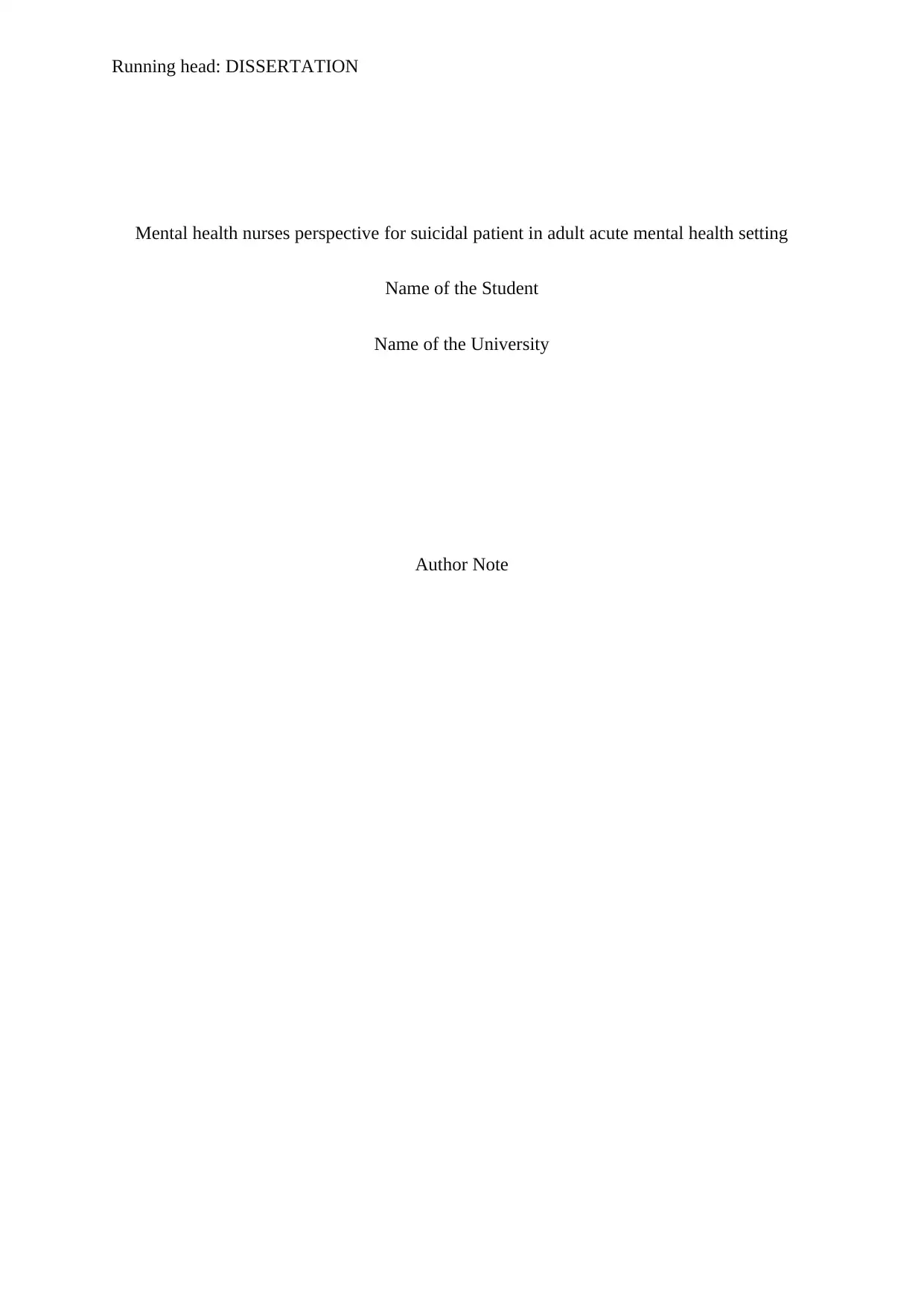
Running head: DISSERTATION
Mental health nurses perspective for suicidal patient in adult acute mental health setting
Name of the Student
Name of the University
Author Note
Mental health nurses perspective for suicidal patient in adult acute mental health setting
Name of the Student
Name of the University
Author Note
Secure Best Marks with AI Grader
Need help grading? Try our AI Grader for instant feedback on your assignments.
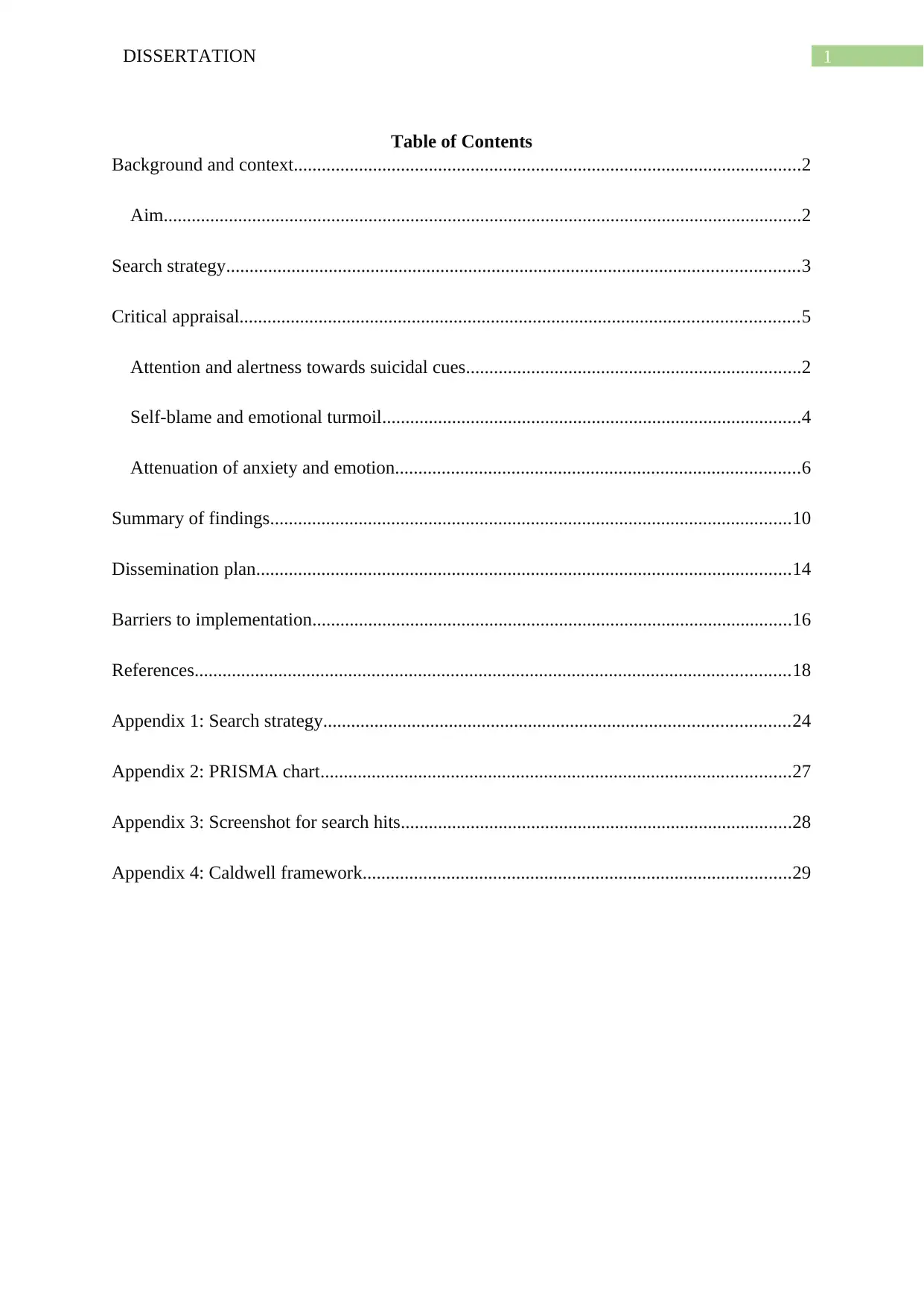
1DISSERTATION
Table of Contents
Background and context.............................................................................................................2
Aim.........................................................................................................................................2
Search strategy...........................................................................................................................3
Critical appraisal........................................................................................................................5
Attention and alertness towards suicidal cues........................................................................2
Self-blame and emotional turmoil..........................................................................................4
Attenuation of anxiety and emotion.......................................................................................6
Summary of findings................................................................................................................10
Dissemination plan...................................................................................................................14
Barriers to implementation.......................................................................................................16
References................................................................................................................................18
Appendix 1: Search strategy....................................................................................................24
Appendix 2: PRISMA chart.....................................................................................................27
Appendix 3: Screenshot for search hits....................................................................................28
Appendix 4: Caldwell framework............................................................................................29
Table of Contents
Background and context.............................................................................................................2
Aim.........................................................................................................................................2
Search strategy...........................................................................................................................3
Critical appraisal........................................................................................................................5
Attention and alertness towards suicidal cues........................................................................2
Self-blame and emotional turmoil..........................................................................................4
Attenuation of anxiety and emotion.......................................................................................6
Summary of findings................................................................................................................10
Dissemination plan...................................................................................................................14
Barriers to implementation.......................................................................................................16
References................................................................................................................................18
Appendix 1: Search strategy....................................................................................................24
Appendix 2: PRISMA chart.....................................................................................................27
Appendix 3: Screenshot for search hits....................................................................................28
Appendix 4: Caldwell framework............................................................................................29
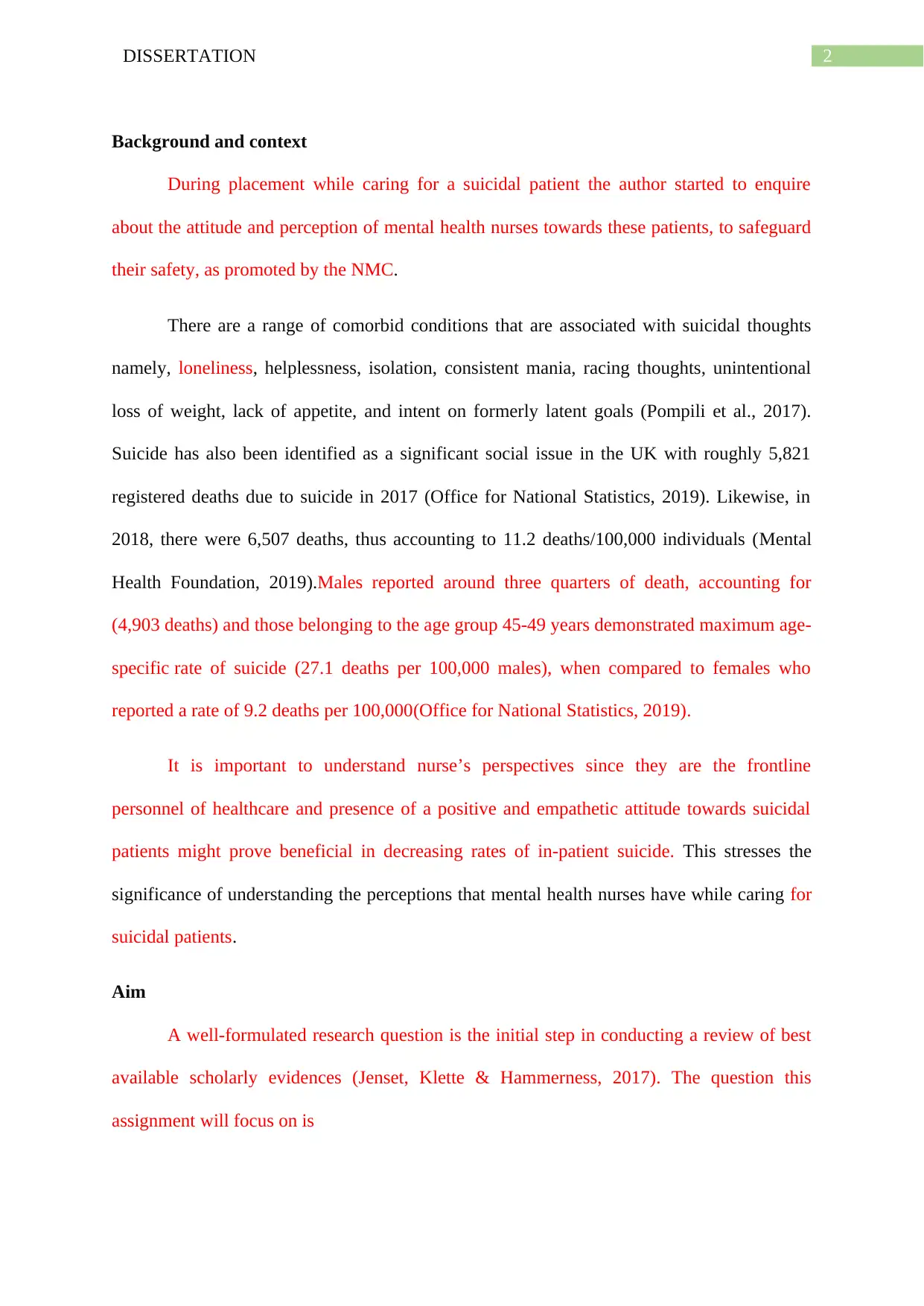
2DISSERTATION
Background and context
During placement while caring for a suicidal patient the author started to enquire
about the attitude and perception of mental health nurses towards these patients, to safeguard
their safety, as promoted by the NMC.
There are a range of comorbid conditions that are associated with suicidal thoughts
namely, loneliness, helplessness, isolation, consistent mania, racing thoughts, unintentional
loss of weight, lack of appetite, and intent on formerly latent goals (Pompili et al., 2017).
Suicide has also been identified as a significant social issue in the UK with roughly 5,821
registered deaths due to suicide in 2017 (Office for National Statistics, 2019). Likewise, in
2018, there were 6,507 deaths, thus accounting to 11.2 deaths/100,000 individuals (Mental
Health Foundation, 2019).Males reported around three quarters of death, accounting for
(4,903 deaths) and those belonging to the age group 45-49 years demonstrated maximum age-
specific rate of suicide (27.1 deaths per 100,000 males), when compared to females who
reported a rate of 9.2 deaths per 100,000(Office for National Statistics, 2019).
It is important to understand nurse’s perspectives since they are the frontline
personnel of healthcare and presence of a positive and empathetic attitude towards suicidal
patients might prove beneficial in decreasing rates of in-patient suicide. This stresses the
significance of understanding the perceptions that mental health nurses have while caring for
suicidal patients.
Aim
A well-formulated research question is the initial step in conducting a review of best
available scholarly evidences (Jenset, Klette & Hammerness, 2017). The question this
assignment will focus on is
Background and context
During placement while caring for a suicidal patient the author started to enquire
about the attitude and perception of mental health nurses towards these patients, to safeguard
their safety, as promoted by the NMC.
There are a range of comorbid conditions that are associated with suicidal thoughts
namely, loneliness, helplessness, isolation, consistent mania, racing thoughts, unintentional
loss of weight, lack of appetite, and intent on formerly latent goals (Pompili et al., 2017).
Suicide has also been identified as a significant social issue in the UK with roughly 5,821
registered deaths due to suicide in 2017 (Office for National Statistics, 2019). Likewise, in
2018, there were 6,507 deaths, thus accounting to 11.2 deaths/100,000 individuals (Mental
Health Foundation, 2019).Males reported around three quarters of death, accounting for
(4,903 deaths) and those belonging to the age group 45-49 years demonstrated maximum age-
specific rate of suicide (27.1 deaths per 100,000 males), when compared to females who
reported a rate of 9.2 deaths per 100,000(Office for National Statistics, 2019).
It is important to understand nurse’s perspectives since they are the frontline
personnel of healthcare and presence of a positive and empathetic attitude towards suicidal
patients might prove beneficial in decreasing rates of in-patient suicide. This stresses the
significance of understanding the perceptions that mental health nurses have while caring for
suicidal patients.
Aim
A well-formulated research question is the initial step in conducting a review of best
available scholarly evidences (Jenset, Klette & Hammerness, 2017). The question this
assignment will focus on is
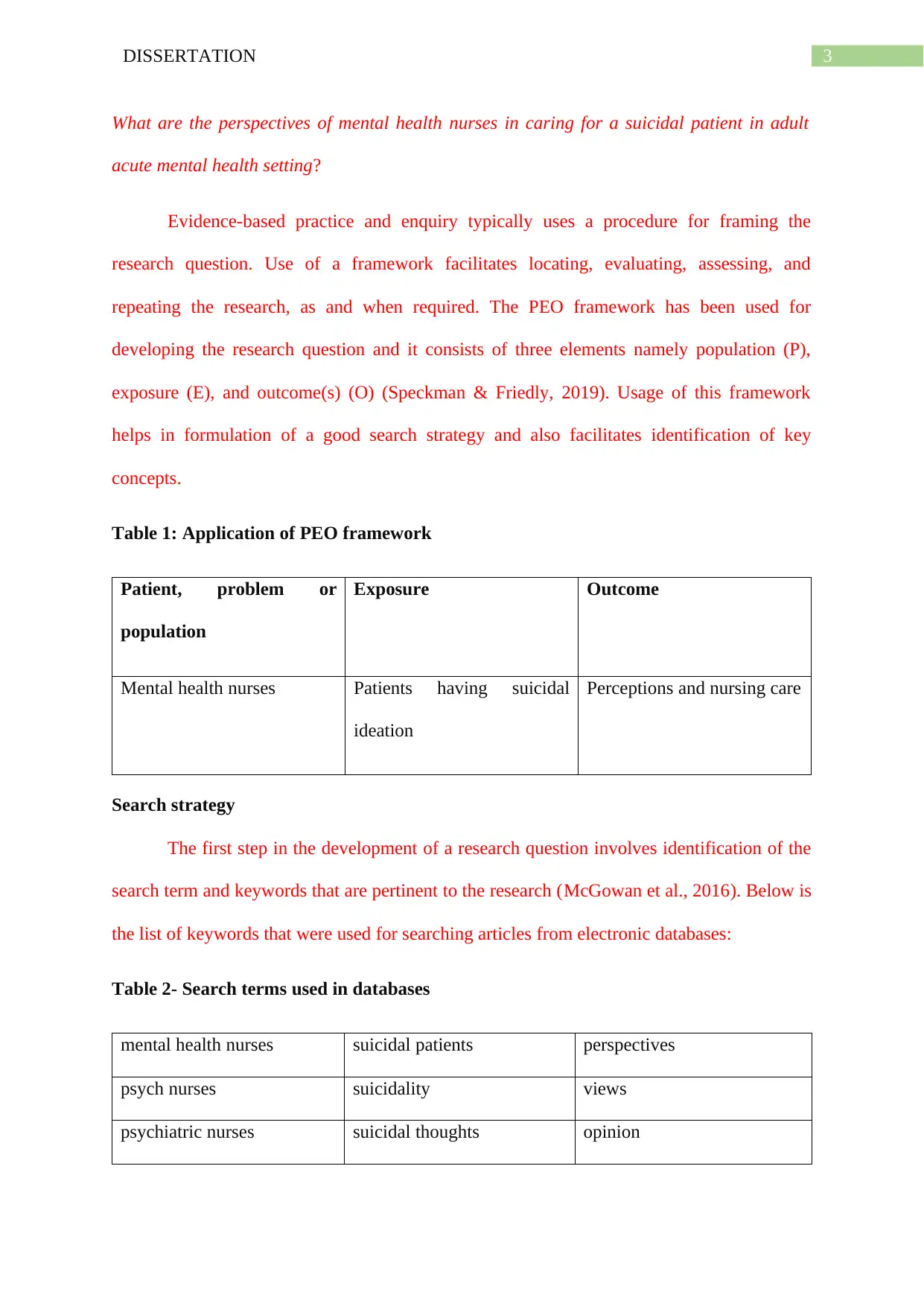
3DISSERTATION
What are the perspectives of mental health nurses in caring for a suicidal patient in adult
acute mental health setting?
Evidence-based practice and enquiry typically uses a procedure for framing the
research question. Use of a framework facilitates locating, evaluating, assessing, and
repeating the research, as and when required. The PEO framework has been used for
developing the research question and it consists of three elements namely population (P),
exposure (E), and outcome(s) (O) (Speckman & Friedly, 2019). Usage of this framework
helps in formulation of a good search strategy and also facilitates identification of key
concepts.
Table 1: Application of PEO framework
Patient, problem or
population
Exposure Outcome
Mental health nurses Patients having suicidal
ideation
Perceptions and nursing care
Search strategy
The first step in the development of a research question involves identification of the
search term and keywords that are pertinent to the research (McGowan et al., 2016). Below is
the list of keywords that were used for searching articles from electronic databases:
Table 2- Search terms used in databases
mental health nurses suicidal patients perspectives
psych nurses suicidality views
psychiatric nurses suicidal thoughts opinion
What are the perspectives of mental health nurses in caring for a suicidal patient in adult
acute mental health setting?
Evidence-based practice and enquiry typically uses a procedure for framing the
research question. Use of a framework facilitates locating, evaluating, assessing, and
repeating the research, as and when required. The PEO framework has been used for
developing the research question and it consists of three elements namely population (P),
exposure (E), and outcome(s) (O) (Speckman & Friedly, 2019). Usage of this framework
helps in formulation of a good search strategy and also facilitates identification of key
concepts.
Table 1: Application of PEO framework
Patient, problem or
population
Exposure Outcome
Mental health nurses Patients having suicidal
ideation
Perceptions and nursing care
Search strategy
The first step in the development of a research question involves identification of the
search term and keywords that are pertinent to the research (McGowan et al., 2016). Below is
the list of keywords that were used for searching articles from electronic databases:
Table 2- Search terms used in databases
mental health nurses suicidal patients perspectives
psych nurses suicidality views
psychiatric nurses suicidal thoughts opinion
Secure Best Marks with AI Grader
Need help grading? Try our AI Grader for instant feedback on your assignments.
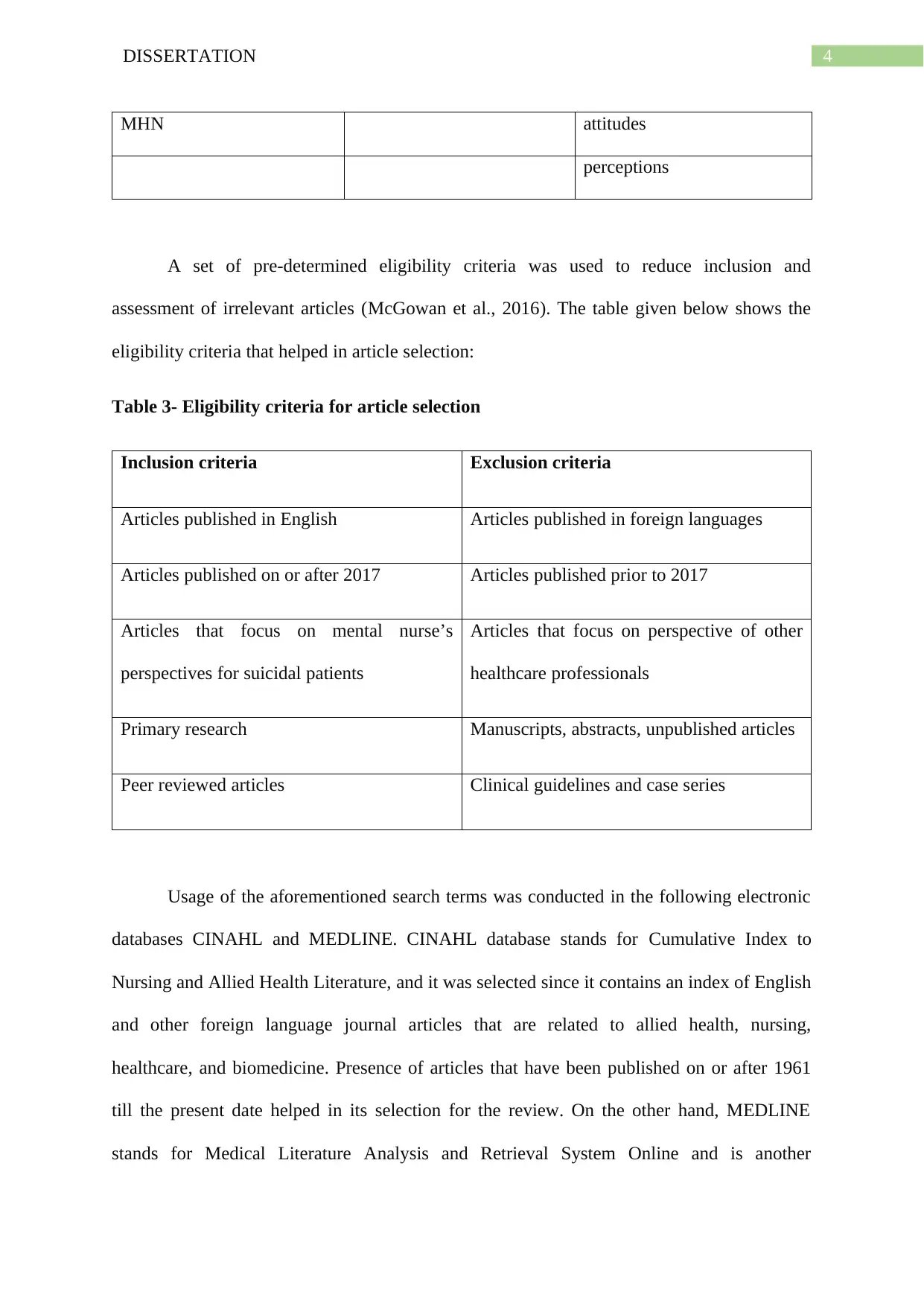
4DISSERTATION
MHN attitudes
perceptions
A set of pre-determined eligibility criteria was used to reduce inclusion and
assessment of irrelevant articles (McGowan et al., 2016). The table given below shows the
eligibility criteria that helped in article selection:
Table 3- Eligibility criteria for article selection
Inclusion criteria Exclusion criteria
Articles published in English Articles published in foreign languages
Articles published on or after 2017 Articles published prior to 2017
Articles that focus on mental nurse’s
perspectives for suicidal patients
Articles that focus on perspective of other
healthcare professionals
Primary research Manuscripts, abstracts, unpublished articles
Peer reviewed articles Clinical guidelines and case series
Usage of the aforementioned search terms was conducted in the following electronic
databases CINAHL and MEDLINE. CINAHL database stands for Cumulative Index to
Nursing and Allied Health Literature, and it was selected since it contains an index of English
and other foreign language journal articles that are related to allied health, nursing,
healthcare, and biomedicine. Presence of articles that have been published on or after 1961
till the present date helped in its selection for the review. On the other hand, MEDLINE
stands for Medical Literature Analysis and Retrieval System Online and is another
MHN attitudes
perceptions
A set of pre-determined eligibility criteria was used to reduce inclusion and
assessment of irrelevant articles (McGowan et al., 2016). The table given below shows the
eligibility criteria that helped in article selection:
Table 3- Eligibility criteria for article selection
Inclusion criteria Exclusion criteria
Articles published in English Articles published in foreign languages
Articles published on or after 2017 Articles published prior to 2017
Articles that focus on mental nurse’s
perspectives for suicidal patients
Articles that focus on perspective of other
healthcare professionals
Primary research Manuscripts, abstracts, unpublished articles
Peer reviewed articles Clinical guidelines and case series
Usage of the aforementioned search terms was conducted in the following electronic
databases CINAHL and MEDLINE. CINAHL database stands for Cumulative Index to
Nursing and Allied Health Literature, and it was selected since it contains an index of English
and other foreign language journal articles that are related to allied health, nursing,
healthcare, and biomedicine. Presence of articles that have been published on or after 1961
till the present date helped in its selection for the review. On the other hand, MEDLINE
stands for Medical Literature Analysis and Retrieval System Online and is another
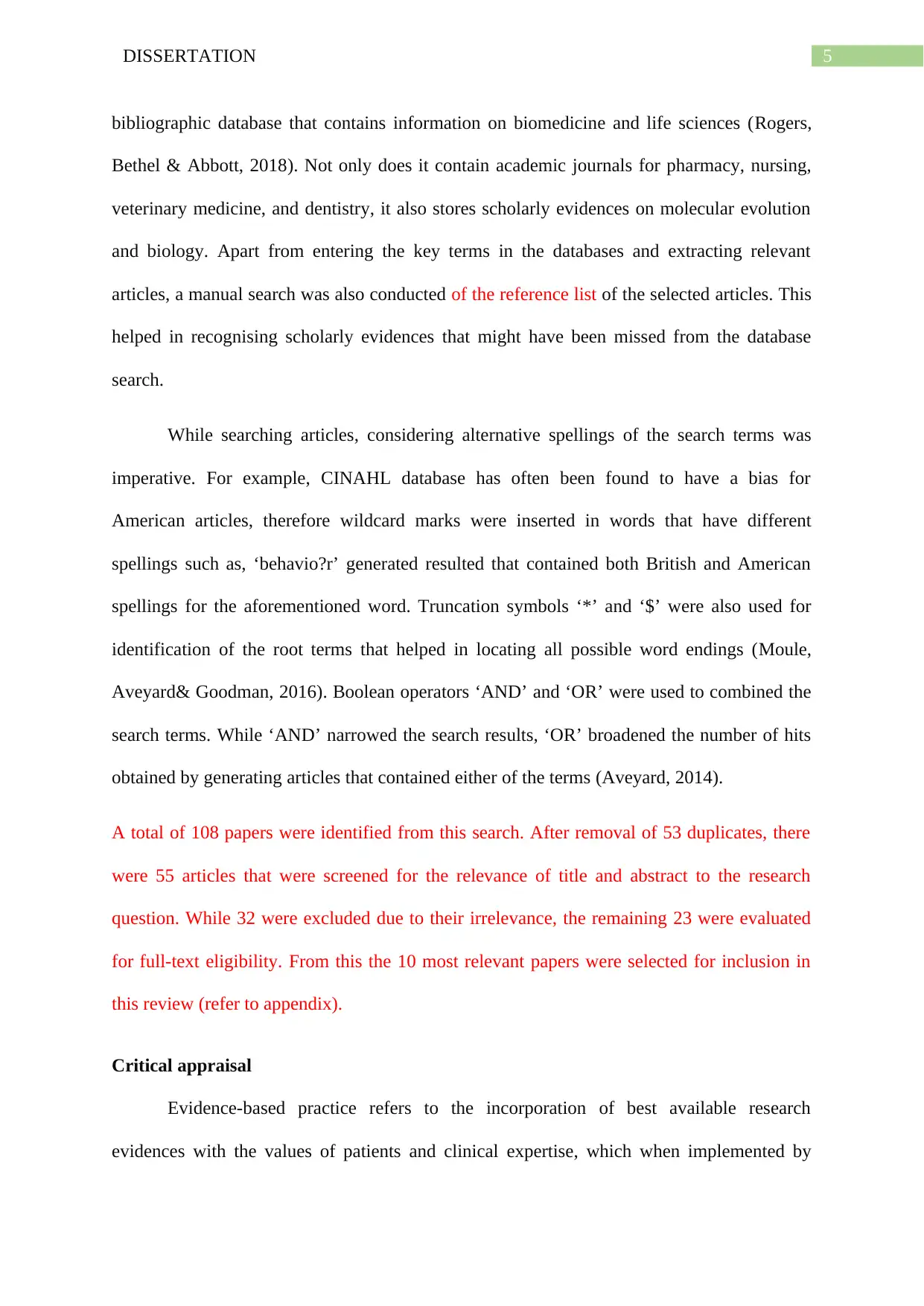
5DISSERTATION
bibliographic database that contains information on biomedicine and life sciences (Rogers,
Bethel & Abbott, 2018). Not only does it contain academic journals for pharmacy, nursing,
veterinary medicine, and dentistry, it also stores scholarly evidences on molecular evolution
and biology. Apart from entering the key terms in the databases and extracting relevant
articles, a manual search was also conducted of the reference list of the selected articles. This
helped in recognising scholarly evidences that might have been missed from the database
search.
While searching articles, considering alternative spellings of the search terms was
imperative. For example, CINAHL database has often been found to have a bias for
American articles, therefore wildcard marks were inserted in words that have different
spellings such as, ‘behavio?r’ generated resulted that contained both British and American
spellings for the aforementioned word. Truncation symbols ‘*’ and ‘$’ were also used for
identification of the root terms that helped in locating all possible word endings (Moule,
Aveyard& Goodman, 2016). Boolean operators ‘AND’ and ‘OR’ were used to combined the
search terms. While ‘AND’ narrowed the search results, ‘OR’ broadened the number of hits
obtained by generating articles that contained either of the terms (Aveyard, 2014).
A total of 108 papers were identified from this search. After removal of 53 duplicates, there
were 55 articles that were screened for the relevance of title and abstract to the research
question. While 32 were excluded due to their irrelevance, the remaining 23 were evaluated
for full-text eligibility. From this the 10 most relevant papers were selected for inclusion in
this review (refer to appendix).
Critical appraisal
Evidence-based practice refers to the incorporation of best available research
evidences with the values of patients and clinical expertise, which when implemented by
bibliographic database that contains information on biomedicine and life sciences (Rogers,
Bethel & Abbott, 2018). Not only does it contain academic journals for pharmacy, nursing,
veterinary medicine, and dentistry, it also stores scholarly evidences on molecular evolution
and biology. Apart from entering the key terms in the databases and extracting relevant
articles, a manual search was also conducted of the reference list of the selected articles. This
helped in recognising scholarly evidences that might have been missed from the database
search.
While searching articles, considering alternative spellings of the search terms was
imperative. For example, CINAHL database has often been found to have a bias for
American articles, therefore wildcard marks were inserted in words that have different
spellings such as, ‘behavio?r’ generated resulted that contained both British and American
spellings for the aforementioned word. Truncation symbols ‘*’ and ‘$’ were also used for
identification of the root terms that helped in locating all possible word endings (Moule,
Aveyard& Goodman, 2016). Boolean operators ‘AND’ and ‘OR’ were used to combined the
search terms. While ‘AND’ narrowed the search results, ‘OR’ broadened the number of hits
obtained by generating articles that contained either of the terms (Aveyard, 2014).
A total of 108 papers were identified from this search. After removal of 53 duplicates, there
were 55 articles that were screened for the relevance of title and abstract to the research
question. While 32 were excluded due to their irrelevance, the remaining 23 were evaluated
for full-text eligibility. From this the 10 most relevant papers were selected for inclusion in
this review (refer to appendix).
Critical appraisal
Evidence-based practice refers to the incorporation of best available research
evidences with the values of patients and clinical expertise, which when implemented by
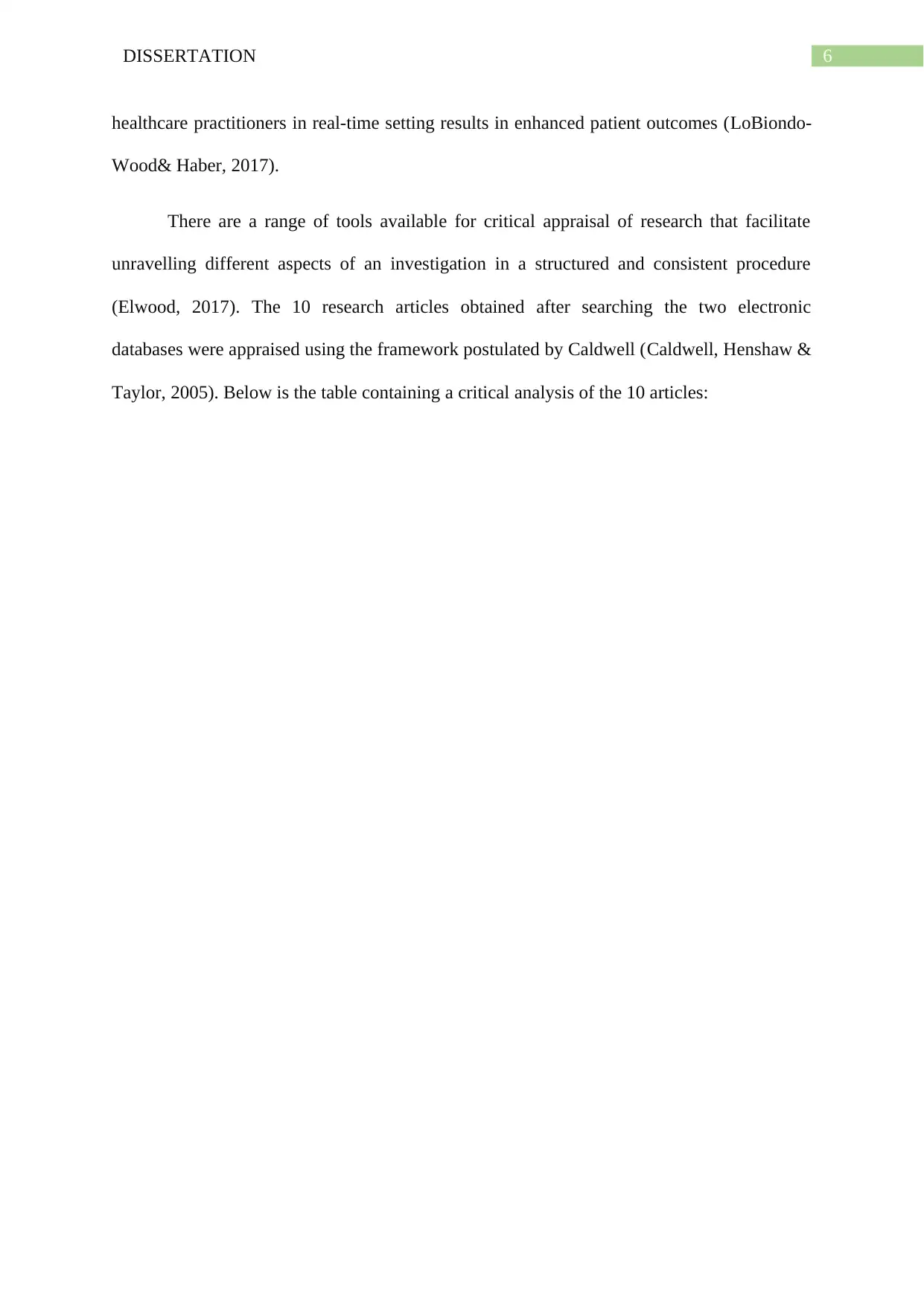
6DISSERTATION
healthcare practitioners in real-time setting results in enhanced patient outcomes (LoBiondo-
Wood& Haber, 2017).
There are a range of tools available for critical appraisal of research that facilitate
unravelling different aspects of an investigation in a structured and consistent procedure
(Elwood, 2017). The 10 research articles obtained after searching the two electronic
databases were appraised using the framework postulated by Caldwell (Caldwell, Henshaw &
Taylor, 2005). Below is the table containing a critical analysis of the 10 articles:
healthcare practitioners in real-time setting results in enhanced patient outcomes (LoBiondo-
Wood& Haber, 2017).
There are a range of tools available for critical appraisal of research that facilitate
unravelling different aspects of an investigation in a structured and consistent procedure
(Elwood, 2017). The 10 research articles obtained after searching the two electronic
databases were appraised using the framework postulated by Caldwell (Caldwell, Henshaw &
Taylor, 2005). Below is the table containing a critical analysis of the 10 articles:
Paraphrase This Document
Need a fresh take? Get an instant paraphrase of this document with our AI Paraphraser
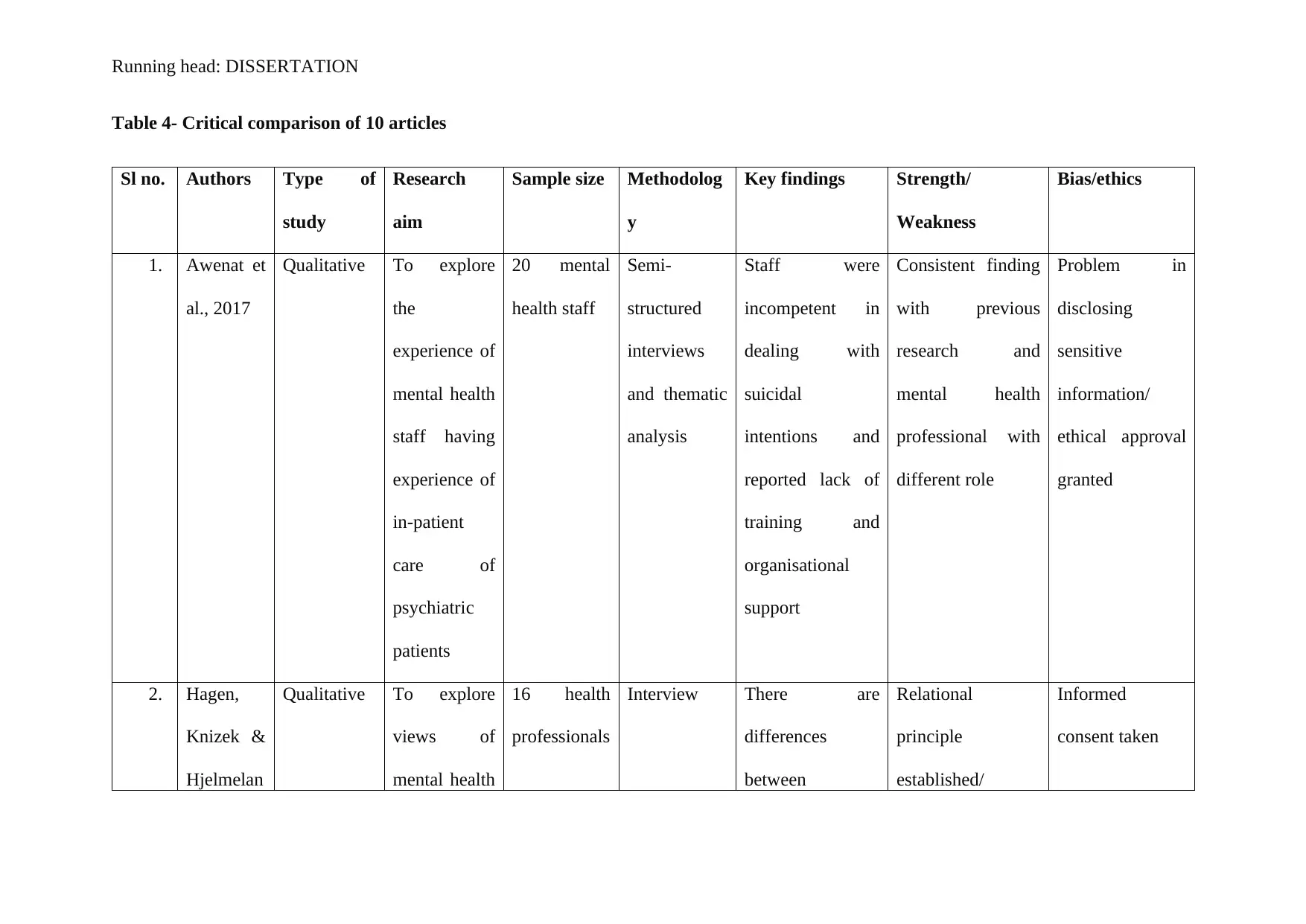
Running head: DISSERTATION
Table 4- Critical comparison of 10 articles
Sl no. Authors Type of
study
Research
aim
Sample size Methodolog
y
Key findings Strength/
Weakness
Bias/ethics
1. Awenat et
al., 2017
Qualitative To explore
the
experience of
mental health
staff having
experience of
in-patient
care of
psychiatric
patients
20 mental
health staff
Semi-
structured
interviews
and thematic
analysis
Staff were
incompetent in
dealing with
suicidal
intentions and
reported lack of
training and
organisational
support
Consistent finding
with previous
research and
mental health
professional with
different role
Problem in
disclosing
sensitive
information/
ethical approval
granted
2. Hagen,
Knizek &
Hjelmelan
Qualitative To explore
views of
mental health
16 health
professionals
Interview There are
differences
between
Relational
principle
established/
Informed
consent taken
Table 4- Critical comparison of 10 articles
Sl no. Authors Type of
study
Research
aim
Sample size Methodolog
y
Key findings Strength/
Weakness
Bias/ethics
1. Awenat et
al., 2017
Qualitative To explore
the
experience of
mental health
staff having
experience of
in-patient
care of
psychiatric
patients
20 mental
health staff
Semi-
structured
interviews
and thematic
analysis
Staff were
incompetent in
dealing with
suicidal
intentions and
reported lack of
training and
organisational
support
Consistent finding
with previous
research and
mental health
professional with
different role
Problem in
disclosing
sensitive
information/
ethical approval
granted
2. Hagen,
Knizek &
Hjelmelan
Qualitative To explore
views of
mental health
16 health
professionals
Interview There are
differences
between
Relational
principle
established/
Informed
consent taken
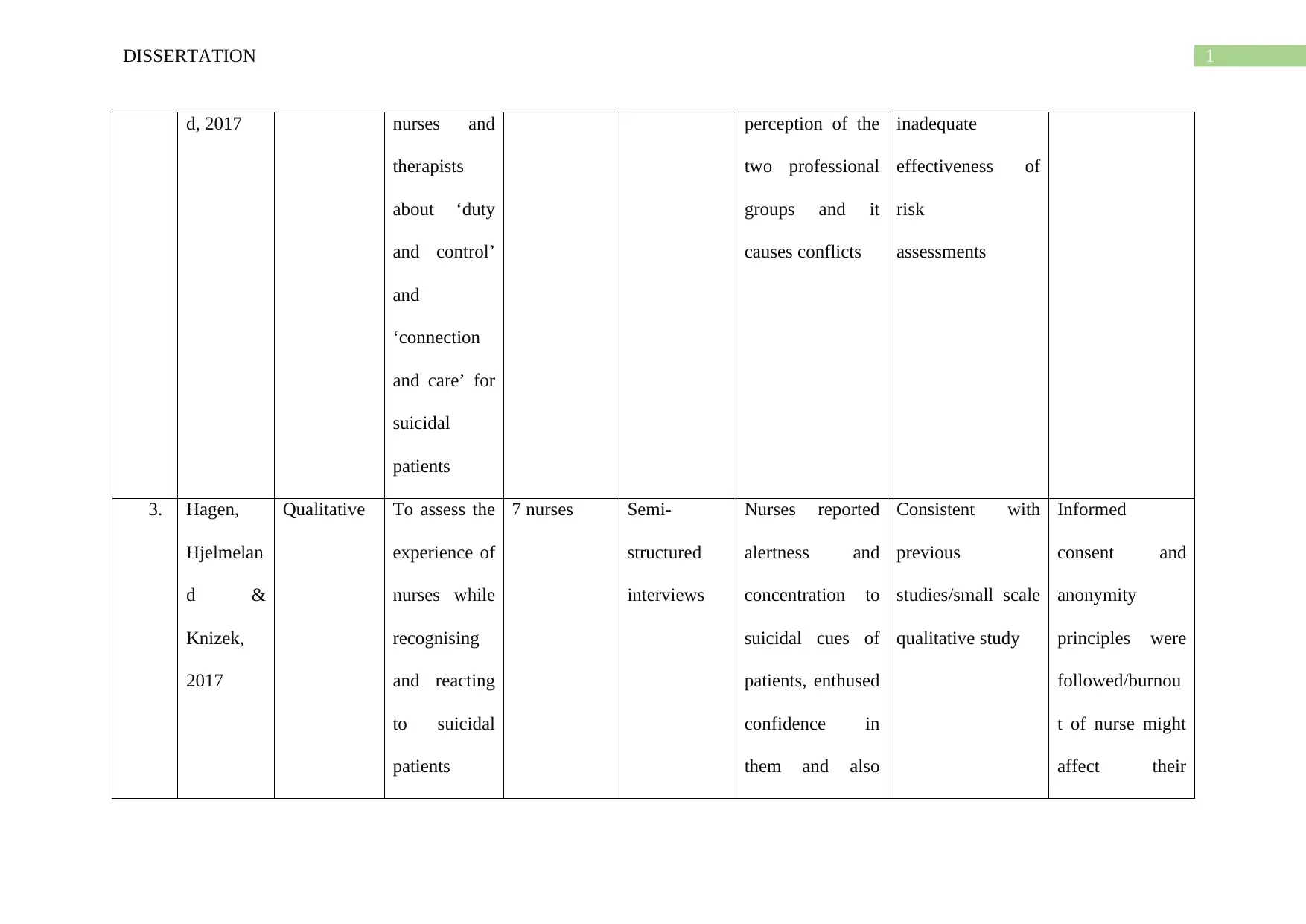
1DISSERTATION
d, 2017 nurses and
therapists
about ‘duty
and control’
and
‘connection
and care’ for
suicidal
patients
perception of the
two professional
groups and it
causes conflicts
inadequate
effectiveness of
risk
assessments
3. Hagen,
Hjelmelan
d &
Knizek,
2017
Qualitative To assess the
experience of
nurses while
recognising
and reacting
to suicidal
patients
7 nurses Semi-
structured
interviews
Nurses reported
alertness and
concentration to
suicidal cues of
patients, enthused
confidence in
them and also
Consistent with
previous
studies/small scale
qualitative study
Informed
consent and
anonymity
principles were
followed/burnou
t of nurse might
affect their
d, 2017 nurses and
therapists
about ‘duty
and control’
and
‘connection
and care’ for
suicidal
patients
perception of the
two professional
groups and it
causes conflicts
inadequate
effectiveness of
risk
assessments
3. Hagen,
Hjelmelan
d &
Knizek,
2017
Qualitative To assess the
experience of
nurses while
recognising
and reacting
to suicidal
patients
7 nurses Semi-
structured
interviews
Nurses reported
alertness and
concentration to
suicidal cues of
patients, enthused
confidence in
them and also
Consistent with
previous
studies/small scale
qualitative study
Informed
consent and
anonymity
principles were
followed/burnou
t of nurse might
affect their
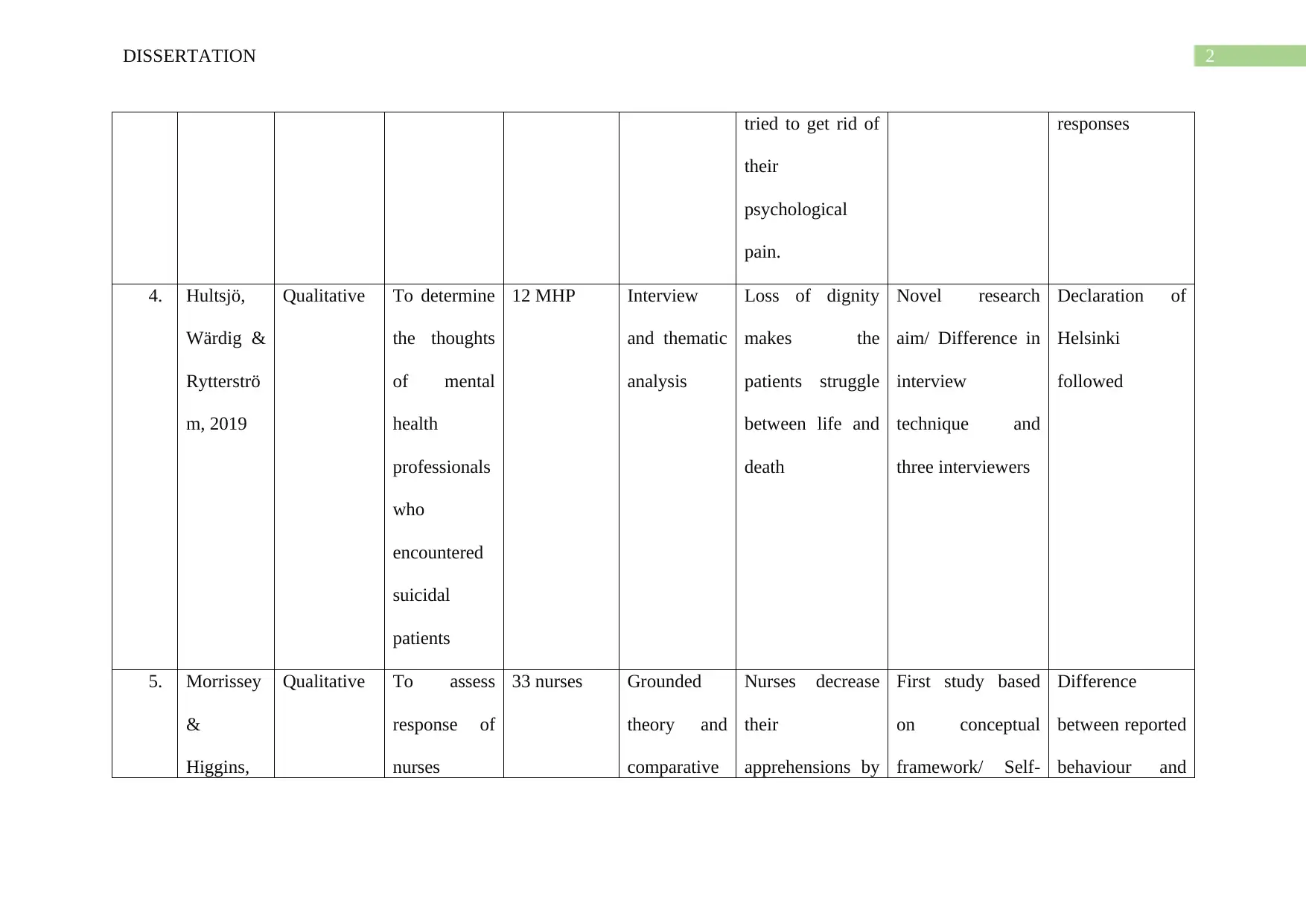
2DISSERTATION
tried to get rid of
their
psychological
pain.
responses
4. Hultsjö,
Wärdig &
Rytterströ
m, 2019
Qualitative To determine
the thoughts
of mental
health
professionals
who
encountered
suicidal
patients
12 MHP Interview
and thematic
analysis
Loss of dignity
makes the
patients struggle
between life and
death
Novel research
aim/ Difference in
interview
technique and
three interviewers
Declaration of
Helsinki
followed
5. Morrissey
&
Higgins,
Qualitative To assess
response of
nurses
33 nurses Grounded
theory and
comparative
Nurses decrease
their
apprehensions by
First study based
on conceptual
framework/ Self-
Difference
between reported
behaviour and
tried to get rid of
their
psychological
pain.
responses
4. Hultsjö,
Wärdig &
Rytterströ
m, 2019
Qualitative To determine
the thoughts
of mental
health
professionals
who
encountered
suicidal
patients
12 MHP Interview
and thematic
analysis
Loss of dignity
makes the
patients struggle
between life and
death
Novel research
aim/ Difference in
interview
technique and
three interviewers
Declaration of
Helsinki
followed
5. Morrissey
&
Higgins,
Qualitative To assess
response of
nurses
33 nurses Grounded
theory and
comparative
Nurses decrease
their
apprehensions by
First study based
on conceptual
framework/ Self-
Difference
between reported
behaviour and
Secure Best Marks with AI Grader
Need help grading? Try our AI Grader for instant feedback on your assignments.
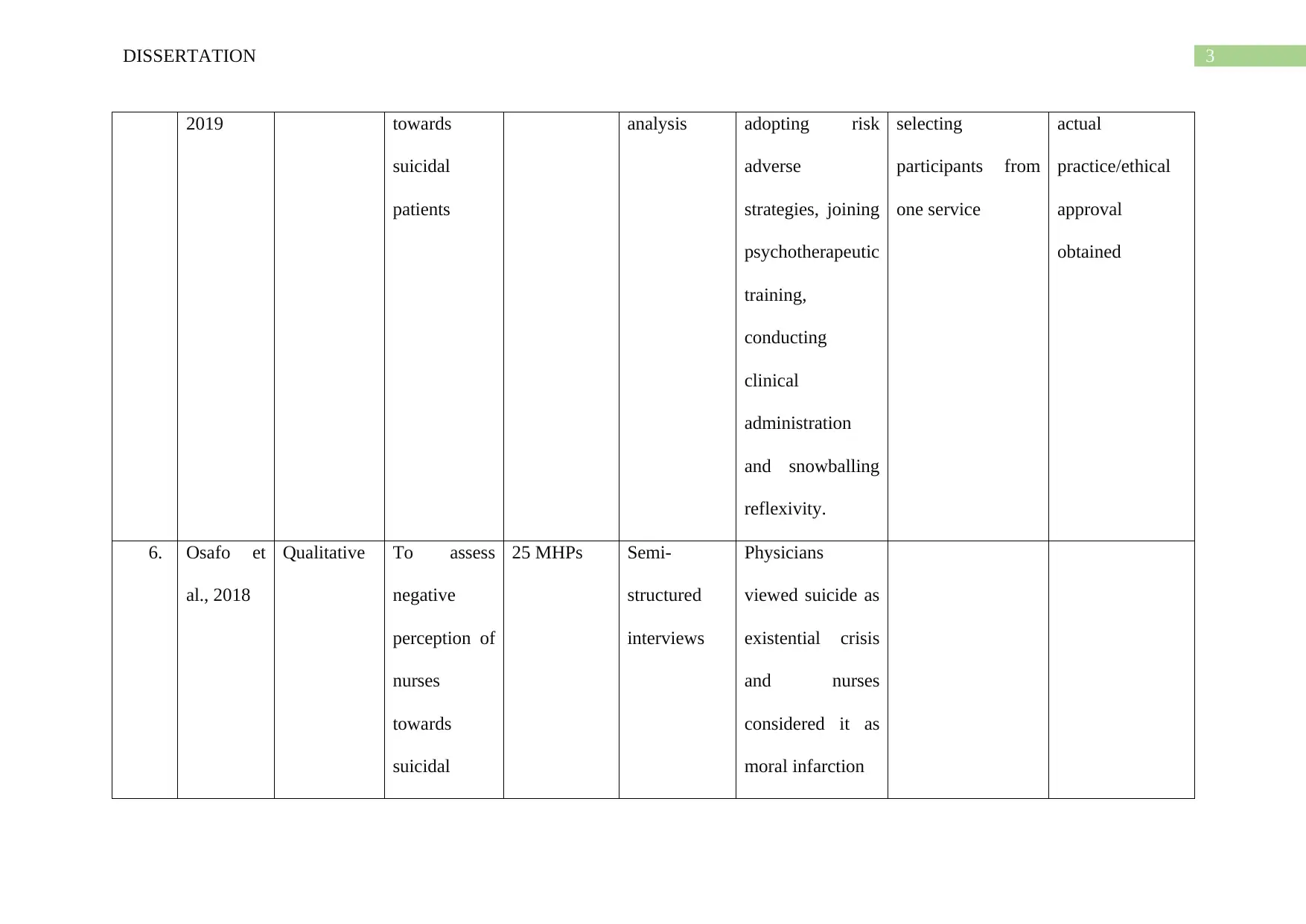
3DISSERTATION
2019 towards
suicidal
patients
analysis adopting risk
adverse
strategies, joining
psychotherapeutic
training,
conducting
clinical
administration
and snowballing
reflexivity.
selecting
participants from
one service
actual
practice/ethical
approval
obtained
6. Osafo et
al., 2018
Qualitative To assess
negative
perception of
nurses
towards
suicidal
25 MHPs Semi-
structured
interviews
Physicians
viewed suicide as
existential crisis
and nurses
considered it as
moral infarction
2019 towards
suicidal
patients
analysis adopting risk
adverse
strategies, joining
psychotherapeutic
training,
conducting
clinical
administration
and snowballing
reflexivity.
selecting
participants from
one service
actual
practice/ethical
approval
obtained
6. Osafo et
al., 2018
Qualitative To assess
negative
perception of
nurses
towards
suicidal
25 MHPs Semi-
structured
interviews
Physicians
viewed suicide as
existential crisis
and nurses
considered it as
moral infarction
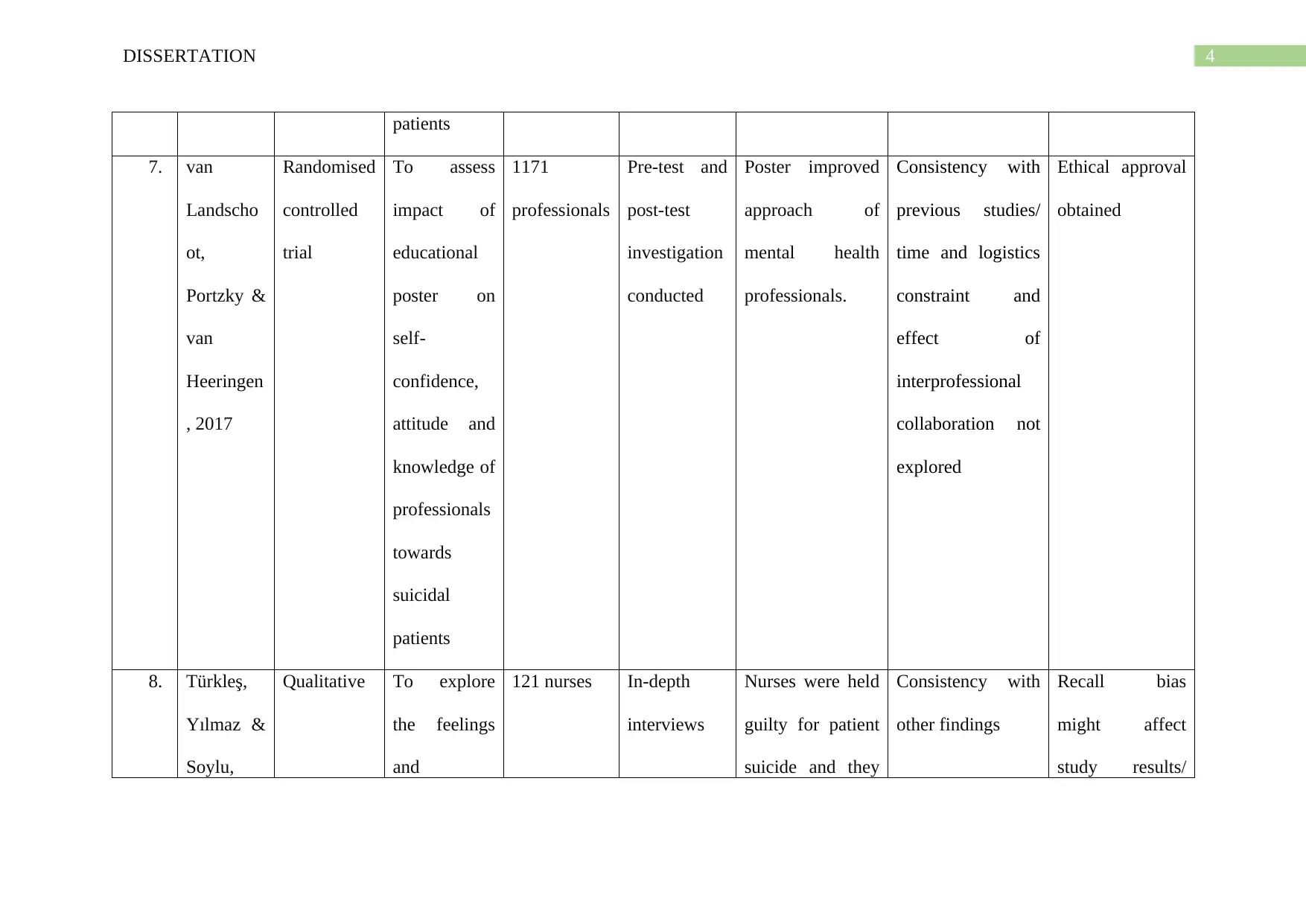
4DISSERTATION
patients
7. van
Landscho
ot,
Portzky &
van
Heeringen
, 2017
Randomised
controlled
trial
To assess
impact of
educational
poster on
self-
confidence,
attitude and
knowledge of
professionals
towards
suicidal
patients
1171
professionals
Pre-test and
post-test
investigation
conducted
Poster improved
approach of
mental health
professionals.
Consistency with
previous studies/
time and logistics
constraint and
effect of
interprofessional
collaboration not
explored
Ethical approval
obtained
8. Türkleş,
Yılmaz &
Soylu,
Qualitative To explore
the feelings
and
121 nurses In-depth
interviews
Nurses were held
guilty for patient
suicide and they
Consistency with
other findings
Recall bias
might affect
study results/
patients
7. van
Landscho
ot,
Portzky &
van
Heeringen
, 2017
Randomised
controlled
trial
To assess
impact of
educational
poster on
self-
confidence,
attitude and
knowledge of
professionals
towards
suicidal
patients
1171
professionals
Pre-test and
post-test
investigation
conducted
Poster improved
approach of
mental health
professionals.
Consistency with
previous studies/
time and logistics
constraint and
effect of
interprofessional
collaboration not
explored
Ethical approval
obtained
8. Türkleş,
Yılmaz &
Soylu,
Qualitative To explore
the feelings
and
121 nurses In-depth
interviews
Nurses were held
guilty for patient
suicide and they
Consistency with
other findings
Recall bias
might affect
study results/
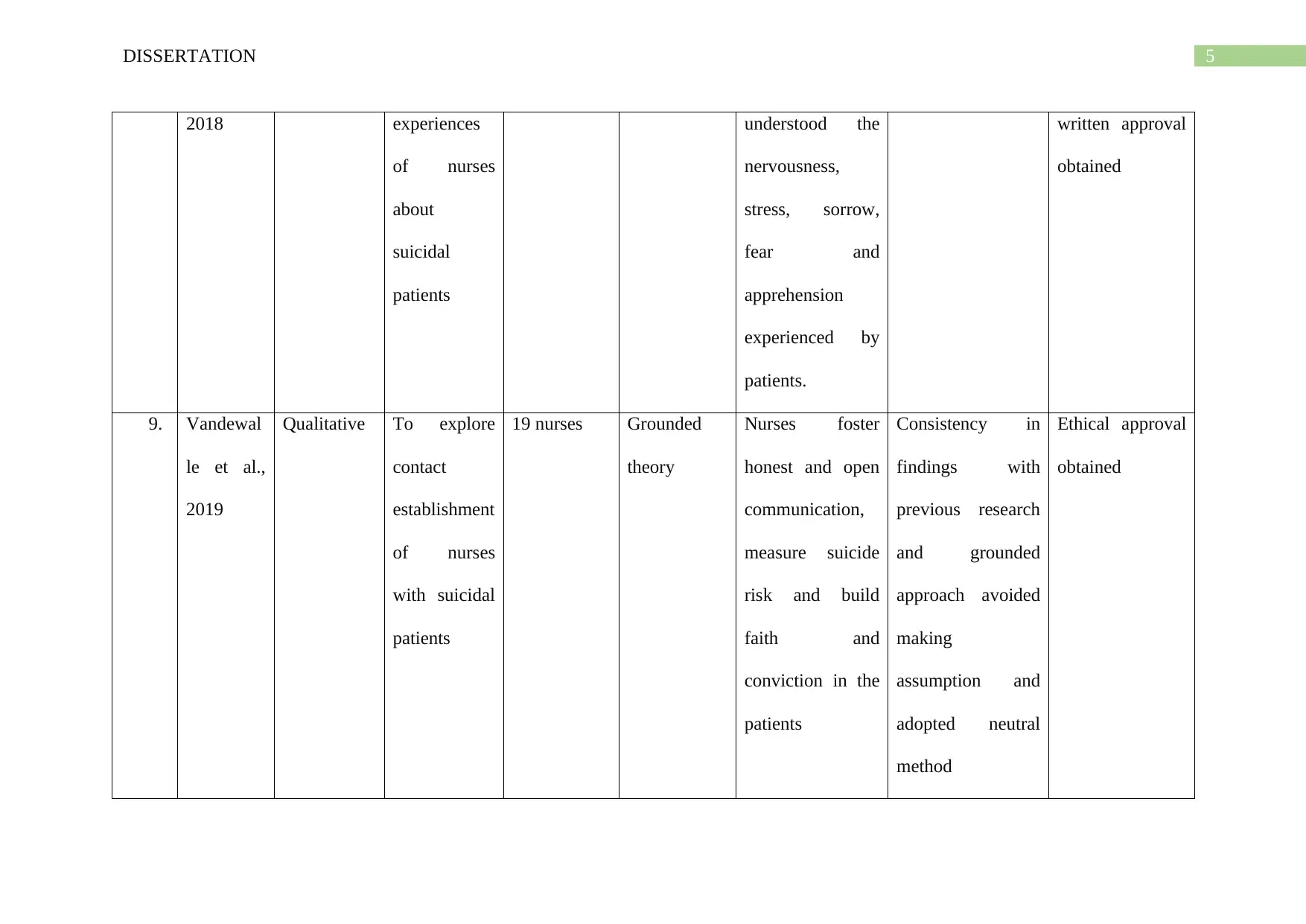
5DISSERTATION
2018 experiences
of nurses
about
suicidal
patients
understood the
nervousness,
stress, sorrow,
fear and
apprehension
experienced by
patients.
written approval
obtained
9. Vandewal
le et al.,
2019
Qualitative To explore
contact
establishment
of nurses
with suicidal
patients
19 nurses Grounded
theory
Nurses foster
honest and open
communication,
measure suicide
risk and build
faith and
conviction in the
patients
Consistency in
findings with
previous research
and grounded
approach avoided
making
assumption and
adopted neutral
method
Ethical approval
obtained
2018 experiences
of nurses
about
suicidal
patients
understood the
nervousness,
stress, sorrow,
fear and
apprehension
experienced by
patients.
written approval
obtained
9. Vandewal
le et al.,
2019
Qualitative To explore
contact
establishment
of nurses
with suicidal
patients
19 nurses Grounded
theory
Nurses foster
honest and open
communication,
measure suicide
risk and build
faith and
conviction in the
patients
Consistency in
findings with
previous research
and grounded
approach avoided
making
assumption and
adopted neutral
method
Ethical approval
obtained
Paraphrase This Document
Need a fresh take? Get an instant paraphrase of this document with our AI Paraphraser
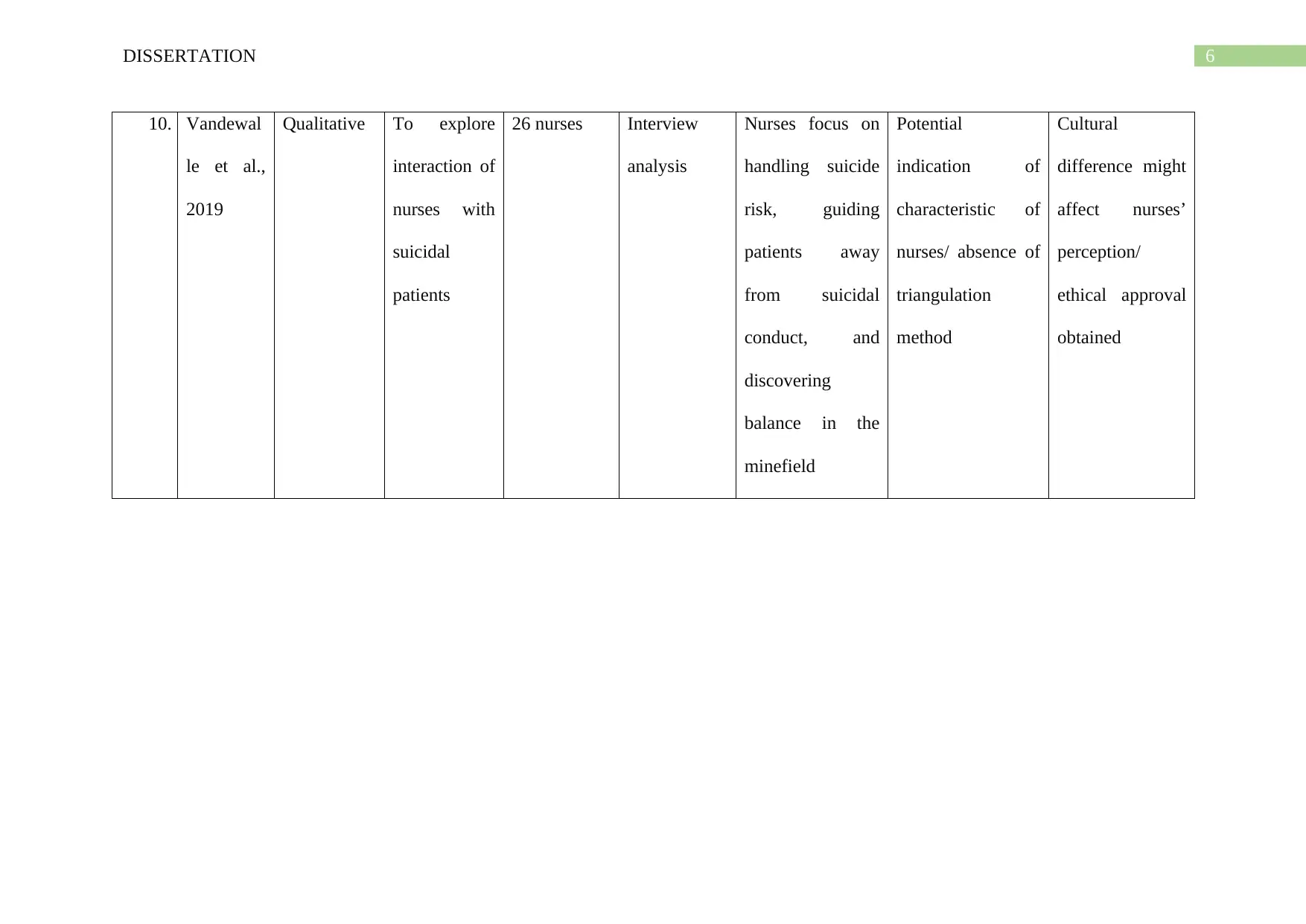
6DISSERTATION
10. Vandewal
le et al.,
2019
Qualitative To explore
interaction of
nurses with
suicidal
patients
26 nurses Interview
analysis
Nurses focus on
handling suicide
risk, guiding
patients away
from suicidal
conduct, and
discovering
balance in the
minefield
Potential
indication of
characteristic of
nurses/ absence of
triangulation
method
Cultural
difference might
affect nurses’
perception/
ethical approval
obtained
10. Vandewal
le et al.,
2019
Qualitative To explore
interaction of
nurses with
suicidal
patients
26 nurses Interview
analysis
Nurses focus on
handling suicide
risk, guiding
patients away
from suicidal
conduct, and
discovering
balance in the
minefield
Potential
indication of
characteristic of
nurses/ absence of
triangulation
method
Cultural
difference might
affect nurses’
perception/
ethical approval
obtained
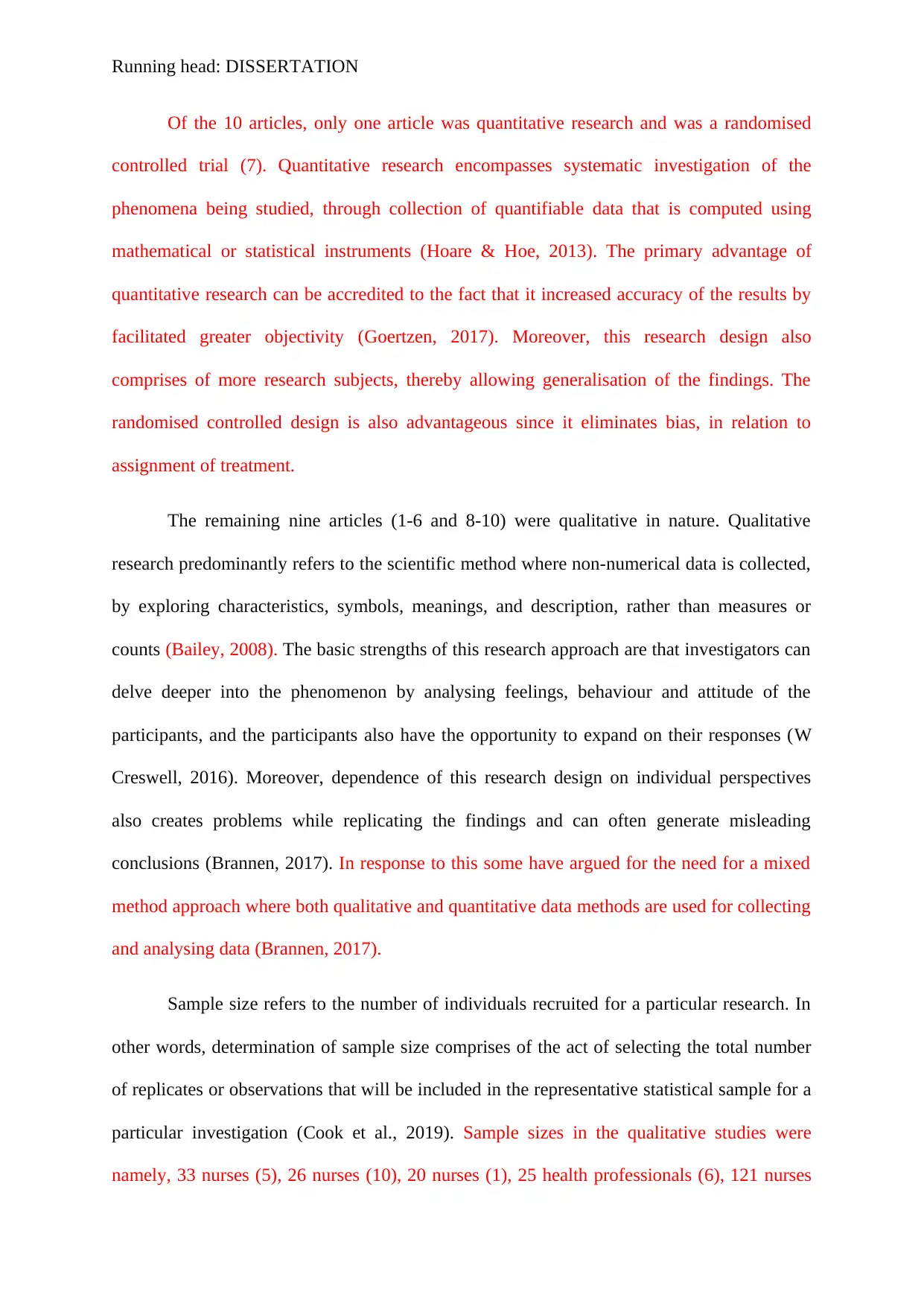
Running head: DISSERTATION
Of the 10 articles, only one article was quantitative research and was a randomised
controlled trial (7). Quantitative research encompasses systematic investigation of the
phenomena being studied, through collection of quantifiable data that is computed using
mathematical or statistical instruments (Hoare & Hoe, 2013). The primary advantage of
quantitative research can be accredited to the fact that it increased accuracy of the results by
facilitated greater objectivity (Goertzen, 2017). Moreover, this research design also
comprises of more research subjects, thereby allowing generalisation of the findings. The
randomised controlled design is also advantageous since it eliminates bias, in relation to
assignment of treatment.
The remaining nine articles (1-6 and 8-10) were qualitative in nature. Qualitative
research predominantly refers to the scientific method where non-numerical data is collected,
by exploring characteristics, symbols, meanings, and description, rather than measures or
counts (Bailey, 2008). The basic strengths of this research approach are that investigators can
delve deeper into the phenomenon by analysing feelings, behaviour and attitude of the
participants, and the participants also have the opportunity to expand on their responses (W
Creswell, 2016). Moreover, dependence of this research design on individual perspectives
also creates problems while replicating the findings and can often generate misleading
conclusions (Brannen, 2017). In response to this some have argued for the need for a mixed
method approach where both qualitative and quantitative data methods are used for collecting
and analysing data (Brannen, 2017).
Sample size refers to the number of individuals recruited for a particular research. In
other words, determination of sample size comprises of the act of selecting the total number
of replicates or observations that will be included in the representative statistical sample for a
particular investigation (Cook et al., 2019). Sample sizes in the qualitative studies were
namely, 33 nurses (5), 26 nurses (10), 20 nurses (1), 25 health professionals (6), 121 nurses
Of the 10 articles, only one article was quantitative research and was a randomised
controlled trial (7). Quantitative research encompasses systematic investigation of the
phenomena being studied, through collection of quantifiable data that is computed using
mathematical or statistical instruments (Hoare & Hoe, 2013). The primary advantage of
quantitative research can be accredited to the fact that it increased accuracy of the results by
facilitated greater objectivity (Goertzen, 2017). Moreover, this research design also
comprises of more research subjects, thereby allowing generalisation of the findings. The
randomised controlled design is also advantageous since it eliminates bias, in relation to
assignment of treatment.
The remaining nine articles (1-6 and 8-10) were qualitative in nature. Qualitative
research predominantly refers to the scientific method where non-numerical data is collected,
by exploring characteristics, symbols, meanings, and description, rather than measures or
counts (Bailey, 2008). The basic strengths of this research approach are that investigators can
delve deeper into the phenomenon by analysing feelings, behaviour and attitude of the
participants, and the participants also have the opportunity to expand on their responses (W
Creswell, 2016). Moreover, dependence of this research design on individual perspectives
also creates problems while replicating the findings and can often generate misleading
conclusions (Brannen, 2017). In response to this some have argued for the need for a mixed
method approach where both qualitative and quantitative data methods are used for collecting
and analysing data (Brannen, 2017).
Sample size refers to the number of individuals recruited for a particular research. In
other words, determination of sample size comprises of the act of selecting the total number
of replicates or observations that will be included in the representative statistical sample for a
particular investigation (Cook et al., 2019). Sample sizes in the qualitative studies were
namely, 33 nurses (5), 26 nurses (10), 20 nurses (1), 25 health professionals (6), 121 nurses
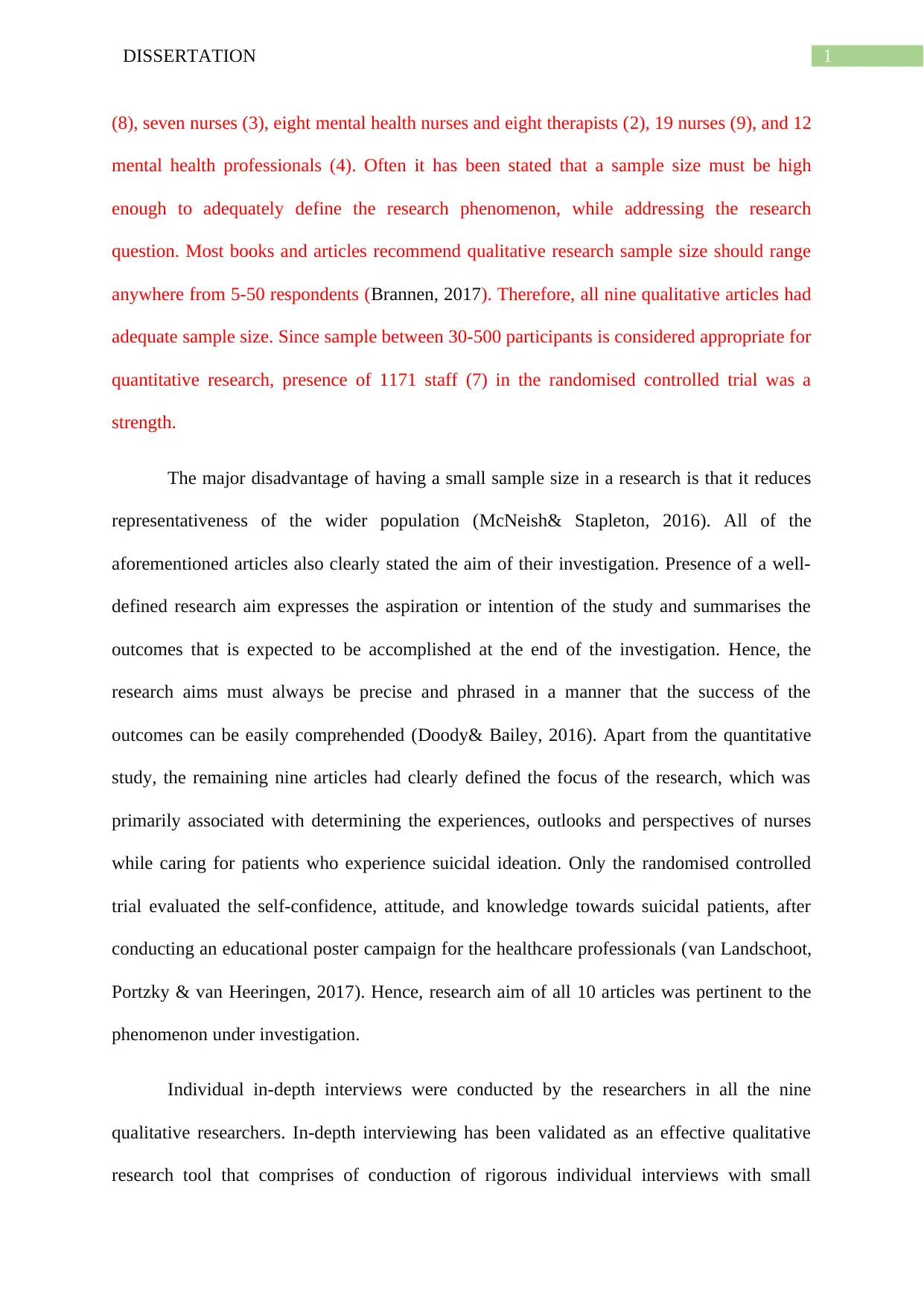
1DISSERTATION
(8), seven nurses (3), eight mental health nurses and eight therapists (2), 19 nurses (9), and 12
mental health professionals (4). Often it has been stated that a sample size must be high
enough to adequately define the research phenomenon, while addressing the research
question. Most books and articles recommend qualitative research sample size should range
anywhere from 5-50 respondents (Brannen, 2017). Therefore, all nine qualitative articles had
adequate sample size. Since sample between 30-500 participants is considered appropriate for
quantitative research, presence of 1171 staff (7) in the randomised controlled trial was a
strength.
The major disadvantage of having a small sample size in a research is that it reduces
representativeness of the wider population (McNeish& Stapleton, 2016). All of the
aforementioned articles also clearly stated the aim of their investigation. Presence of a well-
defined research aim expresses the aspiration or intention of the study and summarises the
outcomes that is expected to be accomplished at the end of the investigation. Hence, the
research aims must always be precise and phrased in a manner that the success of the
outcomes can be easily comprehended (Doody& Bailey, 2016). Apart from the quantitative
study, the remaining nine articles had clearly defined the focus of the research, which was
primarily associated with determining the experiences, outlooks and perspectives of nurses
while caring for patients who experience suicidal ideation. Only the randomised controlled
trial evaluated the self-confidence, attitude, and knowledge towards suicidal patients, after
conducting an educational poster campaign for the healthcare professionals (van Landschoot,
Portzky & van Heeringen, 2017). Hence, research aim of all 10 articles was pertinent to the
phenomenon under investigation.
Individual in-depth interviews were conducted by the researchers in all the nine
qualitative researchers. In-depth interviewing has been validated as an effective qualitative
research tool that comprises of conduction of rigorous individual interviews with small
(8), seven nurses (3), eight mental health nurses and eight therapists (2), 19 nurses (9), and 12
mental health professionals (4). Often it has been stated that a sample size must be high
enough to adequately define the research phenomenon, while addressing the research
question. Most books and articles recommend qualitative research sample size should range
anywhere from 5-50 respondents (Brannen, 2017). Therefore, all nine qualitative articles had
adequate sample size. Since sample between 30-500 participants is considered appropriate for
quantitative research, presence of 1171 staff (7) in the randomised controlled trial was a
strength.
The major disadvantage of having a small sample size in a research is that it reduces
representativeness of the wider population (McNeish& Stapleton, 2016). All of the
aforementioned articles also clearly stated the aim of their investigation. Presence of a well-
defined research aim expresses the aspiration or intention of the study and summarises the
outcomes that is expected to be accomplished at the end of the investigation. Hence, the
research aims must always be precise and phrased in a manner that the success of the
outcomes can be easily comprehended (Doody& Bailey, 2016). Apart from the quantitative
study, the remaining nine articles had clearly defined the focus of the research, which was
primarily associated with determining the experiences, outlooks and perspectives of nurses
while caring for patients who experience suicidal ideation. Only the randomised controlled
trial evaluated the self-confidence, attitude, and knowledge towards suicidal patients, after
conducting an educational poster campaign for the healthcare professionals (van Landschoot,
Portzky & van Heeringen, 2017). Hence, research aim of all 10 articles was pertinent to the
phenomenon under investigation.
Individual in-depth interviews were conducted by the researchers in all the nine
qualitative researchers. In-depth interviewing has been validated as an effective qualitative
research tool that comprises of conduction of rigorous individual interviews with small
Secure Best Marks with AI Grader
Need help grading? Try our AI Grader for instant feedback on your assignments.
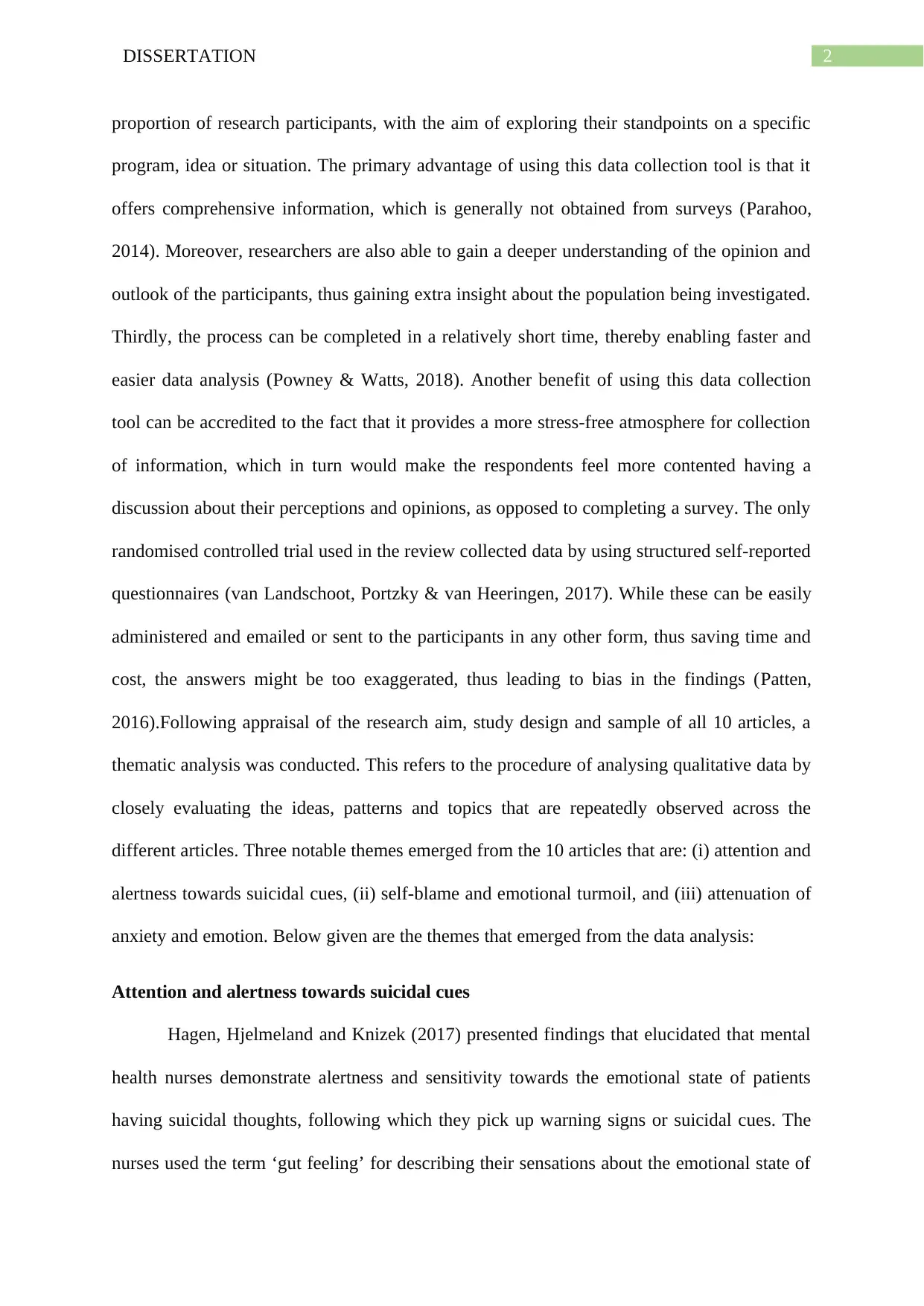
2DISSERTATION
proportion of research participants, with the aim of exploring their standpoints on a specific
program, idea or situation. The primary advantage of using this data collection tool is that it
offers comprehensive information, which is generally not obtained from surveys (Parahoo,
2014). Moreover, researchers are also able to gain a deeper understanding of the opinion and
outlook of the participants, thus gaining extra insight about the population being investigated.
Thirdly, the process can be completed in a relatively short time, thereby enabling faster and
easier data analysis (Powney & Watts, 2018). Another benefit of using this data collection
tool can be accredited to the fact that it provides a more stress-free atmosphere for collection
of information, which in turn would make the respondents feel more contented having a
discussion about their perceptions and opinions, as opposed to completing a survey. The only
randomised controlled trial used in the review collected data by using structured self-reported
questionnaires (van Landschoot, Portzky & van Heeringen, 2017). While these can be easily
administered and emailed or sent to the participants in any other form, thus saving time and
cost, the answers might be too exaggerated, thus leading to bias in the findings (Patten,
2016).Following appraisal of the research aim, study design and sample of all 10 articles, a
thematic analysis was conducted. This refers to the procedure of analysing qualitative data by
closely evaluating the ideas, patterns and topics that are repeatedly observed across the
different articles. Three notable themes emerged from the 10 articles that are: (i) attention and
alertness towards suicidal cues, (ii) self-blame and emotional turmoil, and (iii) attenuation of
anxiety and emotion. Below given are the themes that emerged from the data analysis:
Attention and alertness towards suicidal cues
Hagen, Hjelmeland and Knizek (2017) presented findings that elucidated that mental
health nurses demonstrate alertness and sensitivity towards the emotional state of patients
having suicidal thoughts, following which they pick up warning signs or suicidal cues. The
nurses used the term ‘gut feeling’ for describing their sensations about the emotional state of
proportion of research participants, with the aim of exploring their standpoints on a specific
program, idea or situation. The primary advantage of using this data collection tool is that it
offers comprehensive information, which is generally not obtained from surveys (Parahoo,
2014). Moreover, researchers are also able to gain a deeper understanding of the opinion and
outlook of the participants, thus gaining extra insight about the population being investigated.
Thirdly, the process can be completed in a relatively short time, thereby enabling faster and
easier data analysis (Powney & Watts, 2018). Another benefit of using this data collection
tool can be accredited to the fact that it provides a more stress-free atmosphere for collection
of information, which in turn would make the respondents feel more contented having a
discussion about their perceptions and opinions, as opposed to completing a survey. The only
randomised controlled trial used in the review collected data by using structured self-reported
questionnaires (van Landschoot, Portzky & van Heeringen, 2017). While these can be easily
administered and emailed or sent to the participants in any other form, thus saving time and
cost, the answers might be too exaggerated, thus leading to bias in the findings (Patten,
2016).Following appraisal of the research aim, study design and sample of all 10 articles, a
thematic analysis was conducted. This refers to the procedure of analysing qualitative data by
closely evaluating the ideas, patterns and topics that are repeatedly observed across the
different articles. Three notable themes emerged from the 10 articles that are: (i) attention and
alertness towards suicidal cues, (ii) self-blame and emotional turmoil, and (iii) attenuation of
anxiety and emotion. Below given are the themes that emerged from the data analysis:
Attention and alertness towards suicidal cues
Hagen, Hjelmeland and Knizek (2017) presented findings that elucidated that mental
health nurses demonstrate alertness and sensitivity towards the emotional state of patients
having suicidal thoughts, following which they pick up warning signs or suicidal cues. The
nurses used the term ‘gut feeling’ for describing their sensations about the emotional state of
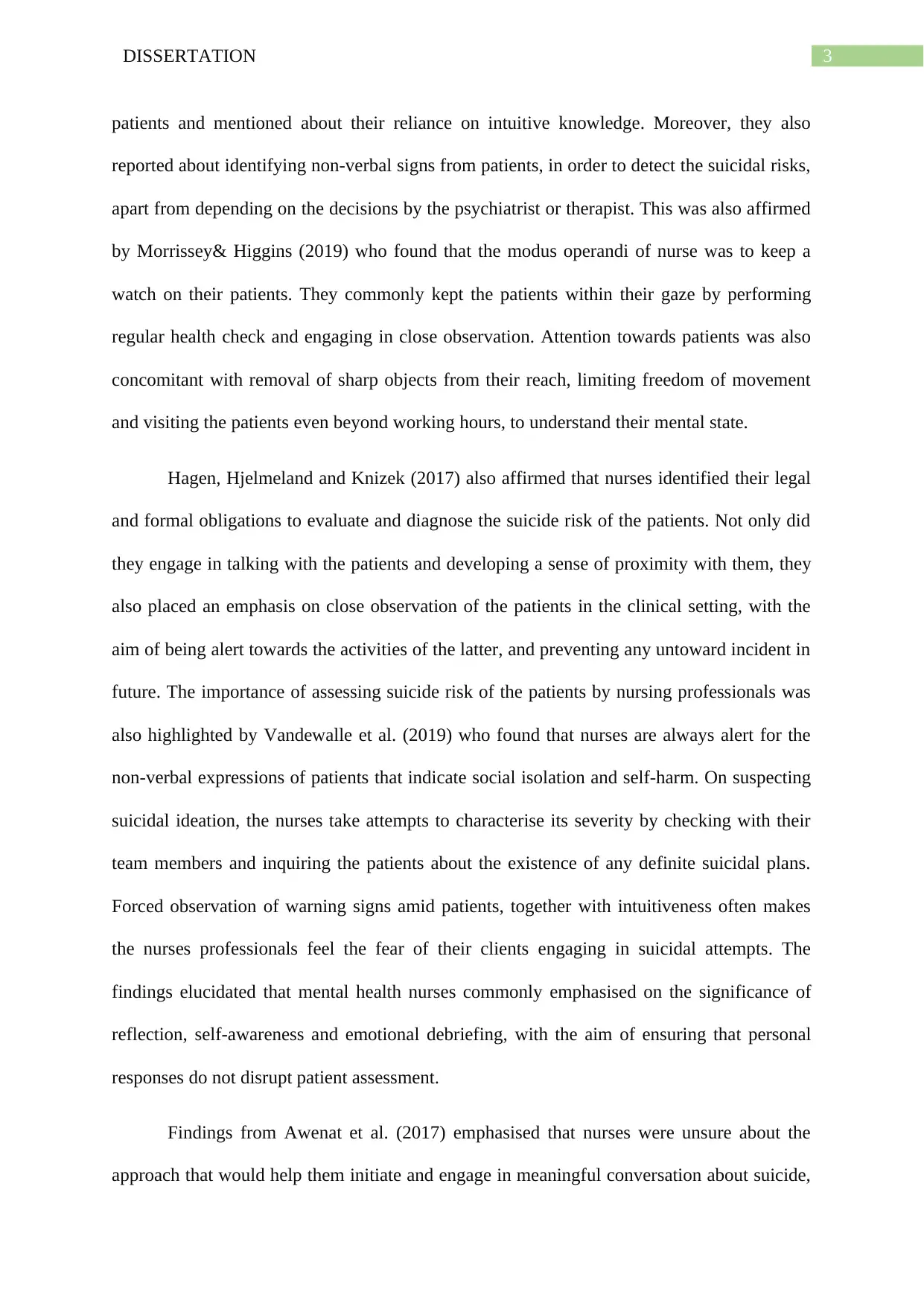
3DISSERTATION
patients and mentioned about their reliance on intuitive knowledge. Moreover, they also
reported about identifying non-verbal signs from patients, in order to detect the suicidal risks,
apart from depending on the decisions by the psychiatrist or therapist. This was also affirmed
by Morrissey& Higgins (2019) who found that the modus operandi of nurse was to keep a
watch on their patients. They commonly kept the patients within their gaze by performing
regular health check and engaging in close observation. Attention towards patients was also
concomitant with removal of sharp objects from their reach, limiting freedom of movement
and visiting the patients even beyond working hours, to understand their mental state.
Hagen, Hjelmeland and Knizek (2017) also affirmed that nurses identified their legal
and formal obligations to evaluate and diagnose the suicide risk of the patients. Not only did
they engage in talking with the patients and developing a sense of proximity with them, they
also placed an emphasis on close observation of the patients in the clinical setting, with the
aim of being alert towards the activities of the latter, and preventing any untoward incident in
future. The importance of assessing suicide risk of the patients by nursing professionals was
also highlighted by Vandewalle et al. (2019) who found that nurses are always alert for the
non-verbal expressions of patients that indicate social isolation and self-harm. On suspecting
suicidal ideation, the nurses take attempts to characterise its severity by checking with their
team members and inquiring the patients about the existence of any definite suicidal plans.
Forced observation of warning signs amid patients, together with intuitiveness often makes
the nurses professionals feel the fear of their clients engaging in suicidal attempts. The
findings elucidated that mental health nurses commonly emphasised on the significance of
reflection, self-awareness and emotional debriefing, with the aim of ensuring that personal
responses do not disrupt patient assessment.
Findings from Awenat et al. (2017) emphasised that nurses were unsure about the
approach that would help them initiate and engage in meaningful conversation about suicide,
patients and mentioned about their reliance on intuitive knowledge. Moreover, they also
reported about identifying non-verbal signs from patients, in order to detect the suicidal risks,
apart from depending on the decisions by the psychiatrist or therapist. This was also affirmed
by Morrissey& Higgins (2019) who found that the modus operandi of nurse was to keep a
watch on their patients. They commonly kept the patients within their gaze by performing
regular health check and engaging in close observation. Attention towards patients was also
concomitant with removal of sharp objects from their reach, limiting freedom of movement
and visiting the patients even beyond working hours, to understand their mental state.
Hagen, Hjelmeland and Knizek (2017) also affirmed that nurses identified their legal
and formal obligations to evaluate and diagnose the suicide risk of the patients. Not only did
they engage in talking with the patients and developing a sense of proximity with them, they
also placed an emphasis on close observation of the patients in the clinical setting, with the
aim of being alert towards the activities of the latter, and preventing any untoward incident in
future. The importance of assessing suicide risk of the patients by nursing professionals was
also highlighted by Vandewalle et al. (2019) who found that nurses are always alert for the
non-verbal expressions of patients that indicate social isolation and self-harm. On suspecting
suicidal ideation, the nurses take attempts to characterise its severity by checking with their
team members and inquiring the patients about the existence of any definite suicidal plans.
Forced observation of warning signs amid patients, together with intuitiveness often makes
the nurses professionals feel the fear of their clients engaging in suicidal attempts. The
findings elucidated that mental health nurses commonly emphasised on the significance of
reflection, self-awareness and emotional debriefing, with the aim of ensuring that personal
responses do not disrupt patient assessment.
Findings from Awenat et al. (2017) emphasised that nurses were unsure about the
approach that would help them initiate and engage in meaningful conversation about suicide,
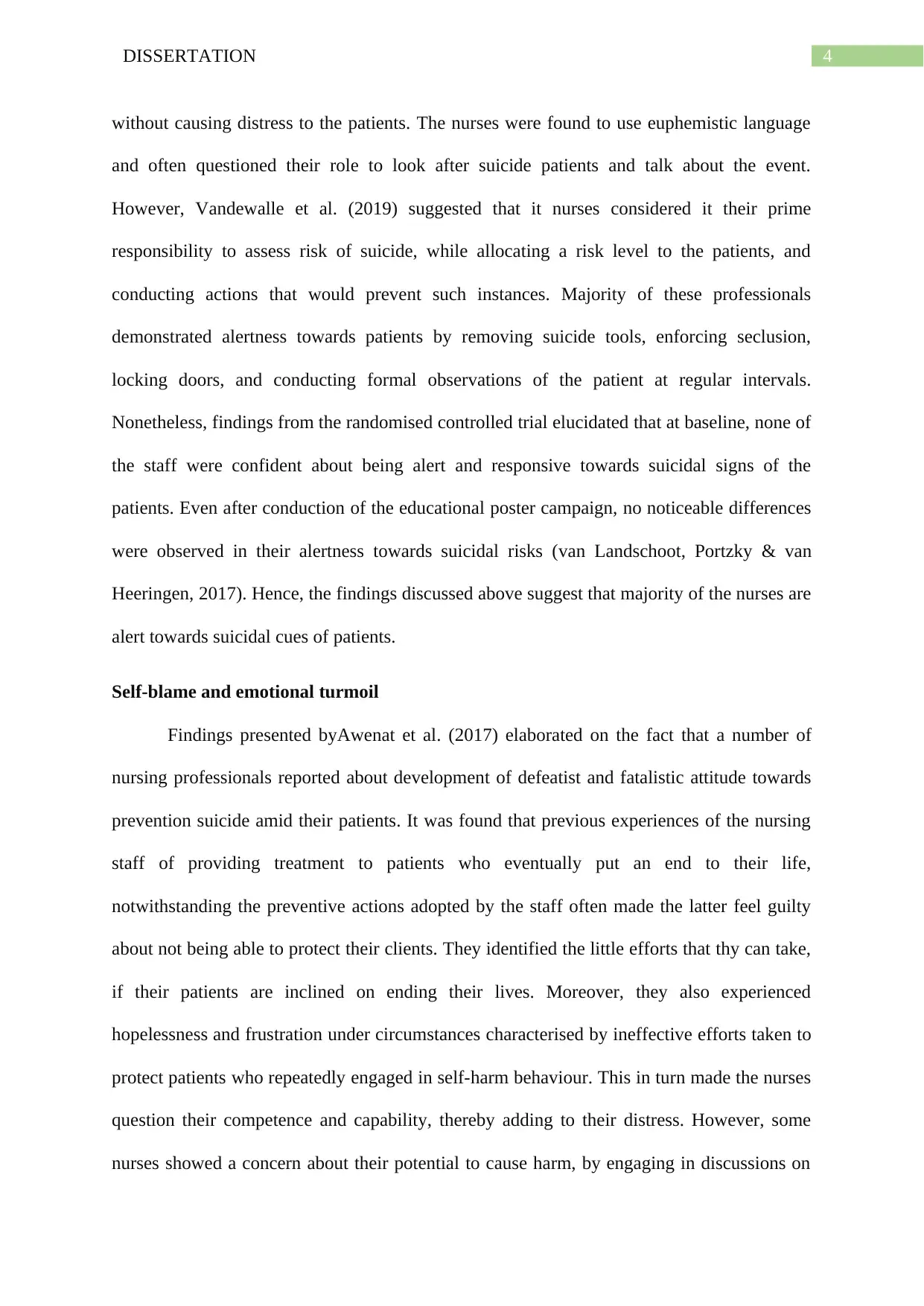
4DISSERTATION
without causing distress to the patients. The nurses were found to use euphemistic language
and often questioned their role to look after suicide patients and talk about the event.
However, Vandewalle et al. (2019) suggested that it nurses considered it their prime
responsibility to assess risk of suicide, while allocating a risk level to the patients, and
conducting actions that would prevent such instances. Majority of these professionals
demonstrated alertness towards patients by removing suicide tools, enforcing seclusion,
locking doors, and conducting formal observations of the patient at regular intervals.
Nonetheless, findings from the randomised controlled trial elucidated that at baseline, none of
the staff were confident about being alert and responsive towards suicidal signs of the
patients. Even after conduction of the educational poster campaign, no noticeable differences
were observed in their alertness towards suicidal risks (van Landschoot, Portzky & van
Heeringen, 2017). Hence, the findings discussed above suggest that majority of the nurses are
alert towards suicidal cues of patients.
Self-blame and emotional turmoil
Findings presented byAwenat et al. (2017) elaborated on the fact that a number of
nursing professionals reported about development of defeatist and fatalistic attitude towards
prevention suicide amid their patients. It was found that previous experiences of the nursing
staff of providing treatment to patients who eventually put an end to their life,
notwithstanding the preventive actions adopted by the staff often made the latter feel guilty
about not being able to protect their clients. They identified the little efforts that thy can take,
if their patients are inclined on ending their lives. Moreover, they also experienced
hopelessness and frustration under circumstances characterised by ineffective efforts taken to
protect patients who repeatedly engaged in self-harm behaviour. This in turn made the nurses
question their competence and capability, thereby adding to their distress. However, some
nurses showed a concern about their potential to cause harm, by engaging in discussions on
without causing distress to the patients. The nurses were found to use euphemistic language
and often questioned their role to look after suicide patients and talk about the event.
However, Vandewalle et al. (2019) suggested that it nurses considered it their prime
responsibility to assess risk of suicide, while allocating a risk level to the patients, and
conducting actions that would prevent such instances. Majority of these professionals
demonstrated alertness towards patients by removing suicide tools, enforcing seclusion,
locking doors, and conducting formal observations of the patient at regular intervals.
Nonetheless, findings from the randomised controlled trial elucidated that at baseline, none of
the staff were confident about being alert and responsive towards suicidal signs of the
patients. Even after conduction of the educational poster campaign, no noticeable differences
were observed in their alertness towards suicidal risks (van Landschoot, Portzky & van
Heeringen, 2017). Hence, the findings discussed above suggest that majority of the nurses are
alert towards suicidal cues of patients.
Self-blame and emotional turmoil
Findings presented byAwenat et al. (2017) elaborated on the fact that a number of
nursing professionals reported about development of defeatist and fatalistic attitude towards
prevention suicide amid their patients. It was found that previous experiences of the nursing
staff of providing treatment to patients who eventually put an end to their life,
notwithstanding the preventive actions adopted by the staff often made the latter feel guilty
about not being able to protect their clients. They identified the little efforts that thy can take,
if their patients are inclined on ending their lives. Moreover, they also experienced
hopelessness and frustration under circumstances characterised by ineffective efforts taken to
protect patients who repeatedly engaged in self-harm behaviour. This in turn made the nurses
question their competence and capability, thereby adding to their distress. However, some
nurses showed a concern about their potential to cause harm, by engaging in discussions on
Paraphrase This Document
Need a fresh take? Get an instant paraphrase of this document with our AI Paraphraser
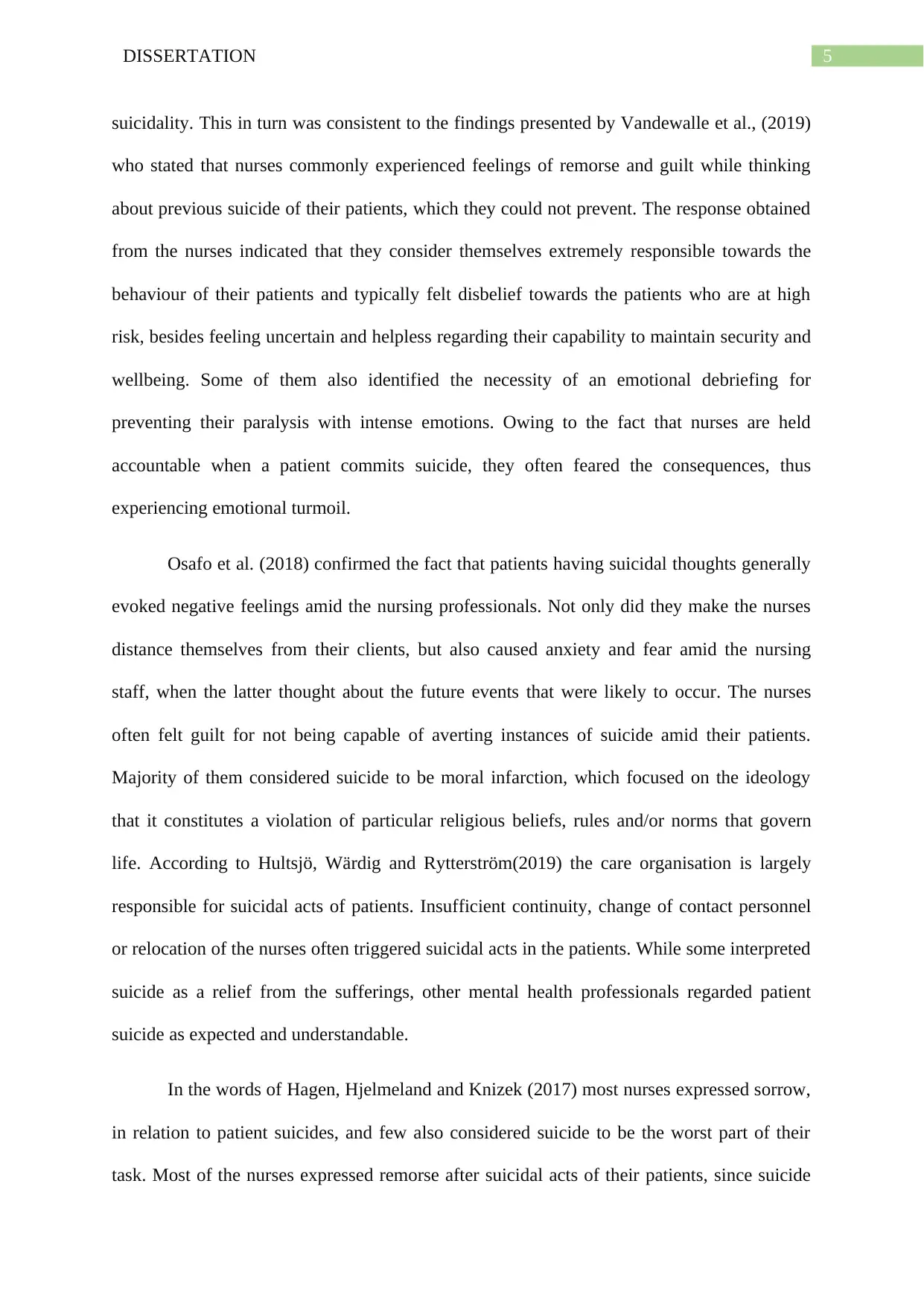
5DISSERTATION
suicidality. This in turn was consistent to the findings presented by Vandewalle et al., (2019)
who stated that nurses commonly experienced feelings of remorse and guilt while thinking
about previous suicide of their patients, which they could not prevent. The response obtained
from the nurses indicated that they consider themselves extremely responsible towards the
behaviour of their patients and typically felt disbelief towards the patients who are at high
risk, besides feeling uncertain and helpless regarding their capability to maintain security and
wellbeing. Some of them also identified the necessity of an emotional debriefing for
preventing their paralysis with intense emotions. Owing to the fact that nurses are held
accountable when a patient commits suicide, they often feared the consequences, thus
experiencing emotional turmoil.
Osafo et al. (2018) confirmed the fact that patients having suicidal thoughts generally
evoked negative feelings amid the nursing professionals. Not only did they make the nurses
distance themselves from their clients, but also caused anxiety and fear amid the nursing
staff, when the latter thought about the future events that were likely to occur. The nurses
often felt guilt for not being capable of averting instances of suicide amid their patients.
Majority of them considered suicide to be moral infarction, which focused on the ideology
that it constitutes a violation of particular religious beliefs, rules and/or norms that govern
life. According to Hultsjö, Wärdig and Rytterström(2019) the care organisation is largely
responsible for suicidal acts of patients. Insufficient continuity, change of contact personnel
or relocation of the nurses often triggered suicidal acts in the patients. While some interpreted
suicide as a relief from the sufferings, other mental health professionals regarded patient
suicide as expected and understandable.
In the words of Hagen, Hjelmeland and Knizek (2017) most nurses expressed sorrow,
in relation to patient suicides, and few also considered suicide to be the worst part of their
task. Most of the nurses expressed remorse after suicidal acts of their patients, since suicide
suicidality. This in turn was consistent to the findings presented by Vandewalle et al., (2019)
who stated that nurses commonly experienced feelings of remorse and guilt while thinking
about previous suicide of their patients, which they could not prevent. The response obtained
from the nurses indicated that they consider themselves extremely responsible towards the
behaviour of their patients and typically felt disbelief towards the patients who are at high
risk, besides feeling uncertain and helpless regarding their capability to maintain security and
wellbeing. Some of them also identified the necessity of an emotional debriefing for
preventing their paralysis with intense emotions. Owing to the fact that nurses are held
accountable when a patient commits suicide, they often feared the consequences, thus
experiencing emotional turmoil.
Osafo et al. (2018) confirmed the fact that patients having suicidal thoughts generally
evoked negative feelings amid the nursing professionals. Not only did they make the nurses
distance themselves from their clients, but also caused anxiety and fear amid the nursing
staff, when the latter thought about the future events that were likely to occur. The nurses
often felt guilt for not being capable of averting instances of suicide amid their patients.
Majority of them considered suicide to be moral infarction, which focused on the ideology
that it constitutes a violation of particular religious beliefs, rules and/or norms that govern
life. According to Hultsjö, Wärdig and Rytterström(2019) the care organisation is largely
responsible for suicidal acts of patients. Insufficient continuity, change of contact personnel
or relocation of the nurses often triggered suicidal acts in the patients. While some interpreted
suicide as a relief from the sufferings, other mental health professionals regarded patient
suicide as expected and understandable.
In the words of Hagen, Hjelmeland and Knizek (2017) most nurses expressed sorrow,
in relation to patient suicides, and few also considered suicide to be the worst part of their
task. Most of the nurses expressed remorse after suicidal acts of their patients, since suicide
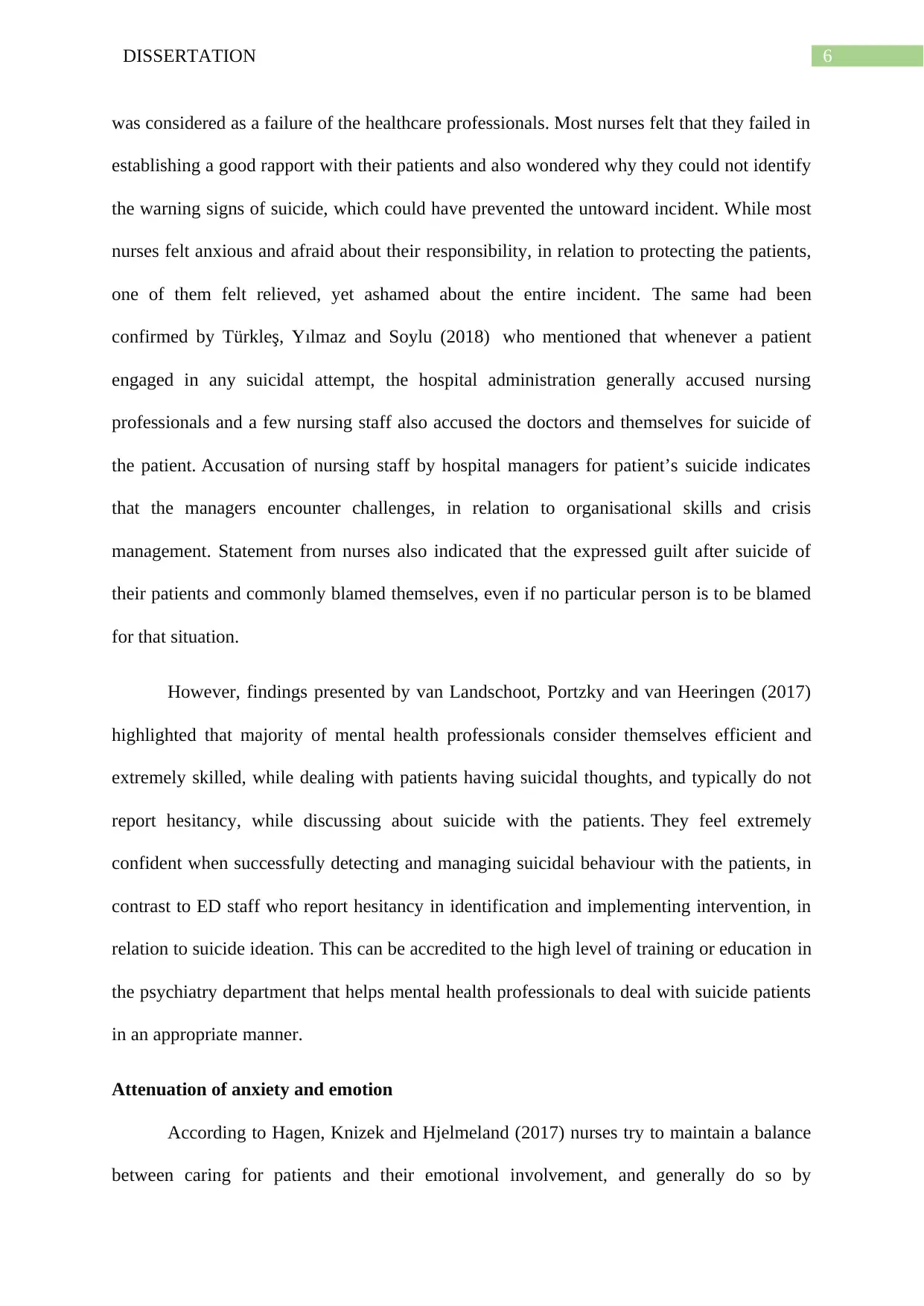
6DISSERTATION
was considered as a failure of the healthcare professionals. Most nurses felt that they failed in
establishing a good rapport with their patients and also wondered why they could not identify
the warning signs of suicide, which could have prevented the untoward incident. While most
nurses felt anxious and afraid about their responsibility, in relation to protecting the patients,
one of them felt relieved, yet ashamed about the entire incident. The same had been
confirmed by Türkleş, Yılmaz and Soylu (2018) who mentioned that whenever a patient
engaged in any suicidal attempt, the hospital administration generally accused nursing
professionals and a few nursing staff also accused the doctors and themselves for suicide of
the patient. Accusation of nursing staff by hospital managers for patient’s suicide indicates
that the managers encounter challenges, in relation to organisational skills and crisis
management. Statement from nurses also indicated that the expressed guilt after suicide of
their patients and commonly blamed themselves, even if no particular person is to be blamed
for that situation.
However, findings presented by van Landschoot, Portzky and van Heeringen (2017)
highlighted that majority of mental health professionals consider themselves efficient and
extremely skilled, while dealing with patients having suicidal thoughts, and typically do not
report hesitancy, while discussing about suicide with the patients. They feel extremely
confident when successfully detecting and managing suicidal behaviour with the patients, in
contrast to ED staff who report hesitancy in identification and implementing intervention, in
relation to suicide ideation. This can be accredited to the high level of training or education in
the psychiatry department that helps mental health professionals to deal with suicide patients
in an appropriate manner.
Attenuation of anxiety and emotion
According to Hagen, Knizek and Hjelmeland (2017) nurses try to maintain a balance
between caring for patients and their emotional involvement, and generally do so by
was considered as a failure of the healthcare professionals. Most nurses felt that they failed in
establishing a good rapport with their patients and also wondered why they could not identify
the warning signs of suicide, which could have prevented the untoward incident. While most
nurses felt anxious and afraid about their responsibility, in relation to protecting the patients,
one of them felt relieved, yet ashamed about the entire incident. The same had been
confirmed by Türkleş, Yılmaz and Soylu (2018) who mentioned that whenever a patient
engaged in any suicidal attempt, the hospital administration generally accused nursing
professionals and a few nursing staff also accused the doctors and themselves for suicide of
the patient. Accusation of nursing staff by hospital managers for patient’s suicide indicates
that the managers encounter challenges, in relation to organisational skills and crisis
management. Statement from nurses also indicated that the expressed guilt after suicide of
their patients and commonly blamed themselves, even if no particular person is to be blamed
for that situation.
However, findings presented by van Landschoot, Portzky and van Heeringen (2017)
highlighted that majority of mental health professionals consider themselves efficient and
extremely skilled, while dealing with patients having suicidal thoughts, and typically do not
report hesitancy, while discussing about suicide with the patients. They feel extremely
confident when successfully detecting and managing suicidal behaviour with the patients, in
contrast to ED staff who report hesitancy in identification and implementing intervention, in
relation to suicide ideation. This can be accredited to the high level of training or education in
the psychiatry department that helps mental health professionals to deal with suicide patients
in an appropriate manner.
Attenuation of anxiety and emotion
According to Hagen, Knizek and Hjelmeland (2017) nurses try to maintain a balance
between caring for patients and their emotional involvement, and generally do so by
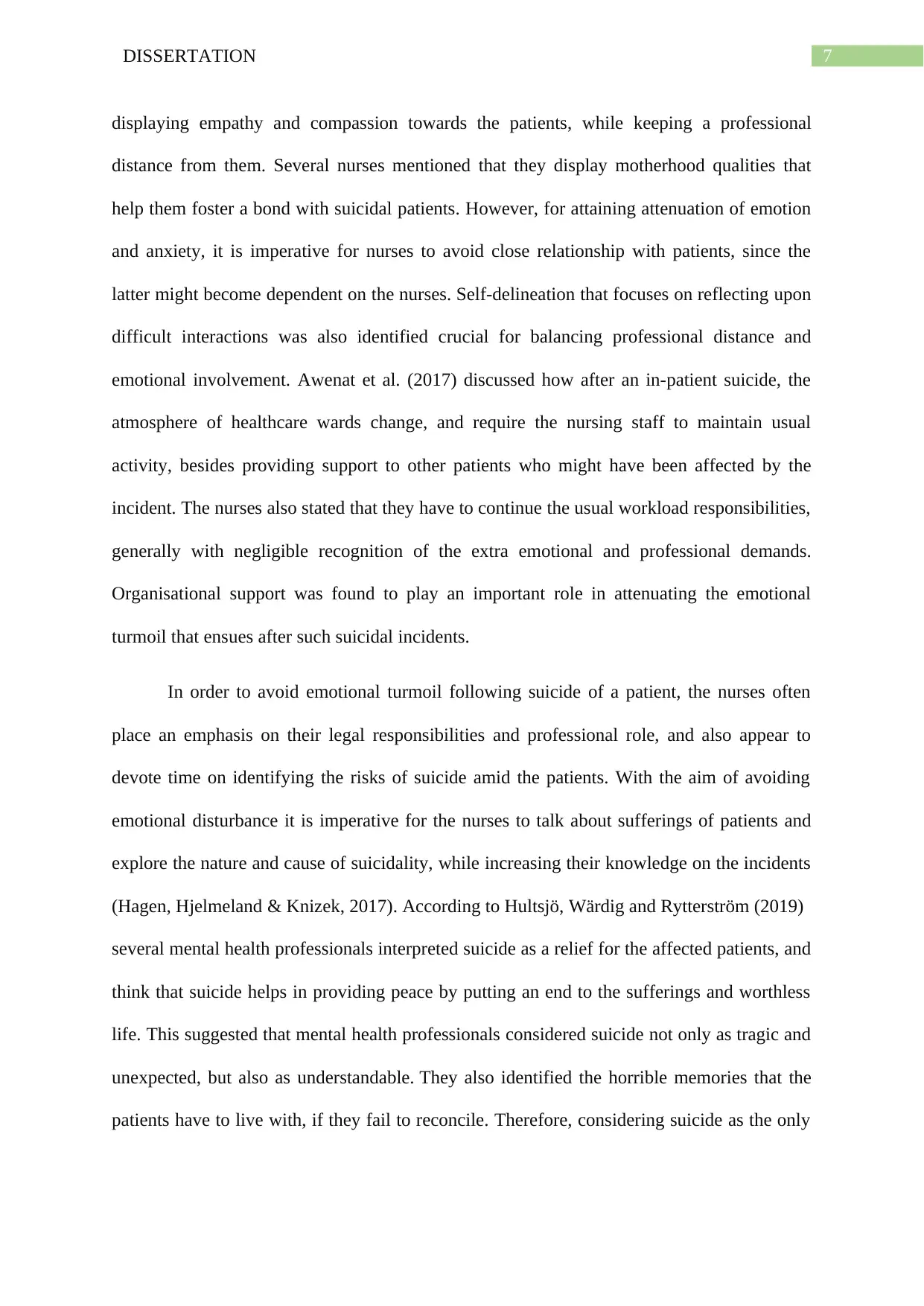
7DISSERTATION
displaying empathy and compassion towards the patients, while keeping a professional
distance from them. Several nurses mentioned that they display motherhood qualities that
help them foster a bond with suicidal patients. However, for attaining attenuation of emotion
and anxiety, it is imperative for nurses to avoid close relationship with patients, since the
latter might become dependent on the nurses. Self-delineation that focuses on reflecting upon
difficult interactions was also identified crucial for balancing professional distance and
emotional involvement. Awenat et al. (2017) discussed how after an in-patient suicide, the
atmosphere of healthcare wards change, and require the nursing staff to maintain usual
activity, besides providing support to other patients who might have been affected by the
incident. The nurses also stated that they have to continue the usual workload responsibilities,
generally with negligible recognition of the extra emotional and professional demands.
Organisational support was found to play an important role in attenuating the emotional
turmoil that ensues after such suicidal incidents.
In order to avoid emotional turmoil following suicide of a patient, the nurses often
place an emphasis on their legal responsibilities and professional role, and also appear to
devote time on identifying the risks of suicide amid the patients. With the aim of avoiding
emotional disturbance it is imperative for the nurses to talk about sufferings of patients and
explore the nature and cause of suicidality, while increasing their knowledge on the incidents
(Hagen, Hjelmeland & Knizek, 2017). According to Hultsjö, Wärdig and Rytterström (2019)
several mental health professionals interpreted suicide as a relief for the affected patients, and
think that suicide helps in providing peace by putting an end to the sufferings and worthless
life. This suggested that mental health professionals considered suicide not only as tragic and
unexpected, but also as understandable. They also identified the horrible memories that the
patients have to live with, if they fail to reconcile. Therefore, considering suicide as the only
displaying empathy and compassion towards the patients, while keeping a professional
distance from them. Several nurses mentioned that they display motherhood qualities that
help them foster a bond with suicidal patients. However, for attaining attenuation of emotion
and anxiety, it is imperative for nurses to avoid close relationship with patients, since the
latter might become dependent on the nurses. Self-delineation that focuses on reflecting upon
difficult interactions was also identified crucial for balancing professional distance and
emotional involvement. Awenat et al. (2017) discussed how after an in-patient suicide, the
atmosphere of healthcare wards change, and require the nursing staff to maintain usual
activity, besides providing support to other patients who might have been affected by the
incident. The nurses also stated that they have to continue the usual workload responsibilities,
generally with negligible recognition of the extra emotional and professional demands.
Organisational support was found to play an important role in attenuating the emotional
turmoil that ensues after such suicidal incidents.
In order to avoid emotional turmoil following suicide of a patient, the nurses often
place an emphasis on their legal responsibilities and professional role, and also appear to
devote time on identifying the risks of suicide amid the patients. With the aim of avoiding
emotional disturbance it is imperative for the nurses to talk about sufferings of patients and
explore the nature and cause of suicidality, while increasing their knowledge on the incidents
(Hagen, Hjelmeland & Knizek, 2017). According to Hultsjö, Wärdig and Rytterström (2019)
several mental health professionals interpreted suicide as a relief for the affected patients, and
think that suicide helps in providing peace by putting an end to the sufferings and worthless
life. This suggested that mental health professionals considered suicide not only as tragic and
unexpected, but also as understandable. They also identified the horrible memories that the
patients have to live with, if they fail to reconcile. Therefore, considering suicide as the only
Secure Best Marks with AI Grader
Need help grading? Try our AI Grader for instant feedback on your assignments.
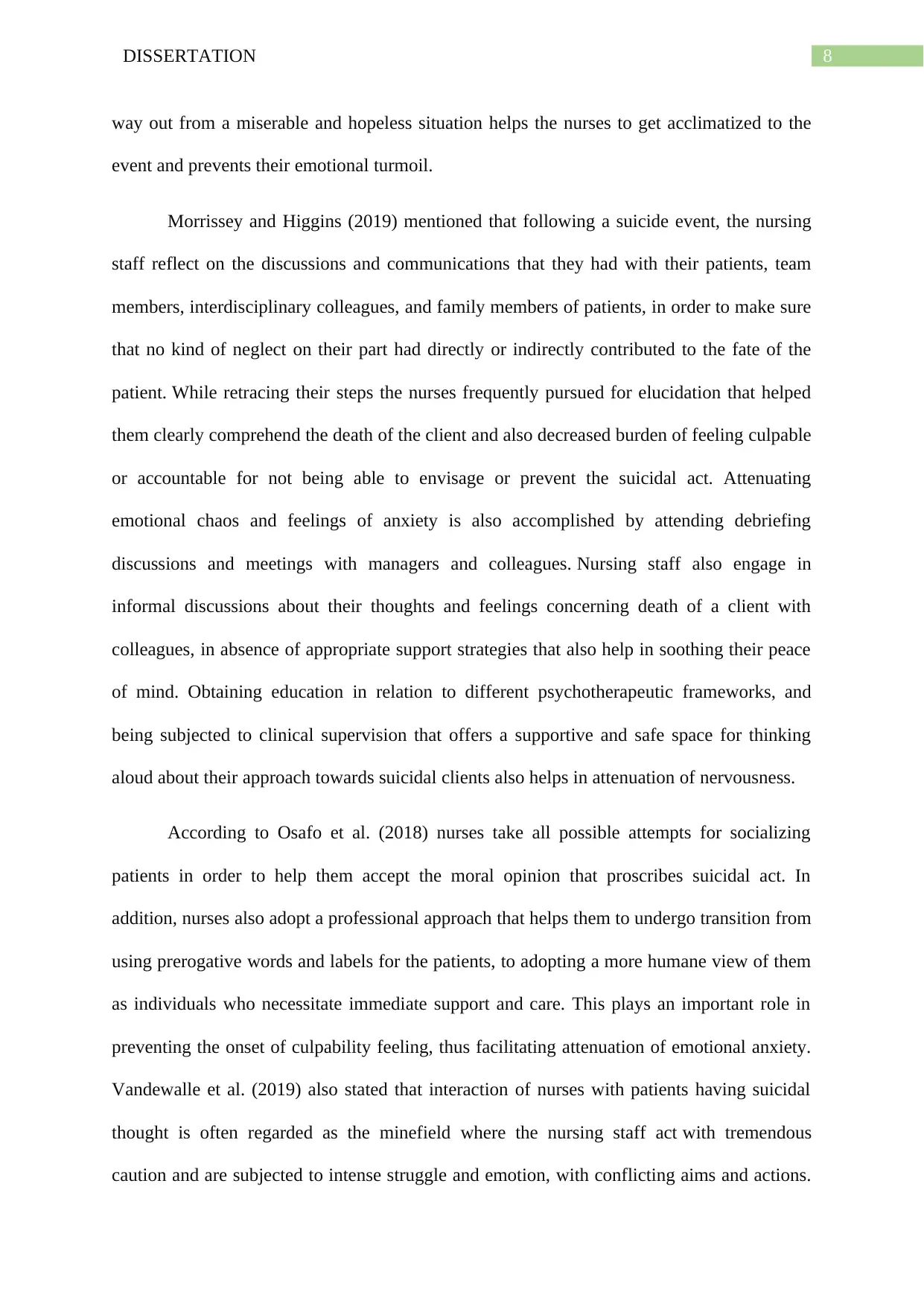
8DISSERTATION
way out from a miserable and hopeless situation helps the nurses to get acclimatized to the
event and prevents their emotional turmoil.
Morrissey and Higgins (2019) mentioned that following a suicide event, the nursing
staff reflect on the discussions and communications that they had with their patients, team
members, interdisciplinary colleagues, and family members of patients, in order to make sure
that no kind of neglect on their part had directly or indirectly contributed to the fate of the
patient. While retracing their steps the nurses frequently pursued for elucidation that helped
them clearly comprehend the death of the client and also decreased burden of feeling culpable
or accountable for not being able to envisage or prevent the suicidal act. Attenuating
emotional chaos and feelings of anxiety is also accomplished by attending debriefing
discussions and meetings with managers and colleagues. Nursing staff also engage in
informal discussions about their thoughts and feelings concerning death of a client with
colleagues, in absence of appropriate support strategies that also help in soothing their peace
of mind. Obtaining education in relation to different psychotherapeutic frameworks, and
being subjected to clinical supervision that offers a supportive and safe space for thinking
aloud about their approach towards suicidal clients also helps in attenuation of nervousness.
According to Osafo et al. (2018) nurses take all possible attempts for socializing
patients in order to help them accept the moral opinion that proscribes suicidal act. In
addition, nurses also adopt a professional approach that helps them to undergo transition from
using prerogative words and labels for the patients, to adopting a more humane view of them
as individuals who necessitate immediate support and care. This plays an important role in
preventing the onset of culpability feeling, thus facilitating attenuation of emotional anxiety.
Vandewalle et al. (2019) also stated that interaction of nurses with patients having suicidal
thought is often regarded as the minefield where the nursing staff act with tremendous
caution and are subjected to intense struggle and emotion, with conflicting aims and actions.
way out from a miserable and hopeless situation helps the nurses to get acclimatized to the
event and prevents their emotional turmoil.
Morrissey and Higgins (2019) mentioned that following a suicide event, the nursing
staff reflect on the discussions and communications that they had with their patients, team
members, interdisciplinary colleagues, and family members of patients, in order to make sure
that no kind of neglect on their part had directly or indirectly contributed to the fate of the
patient. While retracing their steps the nurses frequently pursued for elucidation that helped
them clearly comprehend the death of the client and also decreased burden of feeling culpable
or accountable for not being able to envisage or prevent the suicidal act. Attenuating
emotional chaos and feelings of anxiety is also accomplished by attending debriefing
discussions and meetings with managers and colleagues. Nursing staff also engage in
informal discussions about their thoughts and feelings concerning death of a client with
colleagues, in absence of appropriate support strategies that also help in soothing their peace
of mind. Obtaining education in relation to different psychotherapeutic frameworks, and
being subjected to clinical supervision that offers a supportive and safe space for thinking
aloud about their approach towards suicidal clients also helps in attenuation of nervousness.
According to Osafo et al. (2018) nurses take all possible attempts for socializing
patients in order to help them accept the moral opinion that proscribes suicidal act. In
addition, nurses also adopt a professional approach that helps them to undergo transition from
using prerogative words and labels for the patients, to adopting a more humane view of them
as individuals who necessitate immediate support and care. This plays an important role in
preventing the onset of culpability feeling, thus facilitating attenuation of emotional anxiety.
Vandewalle et al. (2019) also stated that interaction of nurses with patients having suicidal
thought is often regarded as the minefield where the nursing staff act with tremendous
caution and are subjected to intense struggle and emotion, with conflicting aims and actions.
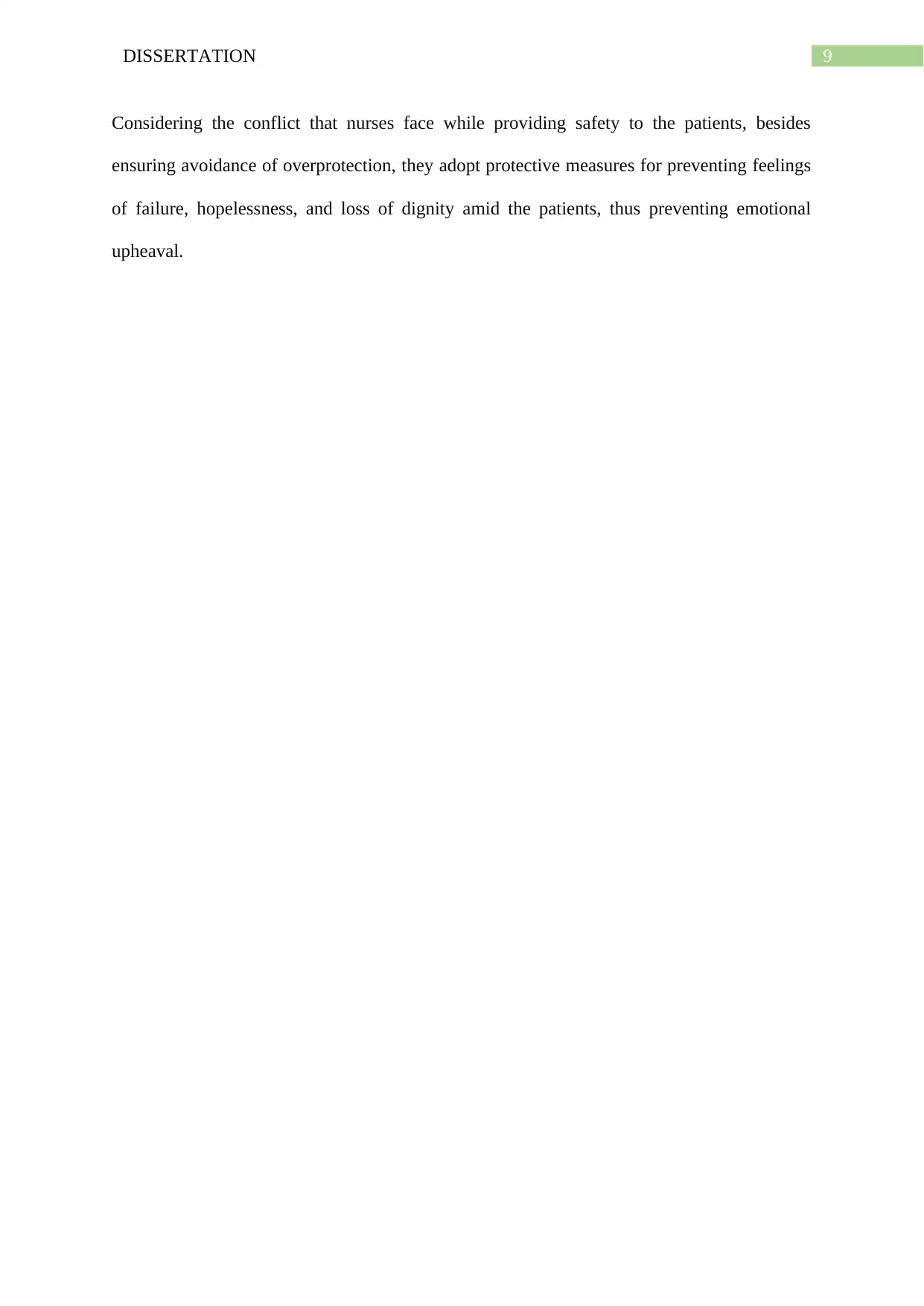
9DISSERTATION
Considering the conflict that nurses face while providing safety to the patients, besides
ensuring avoidance of overprotection, they adopt protective measures for preventing feelings
of failure, hopelessness, and loss of dignity amid the patients, thus preventing emotional
upheaval.
Considering the conflict that nurses face while providing safety to the patients, besides
ensuring avoidance of overprotection, they adopt protective measures for preventing feelings
of failure, hopelessness, and loss of dignity amid the patients, thus preventing emotional
upheaval.
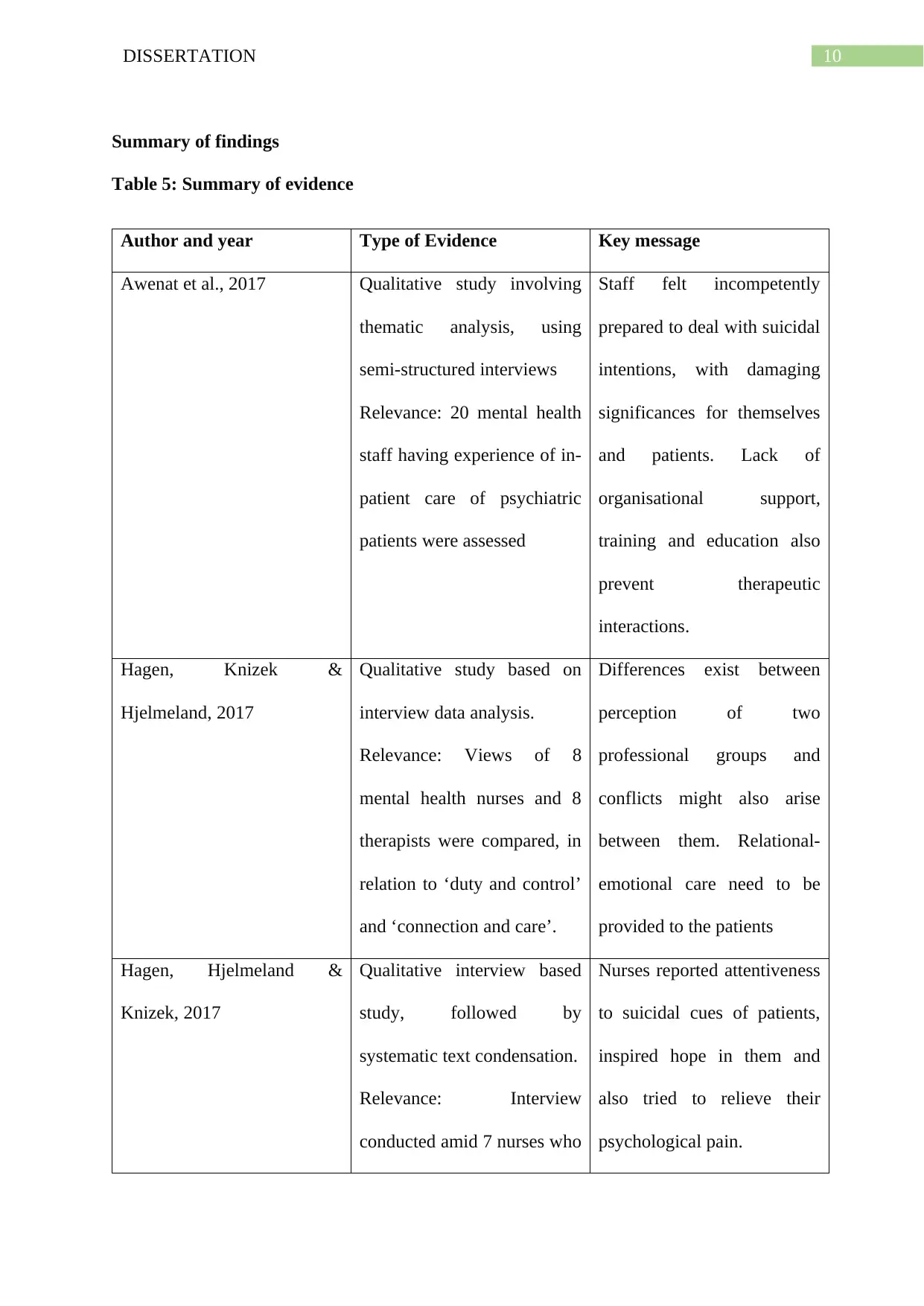
10DISSERTATION
Summary of findings
Table 5: Summary of evidence
Author and year Type of Evidence Key message
Awenat et al., 2017 Qualitative study involving
thematic analysis, using
semi-structured interviews
Relevance: 20 mental health
staff having experience of in-
patient care of psychiatric
patients were assessed
Staff felt incompetently
prepared to deal with suicidal
intentions, with damaging
significances for themselves
and patients. Lack of
organisational support,
training and education also
prevent therapeutic
interactions.
Hagen, Knizek &
Hjelmeland, 2017
Qualitative study based on
interview data analysis.
Relevance: Views of 8
mental health nurses and 8
therapists were compared, in
relation to ‘duty and control’
and ‘connection and care’.
Differences exist between
perception of two
professional groups and
conflicts might also arise
between them. Relational-
emotional care need to be
provided to the patients
Hagen, Hjelmeland &
Knizek, 2017
Qualitative interview based
study, followed by
systematic text condensation.
Relevance: Interview
conducted amid 7 nurses who
Nurses reported attentiveness
to suicidal cues of patients,
inspired hope in them and
also tried to relieve their
psychological pain.
Summary of findings
Table 5: Summary of evidence
Author and year Type of Evidence Key message
Awenat et al., 2017 Qualitative study involving
thematic analysis, using
semi-structured interviews
Relevance: 20 mental health
staff having experience of in-
patient care of psychiatric
patients were assessed
Staff felt incompetently
prepared to deal with suicidal
intentions, with damaging
significances for themselves
and patients. Lack of
organisational support,
training and education also
prevent therapeutic
interactions.
Hagen, Knizek &
Hjelmeland, 2017
Qualitative study based on
interview data analysis.
Relevance: Views of 8
mental health nurses and 8
therapists were compared, in
relation to ‘duty and control’
and ‘connection and care’.
Differences exist between
perception of two
professional groups and
conflicts might also arise
between them. Relational-
emotional care need to be
provided to the patients
Hagen, Hjelmeland &
Knizek, 2017
Qualitative interview based
study, followed by
systematic text condensation.
Relevance: Interview
conducted amid 7 nurses who
Nurses reported attentiveness
to suicidal cues of patients,
inspired hope in them and
also tried to relieve their
psychological pain.
Paraphrase This Document
Need a fresh take? Get an instant paraphrase of this document with our AI Paraphraser
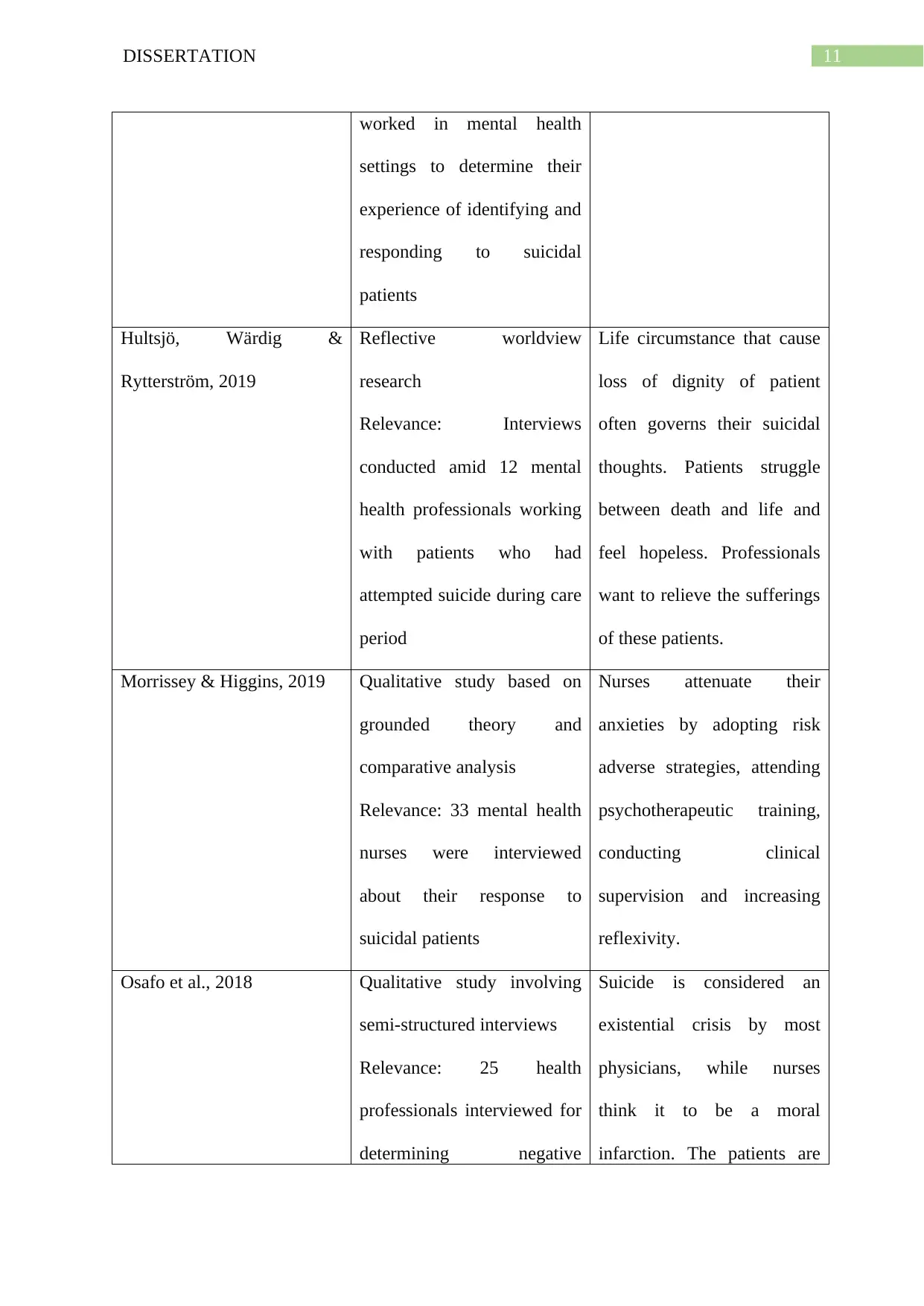
11DISSERTATION
worked in mental health
settings to determine their
experience of identifying and
responding to suicidal
patients
Hultsjö, Wärdig &
Rytterström, 2019
Reflective worldview
research
Relevance: Interviews
conducted amid 12 mental
health professionals working
with patients who had
attempted suicide during care
period
Life circumstance that cause
loss of dignity of patient
often governs their suicidal
thoughts. Patients struggle
between death and life and
feel hopeless. Professionals
want to relieve the sufferings
of these patients.
Morrissey & Higgins, 2019 Qualitative study based on
grounded theory and
comparative analysis
Relevance: 33 mental health
nurses were interviewed
about their response to
suicidal patients
Nurses attenuate their
anxieties by adopting risk
adverse strategies, attending
psychotherapeutic training,
conducting clinical
supervision and increasing
reflexivity.
Osafo et al., 2018 Qualitative study involving
semi-structured interviews
Relevance: 25 health
professionals interviewed for
determining negative
Suicide is considered an
existential crisis by most
physicians, while nurses
think it to be a moral
infarction. The patients are
worked in mental health
settings to determine their
experience of identifying and
responding to suicidal
patients
Hultsjö, Wärdig &
Rytterström, 2019
Reflective worldview
research
Relevance: Interviews
conducted amid 12 mental
health professionals working
with patients who had
attempted suicide during care
period
Life circumstance that cause
loss of dignity of patient
often governs their suicidal
thoughts. Patients struggle
between death and life and
feel hopeless. Professionals
want to relieve the sufferings
of these patients.
Morrissey & Higgins, 2019 Qualitative study based on
grounded theory and
comparative analysis
Relevance: 33 mental health
nurses were interviewed
about their response to
suicidal patients
Nurses attenuate their
anxieties by adopting risk
adverse strategies, attending
psychotherapeutic training,
conducting clinical
supervision and increasing
reflexivity.
Osafo et al., 2018 Qualitative study involving
semi-structured interviews
Relevance: 25 health
professionals interviewed for
determining negative
Suicide is considered an
existential crisis by most
physicians, while nurses
think it to be a moral
infarction. The patients are
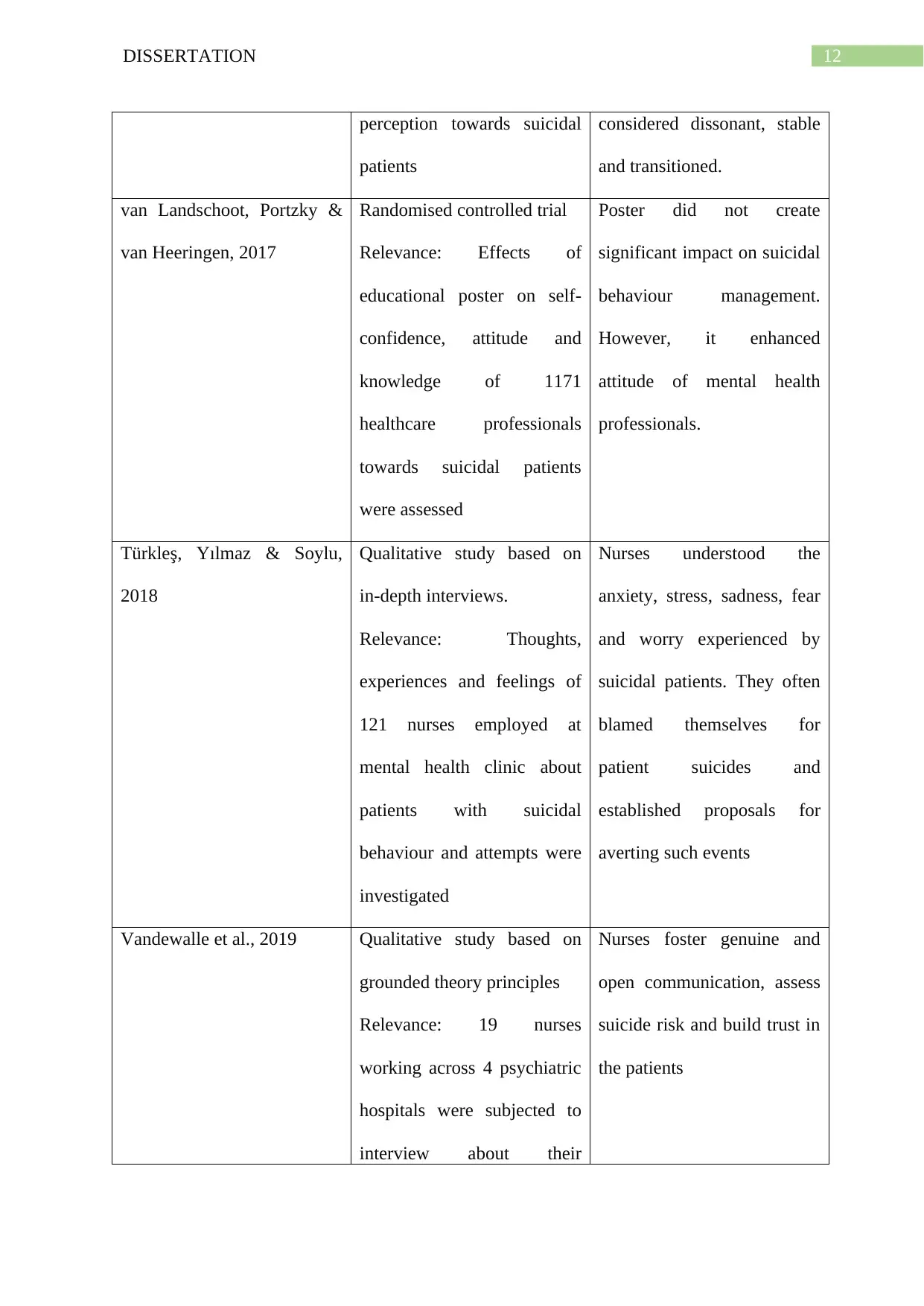
12DISSERTATION
perception towards suicidal
patients
considered dissonant, stable
and transitioned.
van Landschoot, Portzky &
van Heeringen, 2017
Randomised controlled trial
Relevance: Effects of
educational poster on self-
confidence, attitude and
knowledge of 1171
healthcare professionals
towards suicidal patients
were assessed
Poster did not create
significant impact on suicidal
behaviour management.
However, it enhanced
attitude of mental health
professionals.
Türkleş, Yılmaz & Soylu,
2018
Qualitative study based on
in-depth interviews.
Relevance: Thoughts,
experiences and feelings of
121 nurses employed at
mental health clinic about
patients with suicidal
behaviour and attempts were
investigated
Nurses understood the
anxiety, stress, sadness, fear
and worry experienced by
suicidal patients. They often
blamed themselves for
patient suicides and
established proposals for
averting such events
Vandewalle et al., 2019 Qualitative study based on
grounded theory principles
Relevance: 19 nurses
working across 4 psychiatric
hospitals were subjected to
interview about their
Nurses foster genuine and
open communication, assess
suicide risk and build trust in
the patients
perception towards suicidal
patients
considered dissonant, stable
and transitioned.
van Landschoot, Portzky &
van Heeringen, 2017
Randomised controlled trial
Relevance: Effects of
educational poster on self-
confidence, attitude and
knowledge of 1171
healthcare professionals
towards suicidal patients
were assessed
Poster did not create
significant impact on suicidal
behaviour management.
However, it enhanced
attitude of mental health
professionals.
Türkleş, Yılmaz & Soylu,
2018
Qualitative study based on
in-depth interviews.
Relevance: Thoughts,
experiences and feelings of
121 nurses employed at
mental health clinic about
patients with suicidal
behaviour and attempts were
investigated
Nurses understood the
anxiety, stress, sadness, fear
and worry experienced by
suicidal patients. They often
blamed themselves for
patient suicides and
established proposals for
averting such events
Vandewalle et al., 2019 Qualitative study based on
grounded theory principles
Relevance: 19 nurses
working across 4 psychiatric
hospitals were subjected to
interview about their
Nurses foster genuine and
open communication, assess
suicide risk and build trust in
the patients
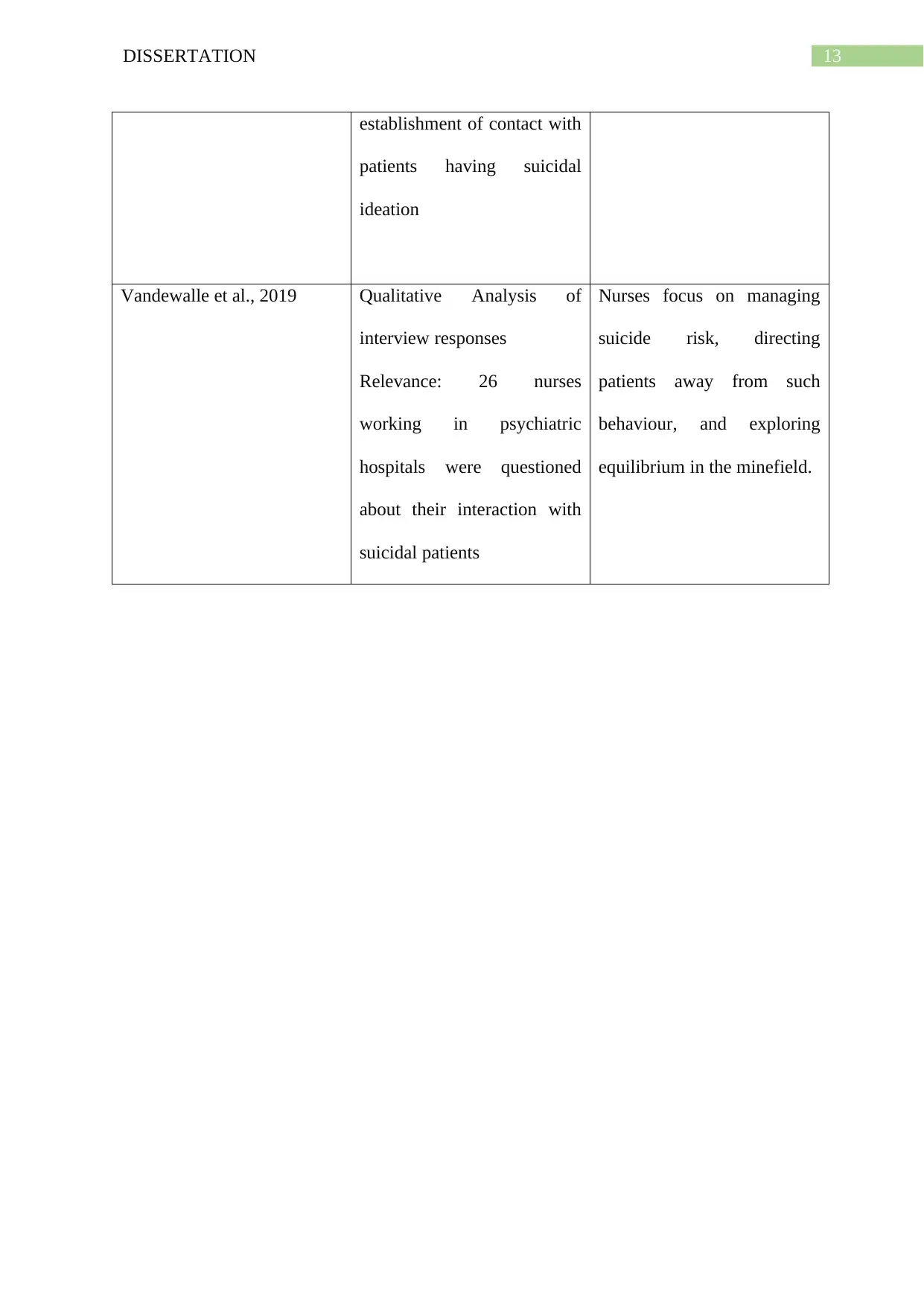
13DISSERTATION
establishment of contact with
patients having suicidal
ideation
Vandewalle et al., 2019 Qualitative Analysis of
interview responses
Relevance: 26 nurses
working in psychiatric
hospitals were questioned
about their interaction with
suicidal patients
Nurses focus on managing
suicide risk, directing
patients away from such
behaviour, and exploring
equilibrium in the minefield.
establishment of contact with
patients having suicidal
ideation
Vandewalle et al., 2019 Qualitative Analysis of
interview responses
Relevance: 26 nurses
working in psychiatric
hospitals were questioned
about their interaction with
suicidal patients
Nurses focus on managing
suicide risk, directing
patients away from such
behaviour, and exploring
equilibrium in the minefield.
Secure Best Marks with AI Grader
Need help grading? Try our AI Grader for instant feedback on your assignments.
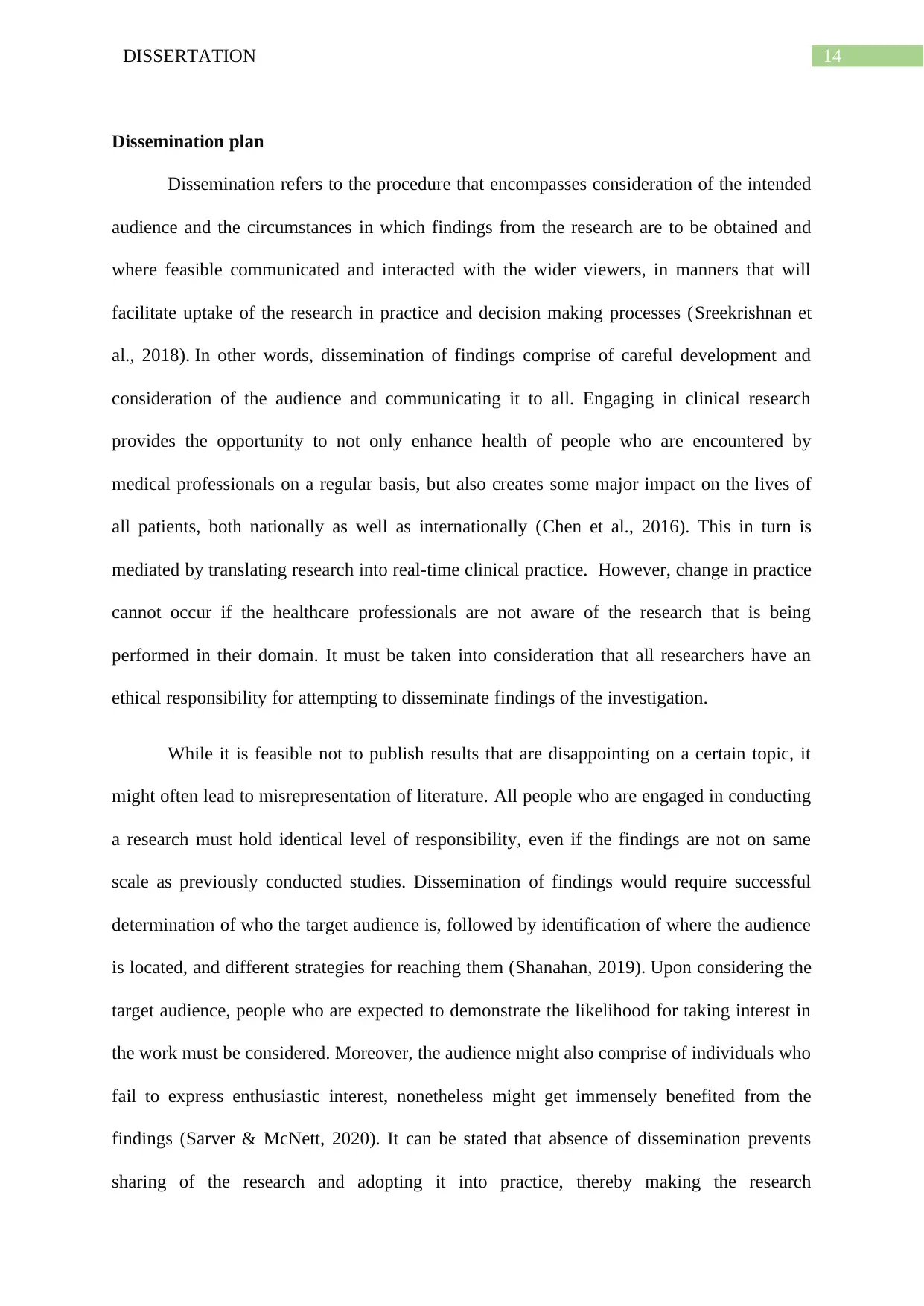
14DISSERTATION
Dissemination plan
Dissemination refers to the procedure that encompasses consideration of the intended
audience and the circumstances in which findings from the research are to be obtained and
where feasible communicated and interacted with the wider viewers, in manners that will
facilitate uptake of the research in practice and decision making processes (Sreekrishnan et
al., 2018). In other words, dissemination of findings comprise of careful development and
consideration of the audience and communicating it to all. Engaging in clinical research
provides the opportunity to not only enhance health of people who are encountered by
medical professionals on a regular basis, but also creates some major impact on the lives of
all patients, both nationally as well as internationally (Chen et al., 2016). This in turn is
mediated by translating research into real-time clinical practice. However, change in practice
cannot occur if the healthcare professionals are not aware of the research that is being
performed in their domain. It must be taken into consideration that all researchers have an
ethical responsibility for attempting to disseminate findings of the investigation.
While it is feasible not to publish results that are disappointing on a certain topic, it
might often lead to misrepresentation of literature. All people who are engaged in conducting
a research must hold identical level of responsibility, even if the findings are not on same
scale as previously conducted studies. Dissemination of findings would require successful
determination of who the target audience is, followed by identification of where the audience
is located, and different strategies for reaching them (Shanahan, 2019). Upon considering the
target audience, people who are expected to demonstrate the likelihood for taking interest in
the work must be considered. Moreover, the audience might also comprise of individuals who
fail to express enthusiastic interest, nonetheless might get immensely benefited from the
findings (Sarver & McNett, 2020). It can be stated that absence of dissemination prevents
sharing of the research and adopting it into practice, thereby making the research
Dissemination plan
Dissemination refers to the procedure that encompasses consideration of the intended
audience and the circumstances in which findings from the research are to be obtained and
where feasible communicated and interacted with the wider viewers, in manners that will
facilitate uptake of the research in practice and decision making processes (Sreekrishnan et
al., 2018). In other words, dissemination of findings comprise of careful development and
consideration of the audience and communicating it to all. Engaging in clinical research
provides the opportunity to not only enhance health of people who are encountered by
medical professionals on a regular basis, but also creates some major impact on the lives of
all patients, both nationally as well as internationally (Chen et al., 2016). This in turn is
mediated by translating research into real-time clinical practice. However, change in practice
cannot occur if the healthcare professionals are not aware of the research that is being
performed in their domain. It must be taken into consideration that all researchers have an
ethical responsibility for attempting to disseminate findings of the investigation.
While it is feasible not to publish results that are disappointing on a certain topic, it
might often lead to misrepresentation of literature. All people who are engaged in conducting
a research must hold identical level of responsibility, even if the findings are not on same
scale as previously conducted studies. Dissemination of findings would require successful
determination of who the target audience is, followed by identification of where the audience
is located, and different strategies for reaching them (Shanahan, 2019). Upon considering the
target audience, people who are expected to demonstrate the likelihood for taking interest in
the work must be considered. Moreover, the audience might also comprise of individuals who
fail to express enthusiastic interest, nonetheless might get immensely benefited from the
findings (Sarver & McNett, 2020). It can be stated that absence of dissemination prevents
sharing of the research and adopting it into practice, thereby making the research
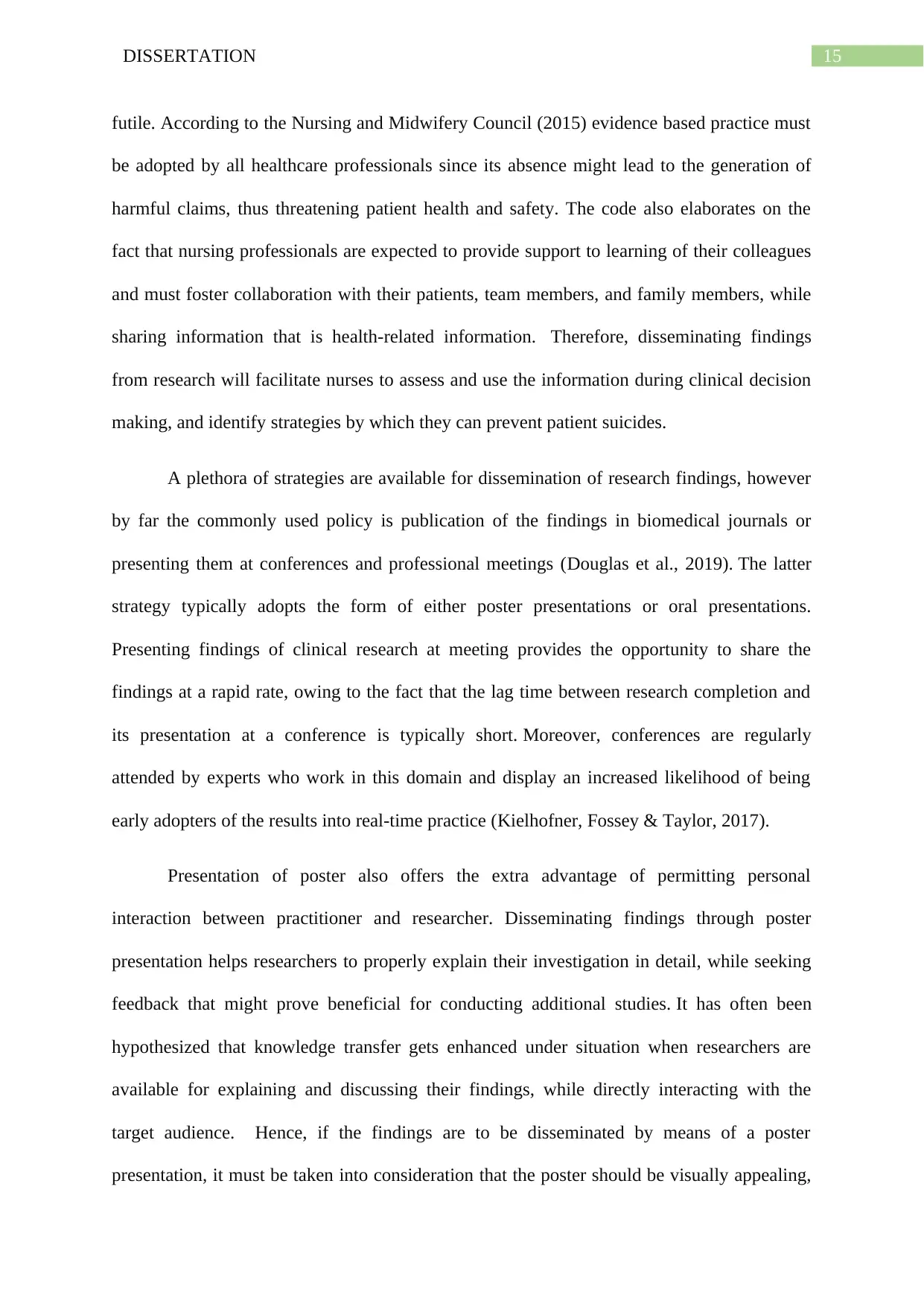
15DISSERTATION
futile. According to the Nursing and Midwifery Council (2015) evidence based practice must
be adopted by all healthcare professionals since its absence might lead to the generation of
harmful claims, thus threatening patient health and safety. The code also elaborates on the
fact that nursing professionals are expected to provide support to learning of their colleagues
and must foster collaboration with their patients, team members, and family members, while
sharing information that is health-related information. Therefore, disseminating findings
from research will facilitate nurses to assess and use the information during clinical decision
making, and identify strategies by which they can prevent patient suicides.
A plethora of strategies are available for dissemination of research findings, however
by far the commonly used policy is publication of the findings in biomedical journals or
presenting them at conferences and professional meetings (Douglas et al., 2019). The latter
strategy typically adopts the form of either poster presentations or oral presentations.
Presenting findings of clinical research at meeting provides the opportunity to share the
findings at a rapid rate, owing to the fact that the lag time between research completion and
its presentation at a conference is typically short. Moreover, conferences are regularly
attended by experts who work in this domain and display an increased likelihood of being
early adopters of the results into real-time practice (Kielhofner, Fossey & Taylor, 2017).
Presentation of poster also offers the extra advantage of permitting personal
interaction between practitioner and researcher. Disseminating findings through poster
presentation helps researchers to properly explain their investigation in detail, while seeking
feedback that might prove beneficial for conducting additional studies. It has often been
hypothesized that knowledge transfer gets enhanced under situation when researchers are
available for explaining and discussing their findings, while directly interacting with the
target audience. Hence, if the findings are to be disseminated by means of a poster
presentation, it must be taken into consideration that the poster should be visually appealing,
futile. According to the Nursing and Midwifery Council (2015) evidence based practice must
be adopted by all healthcare professionals since its absence might lead to the generation of
harmful claims, thus threatening patient health and safety. The code also elaborates on the
fact that nursing professionals are expected to provide support to learning of their colleagues
and must foster collaboration with their patients, team members, and family members, while
sharing information that is health-related information. Therefore, disseminating findings
from research will facilitate nurses to assess and use the information during clinical decision
making, and identify strategies by which they can prevent patient suicides.
A plethora of strategies are available for dissemination of research findings, however
by far the commonly used policy is publication of the findings in biomedical journals or
presenting them at conferences and professional meetings (Douglas et al., 2019). The latter
strategy typically adopts the form of either poster presentations or oral presentations.
Presenting findings of clinical research at meeting provides the opportunity to share the
findings at a rapid rate, owing to the fact that the lag time between research completion and
its presentation at a conference is typically short. Moreover, conferences are regularly
attended by experts who work in this domain and display an increased likelihood of being
early adopters of the results into real-time practice (Kielhofner, Fossey & Taylor, 2017).
Presentation of poster also offers the extra advantage of permitting personal
interaction between practitioner and researcher. Disseminating findings through poster
presentation helps researchers to properly explain their investigation in detail, while seeking
feedback that might prove beneficial for conducting additional studies. It has often been
hypothesized that knowledge transfer gets enhanced under situation when researchers are
available for explaining and discussing their findings, while directly interacting with the
target audience. Hence, if the findings are to be disseminated by means of a poster
presentation, it must be taken into consideration that the poster should be visually appealing,
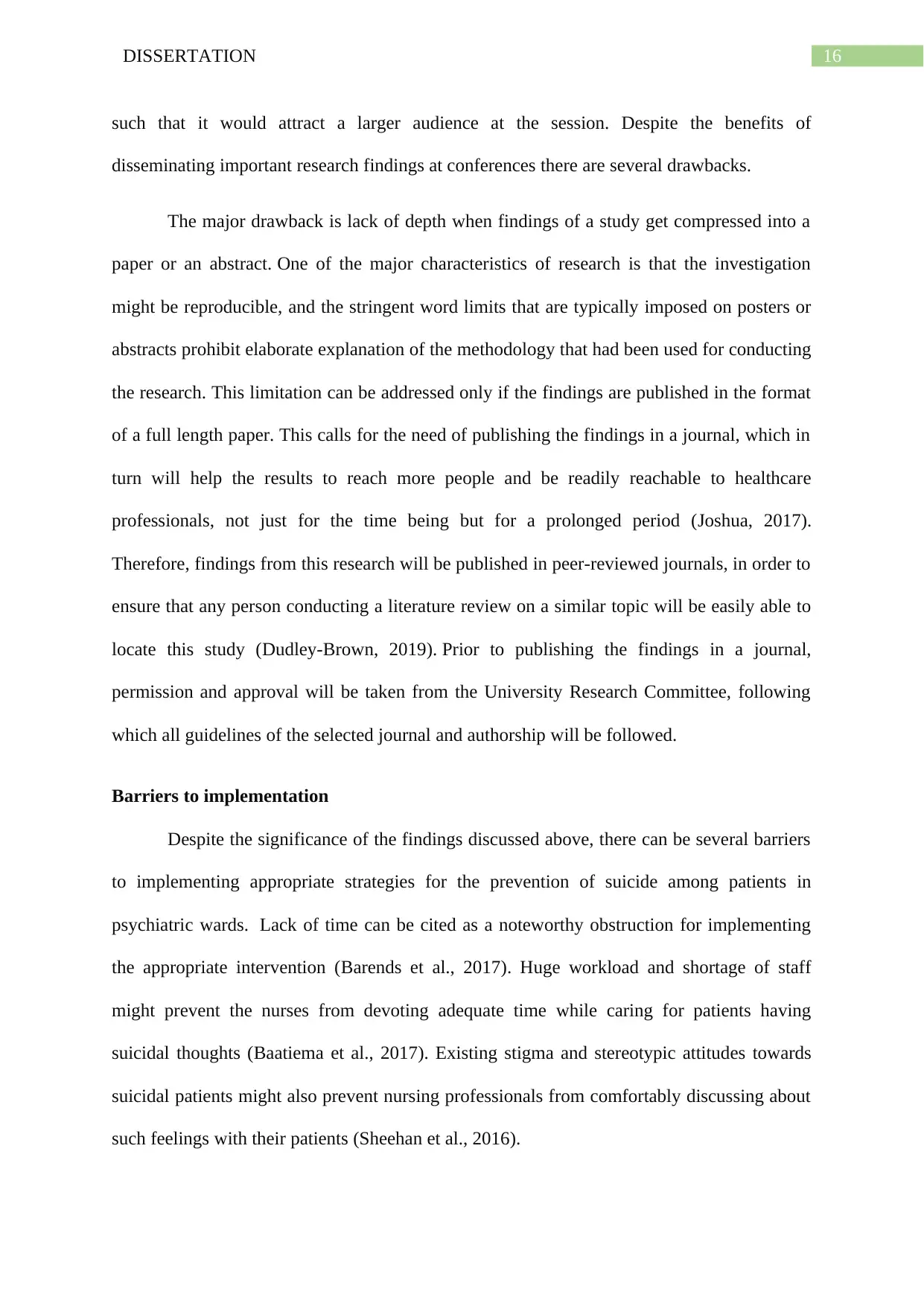
16DISSERTATION
such that it would attract a larger audience at the session. Despite the benefits of
disseminating important research findings at conferences there are several drawbacks.
The major drawback is lack of depth when findings of a study get compressed into a
paper or an abstract. One of the major characteristics of research is that the investigation
might be reproducible, and the stringent word limits that are typically imposed on posters or
abstracts prohibit elaborate explanation of the methodology that had been used for conducting
the research. This limitation can be addressed only if the findings are published in the format
of a full length paper. This calls for the need of publishing the findings in a journal, which in
turn will help the results to reach more people and be readily reachable to healthcare
professionals, not just for the time being but for a prolonged period (Joshua, 2017).
Therefore, findings from this research will be published in peer-reviewed journals, in order to
ensure that any person conducting a literature review on a similar topic will be easily able to
locate this study (Dudley-Brown, 2019). Prior to publishing the findings in a journal,
permission and approval will be taken from the University Research Committee, following
which all guidelines of the selected journal and authorship will be followed.
Barriers to implementation
Despite the significance of the findings discussed above, there can be several barriers
to implementing appropriate strategies for the prevention of suicide among patients in
psychiatric wards. Lack of time can be cited as a noteworthy obstruction for implementing
the appropriate intervention (Barends et al., 2017). Huge workload and shortage of staff
might prevent the nurses from devoting adequate time while caring for patients having
suicidal thoughts (Baatiema et al., 2017). Existing stigma and stereotypic attitudes towards
suicidal patients might also prevent nursing professionals from comfortably discussing about
such feelings with their patients (Sheehan et al., 2016).
such that it would attract a larger audience at the session. Despite the benefits of
disseminating important research findings at conferences there are several drawbacks.
The major drawback is lack of depth when findings of a study get compressed into a
paper or an abstract. One of the major characteristics of research is that the investigation
might be reproducible, and the stringent word limits that are typically imposed on posters or
abstracts prohibit elaborate explanation of the methodology that had been used for conducting
the research. This limitation can be addressed only if the findings are published in the format
of a full length paper. This calls for the need of publishing the findings in a journal, which in
turn will help the results to reach more people and be readily reachable to healthcare
professionals, not just for the time being but for a prolonged period (Joshua, 2017).
Therefore, findings from this research will be published in peer-reviewed journals, in order to
ensure that any person conducting a literature review on a similar topic will be easily able to
locate this study (Dudley-Brown, 2019). Prior to publishing the findings in a journal,
permission and approval will be taken from the University Research Committee, following
which all guidelines of the selected journal and authorship will be followed.
Barriers to implementation
Despite the significance of the findings discussed above, there can be several barriers
to implementing appropriate strategies for the prevention of suicide among patients in
psychiatric wards. Lack of time can be cited as a noteworthy obstruction for implementing
the appropriate intervention (Barends et al., 2017). Huge workload and shortage of staff
might prevent the nurses from devoting adequate time while caring for patients having
suicidal thoughts (Baatiema et al., 2017). Existing stigma and stereotypic attitudes towards
suicidal patients might also prevent nursing professionals from comfortably discussing about
such feelings with their patients (Sheehan et al., 2016).
Paraphrase This Document
Need a fresh take? Get an instant paraphrase of this document with our AI Paraphraser
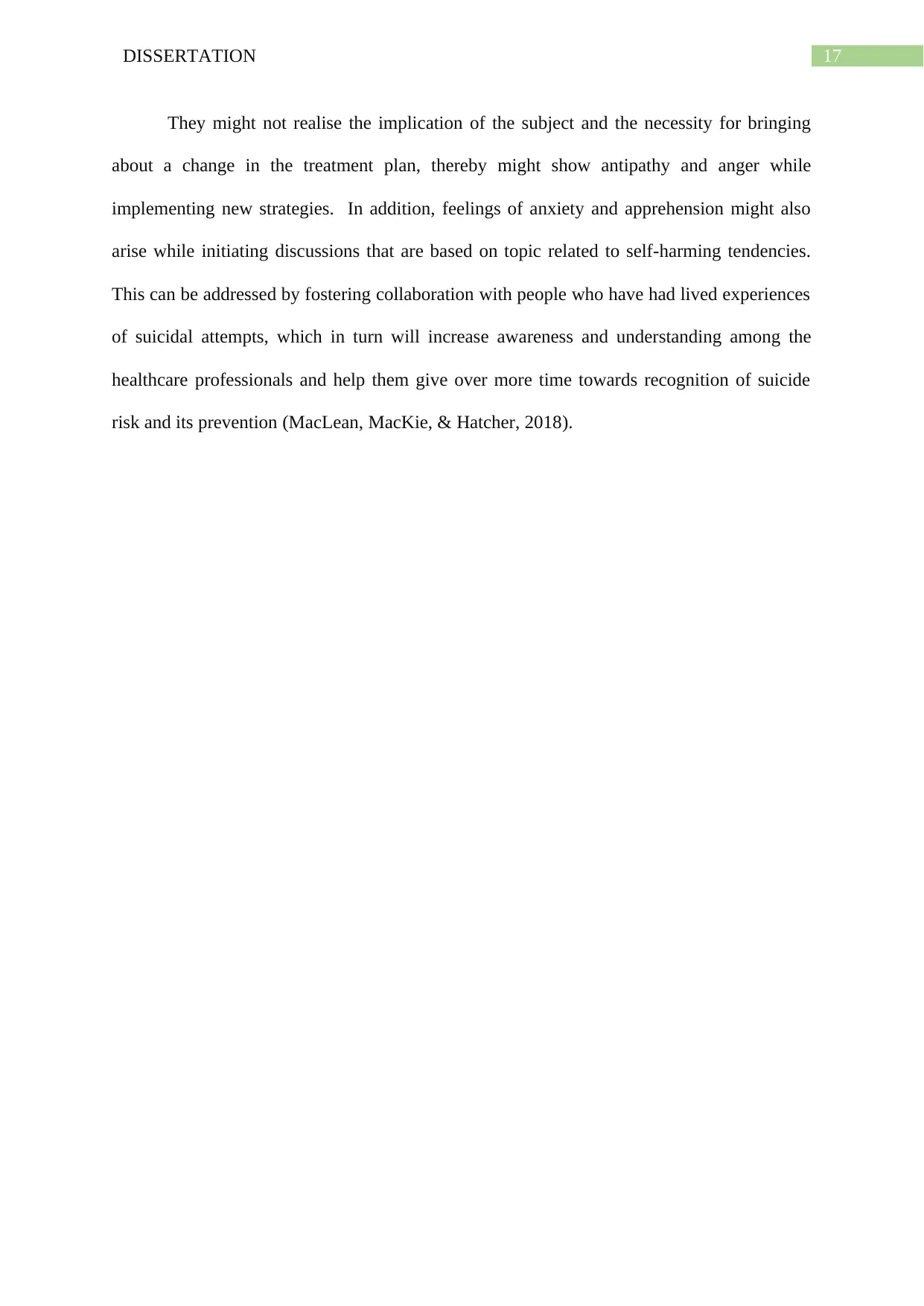
17DISSERTATION
They might not realise the implication of the subject and the necessity for bringing
about a change in the treatment plan, thereby might show antipathy and anger while
implementing new strategies. In addition, feelings of anxiety and apprehension might also
arise while initiating discussions that are based on topic related to self-harming tendencies.
This can be addressed by fostering collaboration with people who have had lived experiences
of suicidal attempts, which in turn will increase awareness and understanding among the
healthcare professionals and help them give over more time towards recognition of suicide
risk and its prevention (MacLean, MacKie, & Hatcher, 2018).
They might not realise the implication of the subject and the necessity for bringing
about a change in the treatment plan, thereby might show antipathy and anger while
implementing new strategies. In addition, feelings of anxiety and apprehension might also
arise while initiating discussions that are based on topic related to self-harming tendencies.
This can be addressed by fostering collaboration with people who have had lived experiences
of suicidal attempts, which in turn will increase awareness and understanding among the
healthcare professionals and help them give over more time towards recognition of suicide
risk and its prevention (MacLean, MacKie, & Hatcher, 2018).
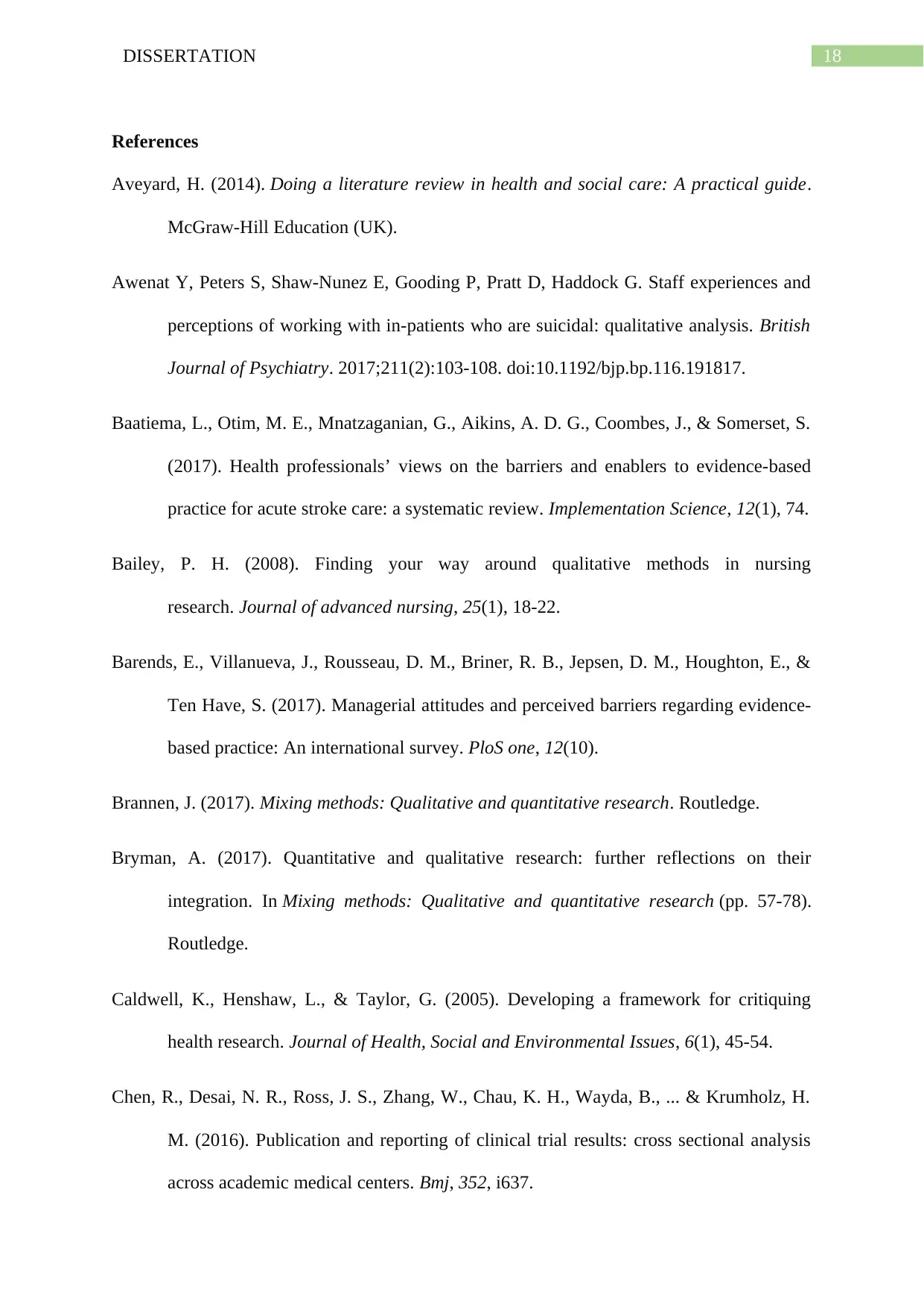
18DISSERTATION
References
Aveyard, H. (2014). Doing a literature review in health and social care: A practical guide.
McGraw-Hill Education (UK).
Awenat Y, Peters S, Shaw-Nunez E, Gooding P, Pratt D, Haddock G. Staff experiences and
perceptions of working with in-patients who are suicidal: qualitative analysis. British
Journal of Psychiatry. 2017;211(2):103-108. doi:10.1192/bjp.bp.116.191817.
Baatiema, L., Otim, M. E., Mnatzaganian, G., Aikins, A. D. G., Coombes, J., & Somerset, S.
(2017). Health professionals’ views on the barriers and enablers to evidence-based
practice for acute stroke care: a systematic review. Implementation Science, 12(1), 74.
Bailey, P. H. (2008). Finding your way around qualitative methods in nursing
research. Journal of advanced nursing, 25(1), 18-22.
Barends, E., Villanueva, J., Rousseau, D. M., Briner, R. B., Jepsen, D. M., Houghton, E., &
Ten Have, S. (2017). Managerial attitudes and perceived barriers regarding evidence-
based practice: An international survey. PloS one, 12(10).
Brannen, J. (2017). Mixing methods: Qualitative and quantitative research. Routledge.
Bryman, A. (2017). Quantitative and qualitative research: further reflections on their
integration. In Mixing methods: Qualitative and quantitative research (pp. 57-78).
Routledge.
Caldwell, K., Henshaw, L., & Taylor, G. (2005). Developing a framework for critiquing
health research. Journal of Health, Social and Environmental Issues, 6(1), 45-54.
Chen, R., Desai, N. R., Ross, J. S., Zhang, W., Chau, K. H., Wayda, B., ... & Krumholz, H.
M. (2016). Publication and reporting of clinical trial results: cross sectional analysis
across academic medical centers. Bmj, 352, i637.
References
Aveyard, H. (2014). Doing a literature review in health and social care: A practical guide.
McGraw-Hill Education (UK).
Awenat Y, Peters S, Shaw-Nunez E, Gooding P, Pratt D, Haddock G. Staff experiences and
perceptions of working with in-patients who are suicidal: qualitative analysis. British
Journal of Psychiatry. 2017;211(2):103-108. doi:10.1192/bjp.bp.116.191817.
Baatiema, L., Otim, M. E., Mnatzaganian, G., Aikins, A. D. G., Coombes, J., & Somerset, S.
(2017). Health professionals’ views on the barriers and enablers to evidence-based
practice for acute stroke care: a systematic review. Implementation Science, 12(1), 74.
Bailey, P. H. (2008). Finding your way around qualitative methods in nursing
research. Journal of advanced nursing, 25(1), 18-22.
Barends, E., Villanueva, J., Rousseau, D. M., Briner, R. B., Jepsen, D. M., Houghton, E., &
Ten Have, S. (2017). Managerial attitudes and perceived barriers regarding evidence-
based practice: An international survey. PloS one, 12(10).
Brannen, J. (2017). Mixing methods: Qualitative and quantitative research. Routledge.
Bryman, A. (2017). Quantitative and qualitative research: further reflections on their
integration. In Mixing methods: Qualitative and quantitative research (pp. 57-78).
Routledge.
Caldwell, K., Henshaw, L., & Taylor, G. (2005). Developing a framework for critiquing
health research. Journal of Health, Social and Environmental Issues, 6(1), 45-54.
Chen, R., Desai, N. R., Ross, J. S., Zhang, W., Chau, K. H., Wayda, B., ... & Krumholz, H.
M. (2016). Publication and reporting of clinical trial results: cross sectional analysis
across academic medical centers. Bmj, 352, i637.
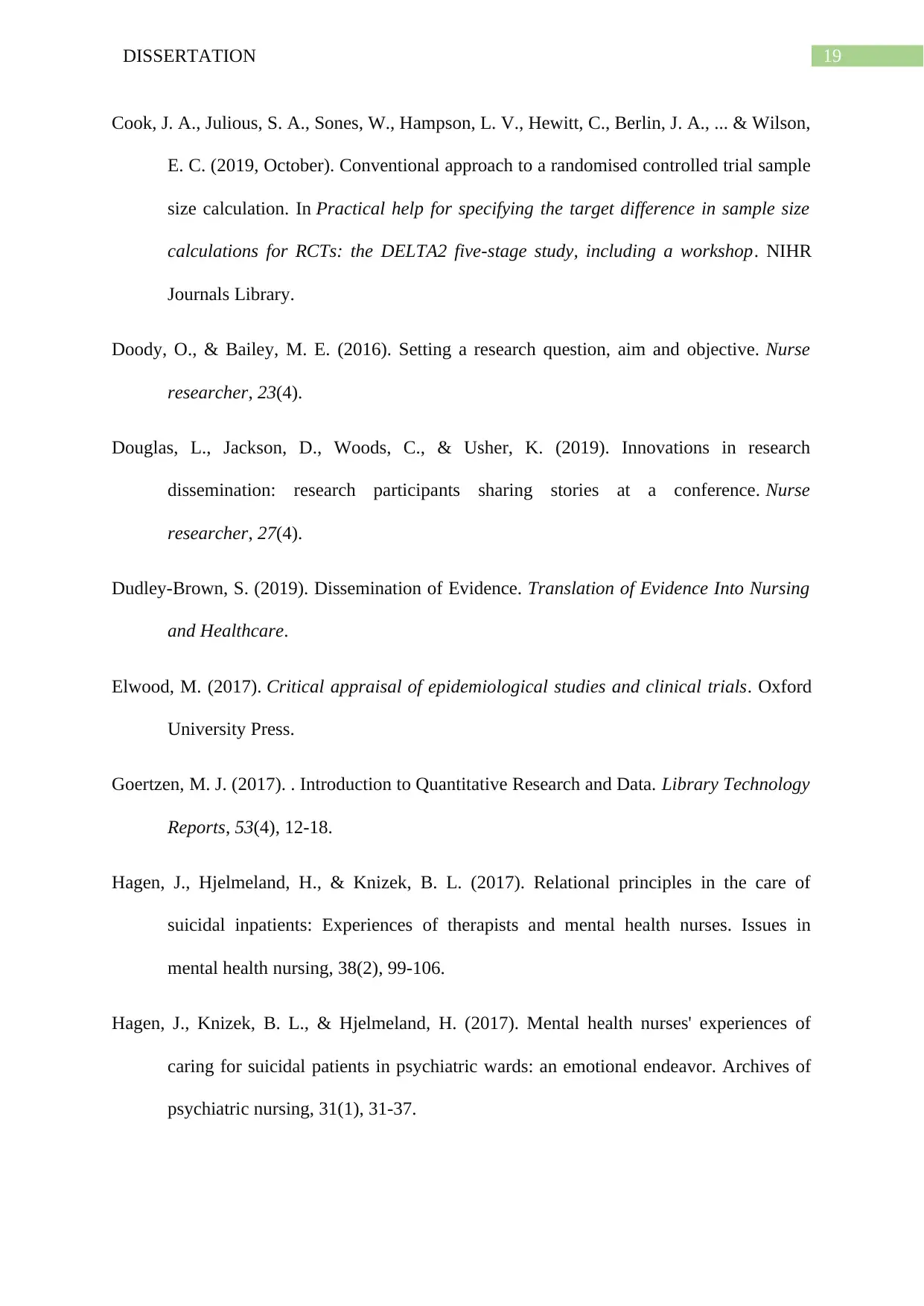
19DISSERTATION
Cook, J. A., Julious, S. A., Sones, W., Hampson, L. V., Hewitt, C., Berlin, J. A., ... & Wilson,
E. C. (2019, October). Conventional approach to a randomised controlled trial sample
size calculation. In Practical help for specifying the target difference in sample size
calculations for RCTs: the DELTA2 five-stage study, including a workshop. NIHR
Journals Library.
Doody, O., & Bailey, M. E. (2016). Setting a research question, aim and objective. Nurse
researcher, 23(4).
Douglas, L., Jackson, D., Woods, C., & Usher, K. (2019). Innovations in research
dissemination: research participants sharing stories at a conference. Nurse
researcher, 27(4).
Dudley-Brown, S. (2019). Dissemination of Evidence. Translation of Evidence Into Nursing
and Healthcare.
Elwood, M. (2017). Critical appraisal of epidemiological studies and clinical trials. Oxford
University Press.
Goertzen, M. J. (2017). . Introduction to Quantitative Research and Data. Library Technology
Reports, 53(4), 12-18.
Hagen, J., Hjelmeland, H., & Knizek, B. L. (2017). Relational principles in the care of
suicidal inpatients: Experiences of therapists and mental health nurses. Issues in
mental health nursing, 38(2), 99-106.
Hagen, J., Knizek, B. L., & Hjelmeland, H. (2017). Mental health nurses' experiences of
caring for suicidal patients in psychiatric wards: an emotional endeavor. Archives of
psychiatric nursing, 31(1), 31-37.
Cook, J. A., Julious, S. A., Sones, W., Hampson, L. V., Hewitt, C., Berlin, J. A., ... & Wilson,
E. C. (2019, October). Conventional approach to a randomised controlled trial sample
size calculation. In Practical help for specifying the target difference in sample size
calculations for RCTs: the DELTA2 five-stage study, including a workshop. NIHR
Journals Library.
Doody, O., & Bailey, M. E. (2016). Setting a research question, aim and objective. Nurse
researcher, 23(4).
Douglas, L., Jackson, D., Woods, C., & Usher, K. (2019). Innovations in research
dissemination: research participants sharing stories at a conference. Nurse
researcher, 27(4).
Dudley-Brown, S. (2019). Dissemination of Evidence. Translation of Evidence Into Nursing
and Healthcare.
Elwood, M. (2017). Critical appraisal of epidemiological studies and clinical trials. Oxford
University Press.
Goertzen, M. J. (2017). . Introduction to Quantitative Research and Data. Library Technology
Reports, 53(4), 12-18.
Hagen, J., Hjelmeland, H., & Knizek, B. L. (2017). Relational principles in the care of
suicidal inpatients: Experiences of therapists and mental health nurses. Issues in
mental health nursing, 38(2), 99-106.
Hagen, J., Knizek, B. L., & Hjelmeland, H. (2017). Mental health nurses' experiences of
caring for suicidal patients in psychiatric wards: an emotional endeavor. Archives of
psychiatric nursing, 31(1), 31-37.
Secure Best Marks with AI Grader
Need help grading? Try our AI Grader for instant feedback on your assignments.
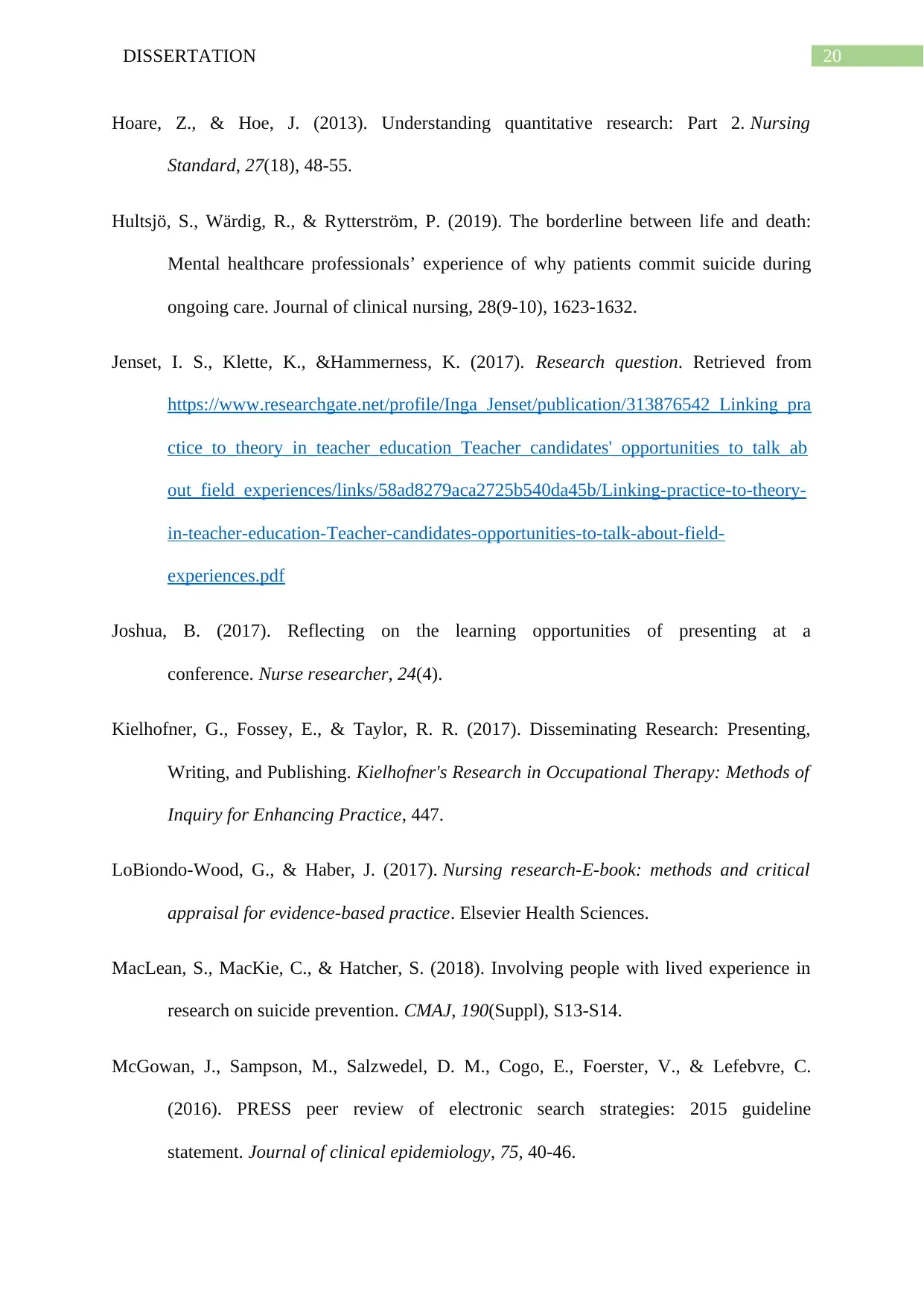
20DISSERTATION
Hoare, Z., & Hoe, J. (2013). Understanding quantitative research: Part 2. Nursing
Standard, 27(18), 48-55.
Hultsjö, S., Wärdig, R., & Rytterström, P. (2019). The borderline between life and death:
Mental healthcare professionals’ experience of why patients commit suicide during
ongoing care. Journal of clinical nursing, 28(9-10), 1623-1632.
Jenset, I. S., Klette, K., &Hammerness, K. (2017). Research question. Retrieved from
https://www.researchgate.net/profile/Inga_Jenset/publication/313876542_Linking_pra
ctice_to_theory_in_teacher_education_Teacher_candidates'_opportunities_to_talk_ab
out_field_experiences/links/58ad8279aca2725b540da45b/Linking-practice-to-theory-
in-teacher-education-Teacher-candidates-opportunities-to-talk-about-field-
experiences.pdf
Joshua, B. (2017). Reflecting on the learning opportunities of presenting at a
conference. Nurse researcher, 24(4).
Kielhofner, G., Fossey, E., & Taylor, R. R. (2017). Disseminating Research: Presenting,
Writing, and Publishing. Kielhofner's Research in Occupational Therapy: Methods of
Inquiry for Enhancing Practice, 447.
LoBiondo-Wood, G., & Haber, J. (2017). Nursing research-E-book: methods and critical
appraisal for evidence-based practice. Elsevier Health Sciences.
MacLean, S., MacKie, C., & Hatcher, S. (2018). Involving people with lived experience in
research on suicide prevention. CMAJ, 190(Suppl), S13-S14.
McGowan, J., Sampson, M., Salzwedel, D. M., Cogo, E., Foerster, V., & Lefebvre, C.
(2016). PRESS peer review of electronic search strategies: 2015 guideline
statement. Journal of clinical epidemiology, 75, 40-46.
Hoare, Z., & Hoe, J. (2013). Understanding quantitative research: Part 2. Nursing
Standard, 27(18), 48-55.
Hultsjö, S., Wärdig, R., & Rytterström, P. (2019). The borderline between life and death:
Mental healthcare professionals’ experience of why patients commit suicide during
ongoing care. Journal of clinical nursing, 28(9-10), 1623-1632.
Jenset, I. S., Klette, K., &Hammerness, K. (2017). Research question. Retrieved from
https://www.researchgate.net/profile/Inga_Jenset/publication/313876542_Linking_pra
ctice_to_theory_in_teacher_education_Teacher_candidates'_opportunities_to_talk_ab
out_field_experiences/links/58ad8279aca2725b540da45b/Linking-practice-to-theory-
in-teacher-education-Teacher-candidates-opportunities-to-talk-about-field-
experiences.pdf
Joshua, B. (2017). Reflecting on the learning opportunities of presenting at a
conference. Nurse researcher, 24(4).
Kielhofner, G., Fossey, E., & Taylor, R. R. (2017). Disseminating Research: Presenting,
Writing, and Publishing. Kielhofner's Research in Occupational Therapy: Methods of
Inquiry for Enhancing Practice, 447.
LoBiondo-Wood, G., & Haber, J. (2017). Nursing research-E-book: methods and critical
appraisal for evidence-based practice. Elsevier Health Sciences.
MacLean, S., MacKie, C., & Hatcher, S. (2018). Involving people with lived experience in
research on suicide prevention. CMAJ, 190(Suppl), S13-S14.
McGowan, J., Sampson, M., Salzwedel, D. M., Cogo, E., Foerster, V., & Lefebvre, C.
(2016). PRESS peer review of electronic search strategies: 2015 guideline
statement. Journal of clinical epidemiology, 75, 40-46.
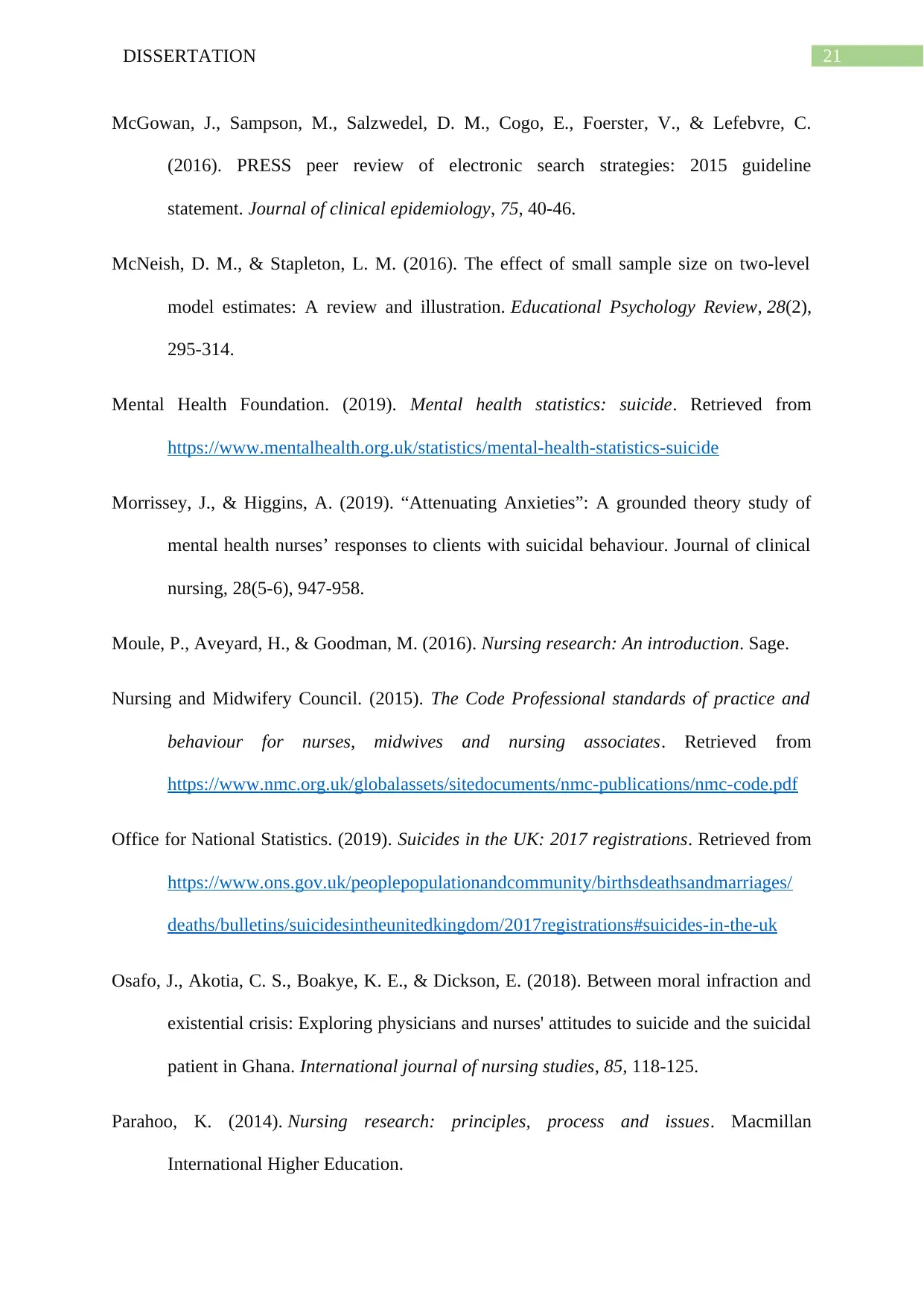
21DISSERTATION
McGowan, J., Sampson, M., Salzwedel, D. M., Cogo, E., Foerster, V., & Lefebvre, C.
(2016). PRESS peer review of electronic search strategies: 2015 guideline
statement. Journal of clinical epidemiology, 75, 40-46.
McNeish, D. M., & Stapleton, L. M. (2016). The effect of small sample size on two-level
model estimates: A review and illustration. Educational Psychology Review, 28(2),
295-314.
Mental Health Foundation. (2019). Mental health statistics: suicide. Retrieved from
https://www.mentalhealth.org.uk/statistics/mental-health-statistics-suicide
Morrissey, J., & Higgins, A. (2019). “Attenuating Anxieties”: A grounded theory study of
mental health nurses’ responses to clients with suicidal behaviour. Journal of clinical
nursing, 28(5-6), 947-958.
Moule, P., Aveyard, H., & Goodman, M. (2016). Nursing research: An introduction. Sage.
Nursing and Midwifery Council. (2015). The Code Professional standards of practice and
behaviour for nurses, midwives and nursing associates. Retrieved from
https://www.nmc.org.uk/globalassets/sitedocuments/nmc-publications/nmc-code.pdf
Office for National Statistics. (2019). Suicides in the UK: 2017 registrations. Retrieved from
https://www.ons.gov.uk/peoplepopulationandcommunity/birthsdeathsandmarriages/
deaths/bulletins/suicidesintheunitedkingdom/2017registrations#suicides-in-the-uk
Osafo, J., Akotia, C. S., Boakye, K. E., & Dickson, E. (2018). Between moral infraction and
existential crisis: Exploring physicians and nurses' attitudes to suicide and the suicidal
patient in Ghana. International journal of nursing studies, 85, 118-125.
Parahoo, K. (2014). Nursing research: principles, process and issues. Macmillan
International Higher Education.
McGowan, J., Sampson, M., Salzwedel, D. M., Cogo, E., Foerster, V., & Lefebvre, C.
(2016). PRESS peer review of electronic search strategies: 2015 guideline
statement. Journal of clinical epidemiology, 75, 40-46.
McNeish, D. M., & Stapleton, L. M. (2016). The effect of small sample size on two-level
model estimates: A review and illustration. Educational Psychology Review, 28(2),
295-314.
Mental Health Foundation. (2019). Mental health statistics: suicide. Retrieved from
https://www.mentalhealth.org.uk/statistics/mental-health-statistics-suicide
Morrissey, J., & Higgins, A. (2019). “Attenuating Anxieties”: A grounded theory study of
mental health nurses’ responses to clients with suicidal behaviour. Journal of clinical
nursing, 28(5-6), 947-958.
Moule, P., Aveyard, H., & Goodman, M. (2016). Nursing research: An introduction. Sage.
Nursing and Midwifery Council. (2015). The Code Professional standards of practice and
behaviour for nurses, midwives and nursing associates. Retrieved from
https://www.nmc.org.uk/globalassets/sitedocuments/nmc-publications/nmc-code.pdf
Office for National Statistics. (2019). Suicides in the UK: 2017 registrations. Retrieved from
https://www.ons.gov.uk/peoplepopulationandcommunity/birthsdeathsandmarriages/
deaths/bulletins/suicidesintheunitedkingdom/2017registrations#suicides-in-the-uk
Osafo, J., Akotia, C. S., Boakye, K. E., & Dickson, E. (2018). Between moral infraction and
existential crisis: Exploring physicians and nurses' attitudes to suicide and the suicidal
patient in Ghana. International journal of nursing studies, 85, 118-125.
Parahoo, K. (2014). Nursing research: principles, process and issues. Macmillan
International Higher Education.
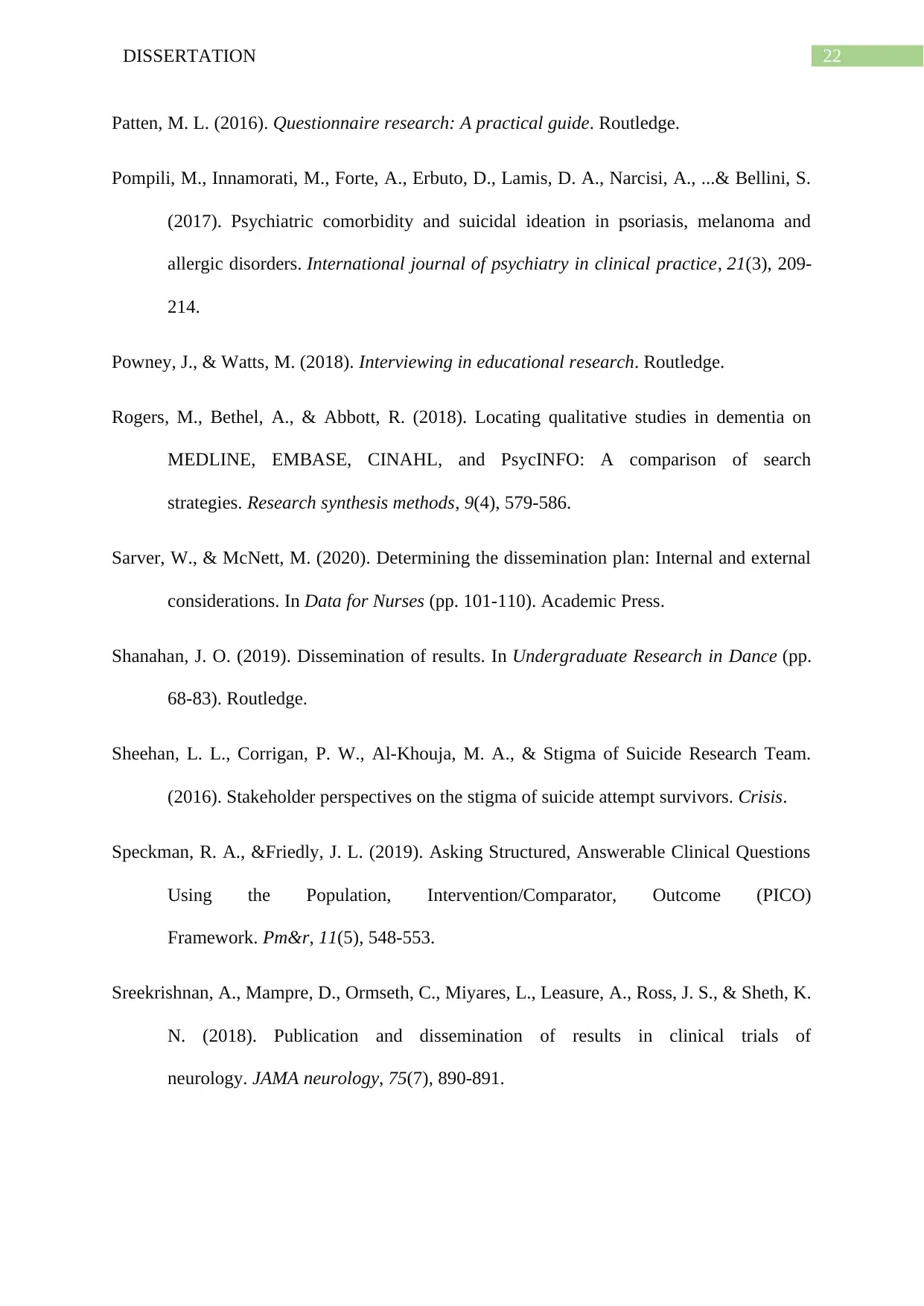
22DISSERTATION
Patten, M. L. (2016). Questionnaire research: A practical guide. Routledge.
Pompili, M., Innamorati, M., Forte, A., Erbuto, D., Lamis, D. A., Narcisi, A., ...& Bellini, S.
(2017). Psychiatric comorbidity and suicidal ideation in psoriasis, melanoma and
allergic disorders. International journal of psychiatry in clinical practice, 21(3), 209-
214.
Powney, J., & Watts, M. (2018). Interviewing in educational research. Routledge.
Rogers, M., Bethel, A., & Abbott, R. (2018). Locating qualitative studies in dementia on
MEDLINE, EMBASE, CINAHL, and PsycINFO: A comparison of search
strategies. Research synthesis methods, 9(4), 579-586.
Sarver, W., & McNett, M. (2020). Determining the dissemination plan: Internal and external
considerations. In Data for Nurses (pp. 101-110). Academic Press.
Shanahan, J. O. (2019). Dissemination of results. In Undergraduate Research in Dance (pp.
68-83). Routledge.
Sheehan, L. L., Corrigan, P. W., Al-Khouja, M. A., & Stigma of Suicide Research Team.
(2016). Stakeholder perspectives on the stigma of suicide attempt survivors. Crisis.
Speckman, R. A., &Friedly, J. L. (2019). Asking Structured, Answerable Clinical Questions
Using the Population, Intervention/Comparator, Outcome (PICO)
Framework. Pm&r, 11(5), 548-553.
Sreekrishnan, A., Mampre, D., Ormseth, C., Miyares, L., Leasure, A., Ross, J. S., & Sheth, K.
N. (2018). Publication and dissemination of results in clinical trials of
neurology. JAMA neurology, 75(7), 890-891.
Patten, M. L. (2016). Questionnaire research: A practical guide. Routledge.
Pompili, M., Innamorati, M., Forte, A., Erbuto, D., Lamis, D. A., Narcisi, A., ...& Bellini, S.
(2017). Psychiatric comorbidity and suicidal ideation in psoriasis, melanoma and
allergic disorders. International journal of psychiatry in clinical practice, 21(3), 209-
214.
Powney, J., & Watts, M. (2018). Interviewing in educational research. Routledge.
Rogers, M., Bethel, A., & Abbott, R. (2018). Locating qualitative studies in dementia on
MEDLINE, EMBASE, CINAHL, and PsycINFO: A comparison of search
strategies. Research synthesis methods, 9(4), 579-586.
Sarver, W., & McNett, M. (2020). Determining the dissemination plan: Internal and external
considerations. In Data for Nurses (pp. 101-110). Academic Press.
Shanahan, J. O. (2019). Dissemination of results. In Undergraduate Research in Dance (pp.
68-83). Routledge.
Sheehan, L. L., Corrigan, P. W., Al-Khouja, M. A., & Stigma of Suicide Research Team.
(2016). Stakeholder perspectives on the stigma of suicide attempt survivors. Crisis.
Speckman, R. A., &Friedly, J. L. (2019). Asking Structured, Answerable Clinical Questions
Using the Population, Intervention/Comparator, Outcome (PICO)
Framework. Pm&r, 11(5), 548-553.
Sreekrishnan, A., Mampre, D., Ormseth, C., Miyares, L., Leasure, A., Ross, J. S., & Sheth, K.
N. (2018). Publication and dissemination of results in clinical trials of
neurology. JAMA neurology, 75(7), 890-891.
Paraphrase This Document
Need a fresh take? Get an instant paraphrase of this document with our AI Paraphraser
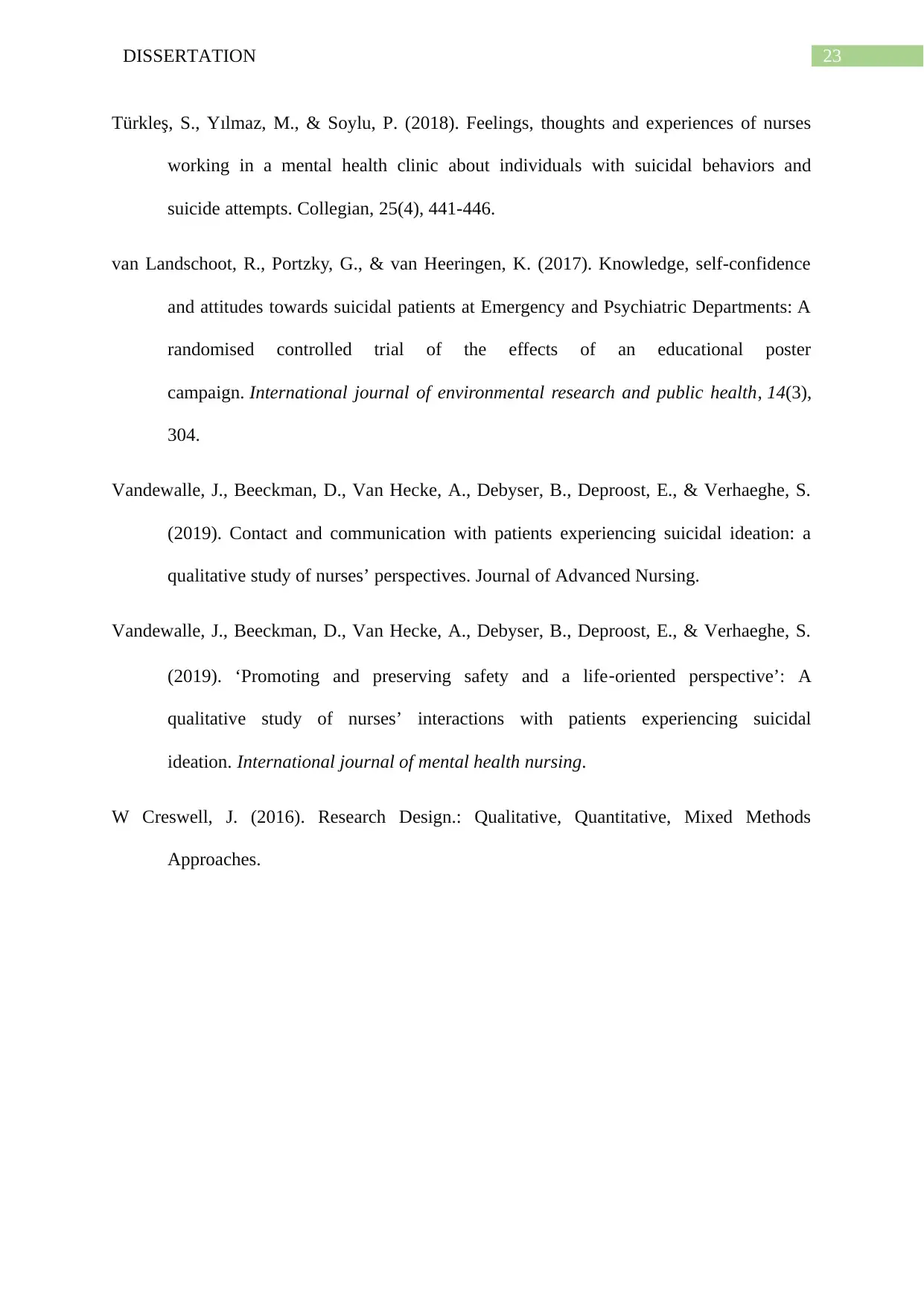
23DISSERTATION
Türkleş, S., Yılmaz, M., & Soylu, P. (2018). Feelings, thoughts and experiences of nurses
working in a mental health clinic about individuals with suicidal behaviors and
suicide attempts. Collegian, 25(4), 441-446.
van Landschoot, R., Portzky, G., & van Heeringen, K. (2017). Knowledge, self-confidence
and attitudes towards suicidal patients at Emergency and Psychiatric Departments: A
randomised controlled trial of the effects of an educational poster
campaign. International journal of environmental research and public health, 14(3),
304.
Vandewalle, J., Beeckman, D., Van Hecke, A., Debyser, B., Deproost, E., & Verhaeghe, S.
(2019). Contact and communication with patients experiencing suicidal ideation: a
qualitative study of nurses’ perspectives. Journal of Advanced Nursing.
Vandewalle, J., Beeckman, D., Van Hecke, A., Debyser, B., Deproost, E., & Verhaeghe, S.
(2019). ‘Promoting and preserving safety and a life‐oriented perspective’: A
qualitative study of nurses’ interactions with patients experiencing suicidal
ideation. International journal of mental health nursing.
W Creswell, J. (2016). Research Design.: Qualitative, Quantitative, Mixed Methods
Approaches.
Türkleş, S., Yılmaz, M., & Soylu, P. (2018). Feelings, thoughts and experiences of nurses
working in a mental health clinic about individuals with suicidal behaviors and
suicide attempts. Collegian, 25(4), 441-446.
van Landschoot, R., Portzky, G., & van Heeringen, K. (2017). Knowledge, self-confidence
and attitudes towards suicidal patients at Emergency and Psychiatric Departments: A
randomised controlled trial of the effects of an educational poster
campaign. International journal of environmental research and public health, 14(3),
304.
Vandewalle, J., Beeckman, D., Van Hecke, A., Debyser, B., Deproost, E., & Verhaeghe, S.
(2019). Contact and communication with patients experiencing suicidal ideation: a
qualitative study of nurses’ perspectives. Journal of Advanced Nursing.
Vandewalle, J., Beeckman, D., Van Hecke, A., Debyser, B., Deproost, E., & Verhaeghe, S.
(2019). ‘Promoting and preserving safety and a life‐oriented perspective’: A
qualitative study of nurses’ interactions with patients experiencing suicidal
ideation. International journal of mental health nursing.
W Creswell, J. (2016). Research Design.: Qualitative, Quantitative, Mixed Methods
Approaches.
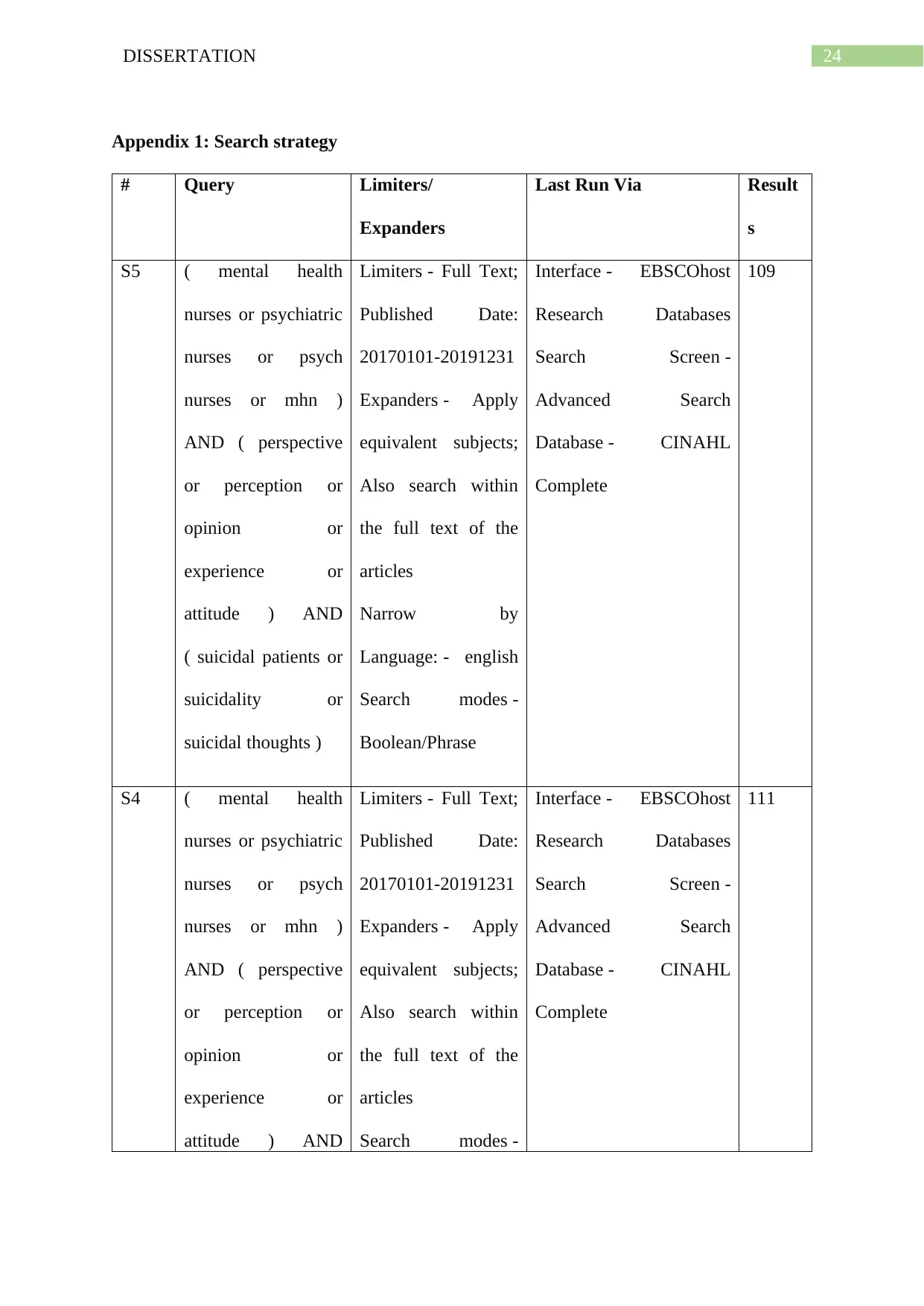
24DISSERTATION
Appendix 1: Search strategy
# Query Limiters/
Expanders
Last Run Via Result
s
S5 ( mental health
nurses or psychiatric
nurses or psych
nurses or mhn )
AND ( perspective
or perception or
opinion or
experience or
attitude ) AND
( suicidal patients or
suicidality or
suicidal thoughts )
Limiters - Full Text;
Published Date:
20170101-20191231
Expanders - Apply
equivalent subjects;
Also search within
the full text of the
articles
Narrow by
Language: - english
Search modes -
Boolean/Phrase
Interface - EBSCOhost
Research Databases
Search Screen -
Advanced Search
Database - CINAHL
Complete
109
S4 ( mental health
nurses or psychiatric
nurses or psych
nurses or mhn )
AND ( perspective
or perception or
opinion or
experience or
attitude ) AND
Limiters - Full Text;
Published Date:
20170101-20191231
Expanders - Apply
equivalent subjects;
Also search within
the full text of the
articles
Search modes -
Interface - EBSCOhost
Research Databases
Search Screen -
Advanced Search
Database - CINAHL
Complete
111
Appendix 1: Search strategy
# Query Limiters/
Expanders
Last Run Via Result
s
S5 ( mental health
nurses or psychiatric
nurses or psych
nurses or mhn )
AND ( perspective
or perception or
opinion or
experience or
attitude ) AND
( suicidal patients or
suicidality or
suicidal thoughts )
Limiters - Full Text;
Published Date:
20170101-20191231
Expanders - Apply
equivalent subjects;
Also search within
the full text of the
articles
Narrow by
Language: - english
Search modes -
Boolean/Phrase
Interface - EBSCOhost
Research Databases
Search Screen -
Advanced Search
Database - CINAHL
Complete
109
S4 ( mental health
nurses or psychiatric
nurses or psych
nurses or mhn )
AND ( perspective
or perception or
opinion or
experience or
attitude ) AND
Limiters - Full Text;
Published Date:
20170101-20191231
Expanders - Apply
equivalent subjects;
Also search within
the full text of the
articles
Search modes -
Interface - EBSCOhost
Research Databases
Search Screen -
Advanced Search
Database - CINAHL
Complete
111
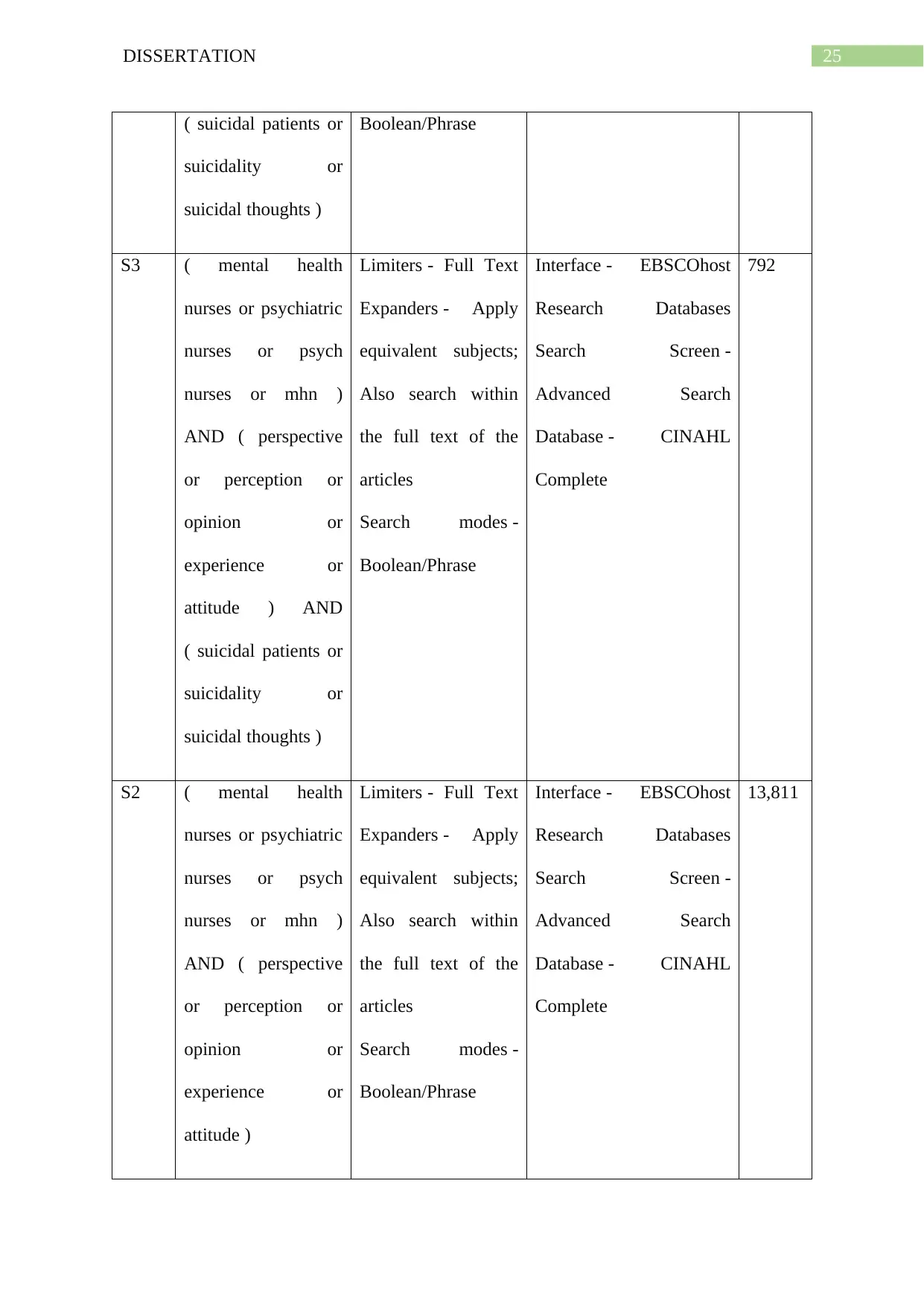
25DISSERTATION
( suicidal patients or
suicidality or
suicidal thoughts )
Boolean/Phrase
S3 ( mental health
nurses or psychiatric
nurses or psych
nurses or mhn )
AND ( perspective
or perception or
opinion or
experience or
attitude ) AND
( suicidal patients or
suicidality or
suicidal thoughts )
Limiters - Full Text
Expanders - Apply
equivalent subjects;
Also search within
the full text of the
articles
Search modes -
Boolean/Phrase
Interface - EBSCOhost
Research Databases
Search Screen -
Advanced Search
Database - CINAHL
Complete
792
S2 ( mental health
nurses or psychiatric
nurses or psych
nurses or mhn )
AND ( perspective
or perception or
opinion or
experience or
attitude )
Limiters - Full Text
Expanders - Apply
equivalent subjects;
Also search within
the full text of the
articles
Search modes -
Boolean/Phrase
Interface - EBSCOhost
Research Databases
Search Screen -
Advanced Search
Database - CINAHL
Complete
13,811
( suicidal patients or
suicidality or
suicidal thoughts )
Boolean/Phrase
S3 ( mental health
nurses or psychiatric
nurses or psych
nurses or mhn )
AND ( perspective
or perception or
opinion or
experience or
attitude ) AND
( suicidal patients or
suicidality or
suicidal thoughts )
Limiters - Full Text
Expanders - Apply
equivalent subjects;
Also search within
the full text of the
articles
Search modes -
Boolean/Phrase
Interface - EBSCOhost
Research Databases
Search Screen -
Advanced Search
Database - CINAHL
Complete
792
S2 ( mental health
nurses or psychiatric
nurses or psych
nurses or mhn )
AND ( perspective
or perception or
opinion or
experience or
attitude )
Limiters - Full Text
Expanders - Apply
equivalent subjects;
Also search within
the full text of the
articles
Search modes -
Boolean/Phrase
Interface - EBSCOhost
Research Databases
Search Screen -
Advanced Search
Database - CINAHL
Complete
13,811
Secure Best Marks with AI Grader
Need help grading? Try our AI Grader for instant feedback on your assignments.
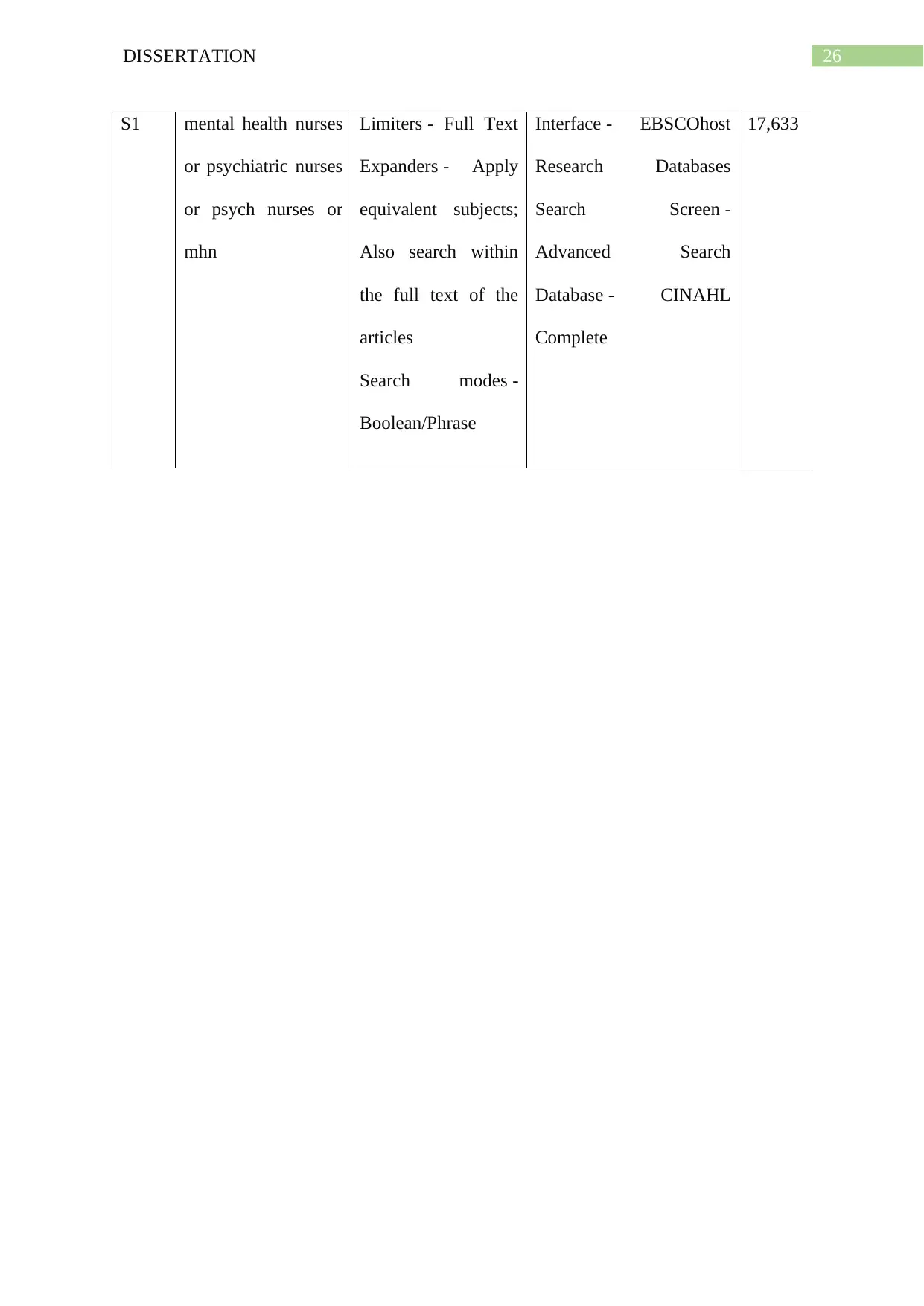
26DISSERTATION
S1 mental health nurses
or psychiatric nurses
or psych nurses or
mhn
Limiters - Full Text
Expanders - Apply
equivalent subjects;
Also search within
the full text of the
articles
Search modes -
Boolean/Phrase
Interface - EBSCOhost
Research Databases
Search Screen -
Advanced Search
Database - CINAHL
Complete
17,633
S1 mental health nurses
or psychiatric nurses
or psych nurses or
mhn
Limiters - Full Text
Expanders - Apply
equivalent subjects;
Also search within
the full text of the
articles
Search modes -
Boolean/Phrase
Interface - EBSCOhost
Research Databases
Search Screen -
Advanced Search
Database - CINAHL
Complete
17,633
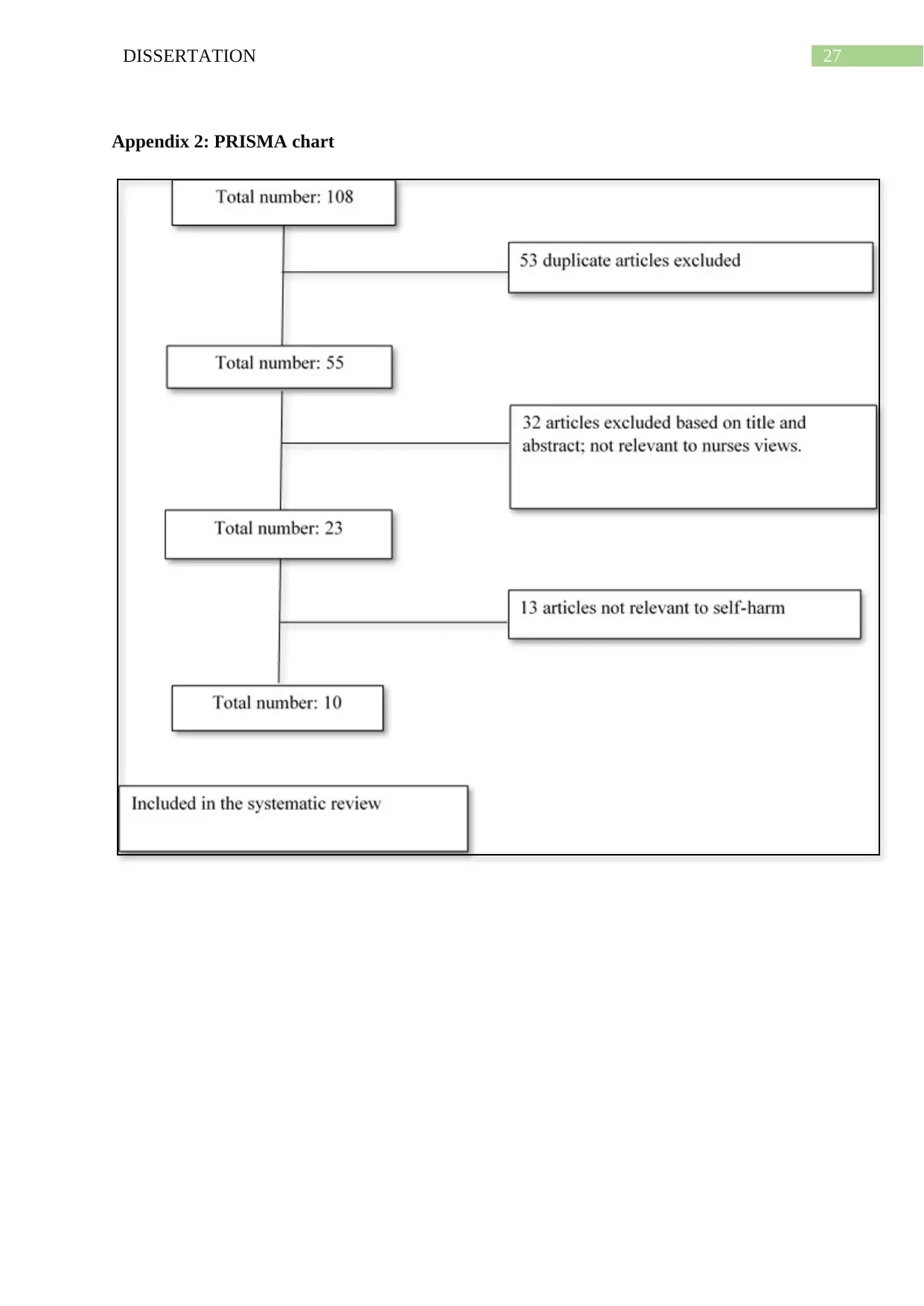
27DISSERTATION
Appendix 2: PRISMA chart
Appendix 2: PRISMA chart
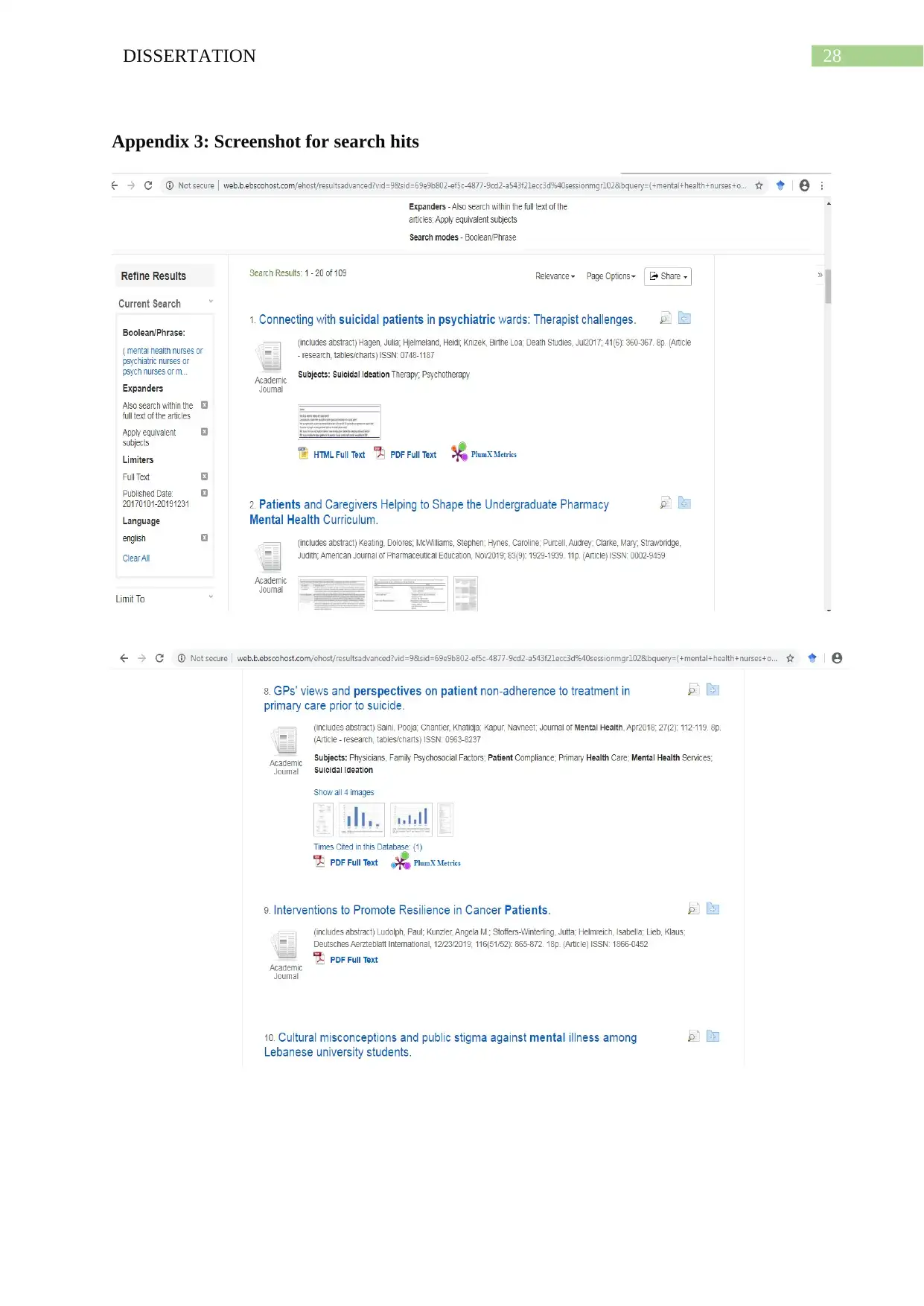
28DISSERTATION
Appendix 3: Screenshot for search hits
Appendix 3: Screenshot for search hits
Paraphrase This Document
Need a fresh take? Get an instant paraphrase of this document with our AI Paraphraser

29DISSERTATION
Appendix 4: Caldwell framework
Appendix 4: Caldwell framework
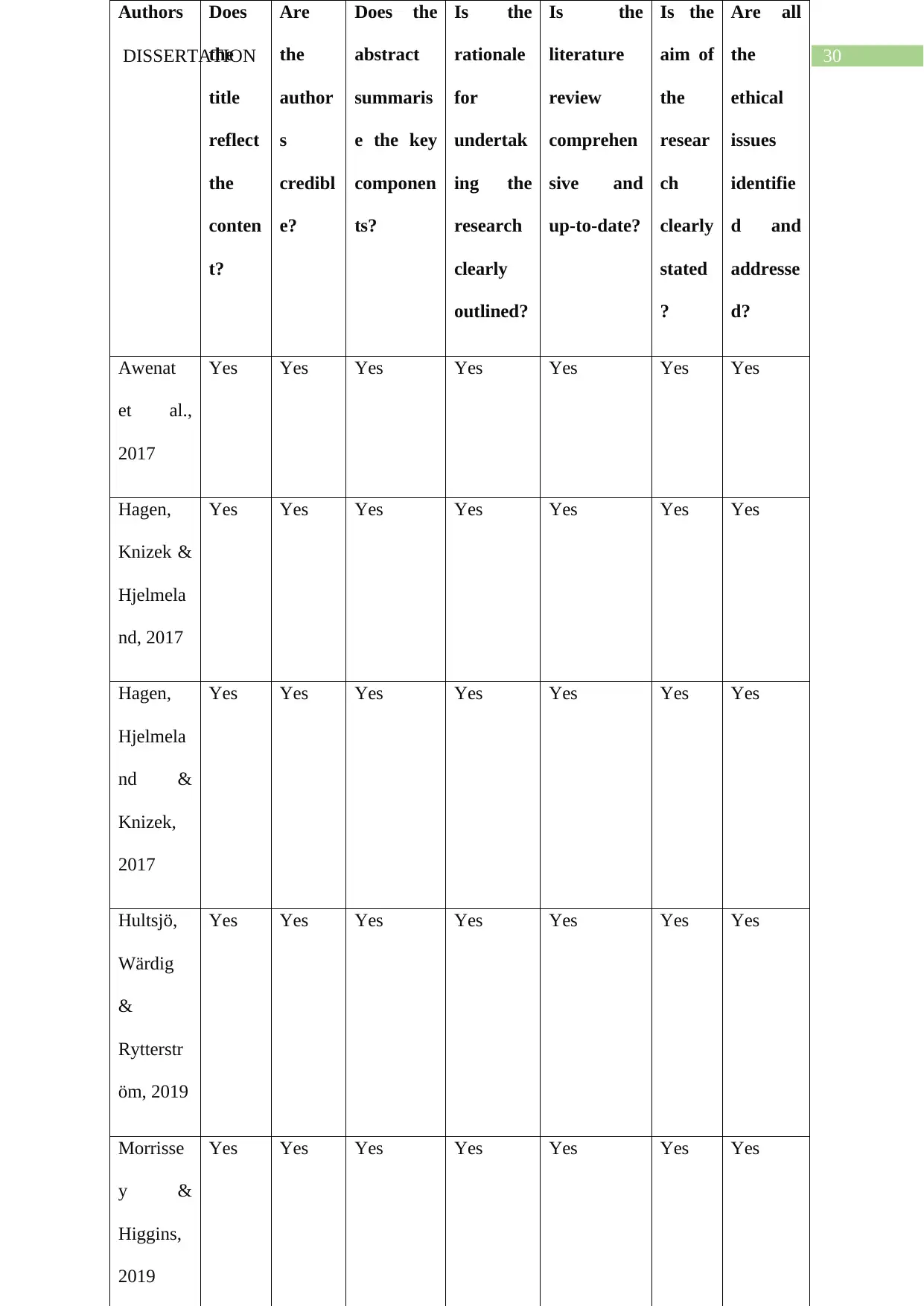
30DISSERTATION
Authors Does
the
title
reflect
the
conten
t?
Are
the
author
s
credibl
e?
Does the
abstract
summaris
e the key
componen
ts?
Is the
rationale
for
undertak
ing the
research
clearly
outlined?
Is the
literature
review
comprehen
sive and
up-to-date?
Is the
aim of
the
resear
ch
clearly
stated
?
Are all
the
ethical
issues
identifie
d and
addresse
d?
Awenat
et al.,
2017
Yes Yes Yes Yes Yes Yes Yes
Hagen,
Knizek &
Hjelmela
nd, 2017
Yes Yes Yes Yes Yes Yes Yes
Hagen,
Hjelmela
nd &
Knizek,
2017
Yes Yes Yes Yes Yes Yes Yes
Hultsjö,
Wärdig
&
Rytterstr
öm, 2019
Yes Yes Yes Yes Yes Yes Yes
Morrisse
y &
Higgins,
2019
Yes Yes Yes Yes Yes Yes Yes
Authors Does
the
title
reflect
the
conten
t?
Are
the
author
s
credibl
e?
Does the
abstract
summaris
e the key
componen
ts?
Is the
rationale
for
undertak
ing the
research
clearly
outlined?
Is the
literature
review
comprehen
sive and
up-to-date?
Is the
aim of
the
resear
ch
clearly
stated
?
Are all
the
ethical
issues
identifie
d and
addresse
d?
Awenat
et al.,
2017
Yes Yes Yes Yes Yes Yes Yes
Hagen,
Knizek &
Hjelmela
nd, 2017
Yes Yes Yes Yes Yes Yes Yes
Hagen,
Hjelmela
nd &
Knizek,
2017
Yes Yes Yes Yes Yes Yes Yes
Hultsjö,
Wärdig
&
Rytterstr
öm, 2019
Yes Yes Yes Yes Yes Yes Yes
Morrisse
y &
Higgins,
2019
Yes Yes Yes Yes Yes Yes Yes
1 out of 45
Related Documents
Your All-in-One AI-Powered Toolkit for Academic Success.
+13062052269
info@desklib.com
Available 24*7 on WhatsApp / Email
![[object Object]](/_next/static/media/star-bottom.7253800d.svg)
Unlock your academic potential
© 2024 | Zucol Services PVT LTD | All rights reserved.





